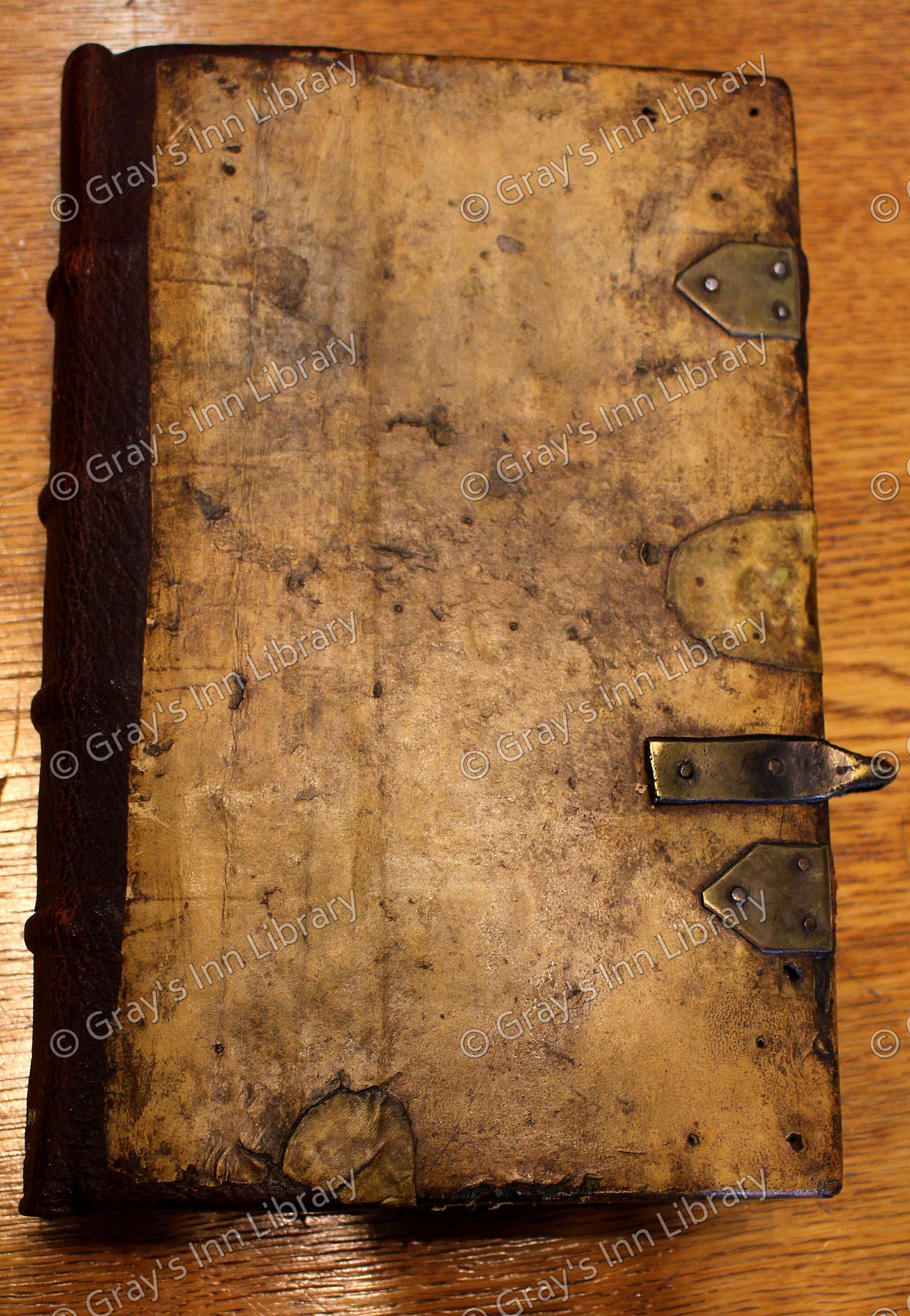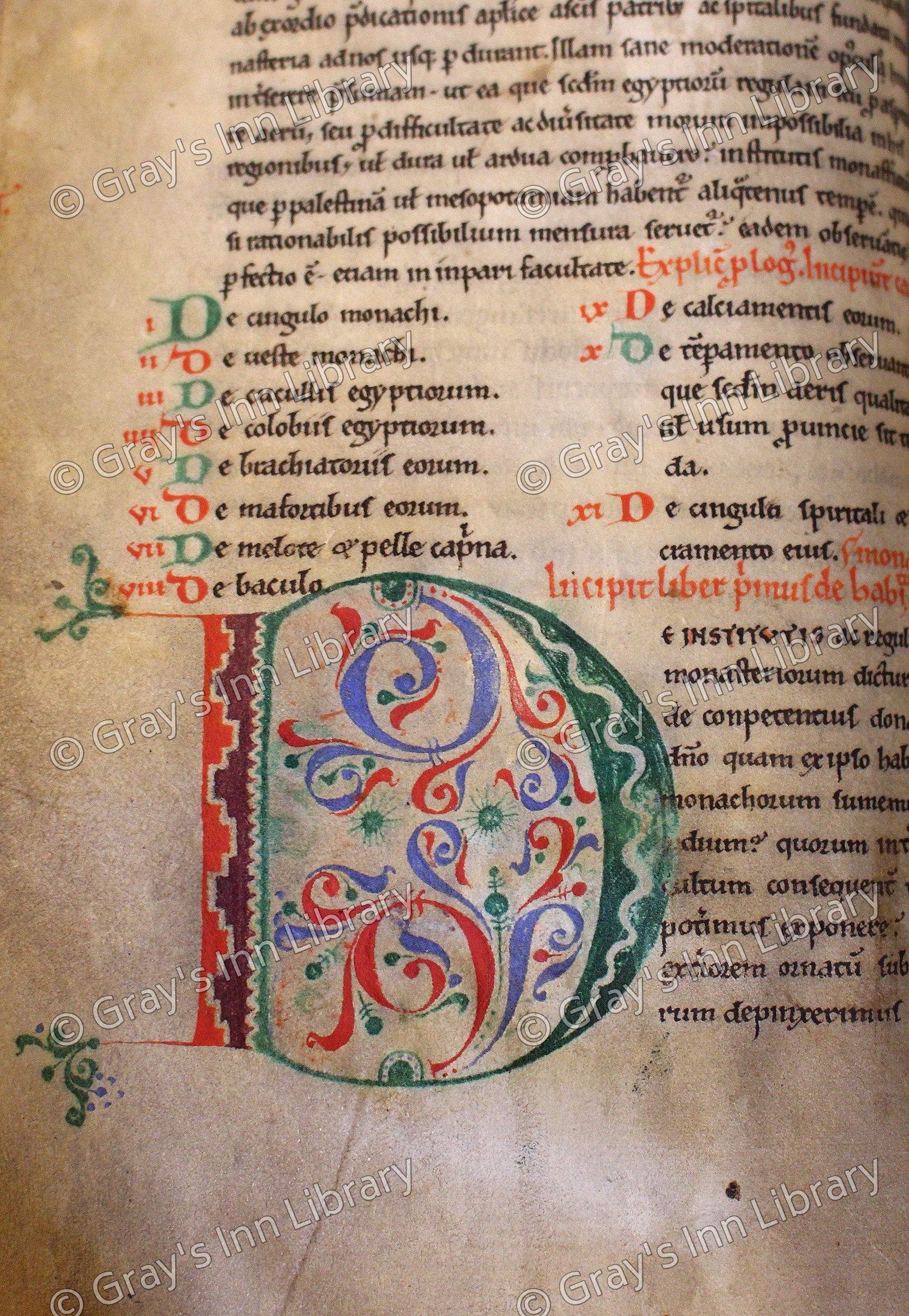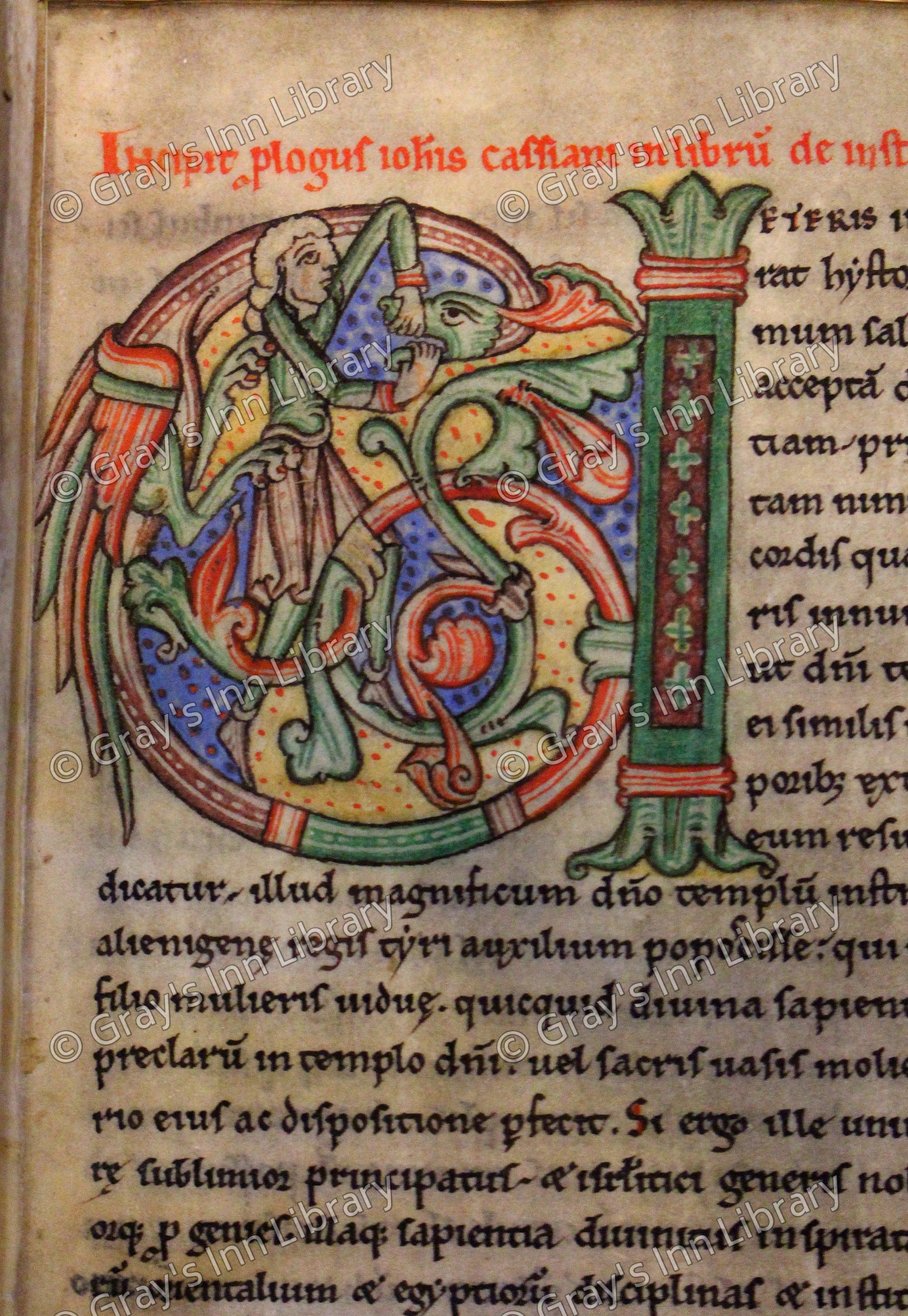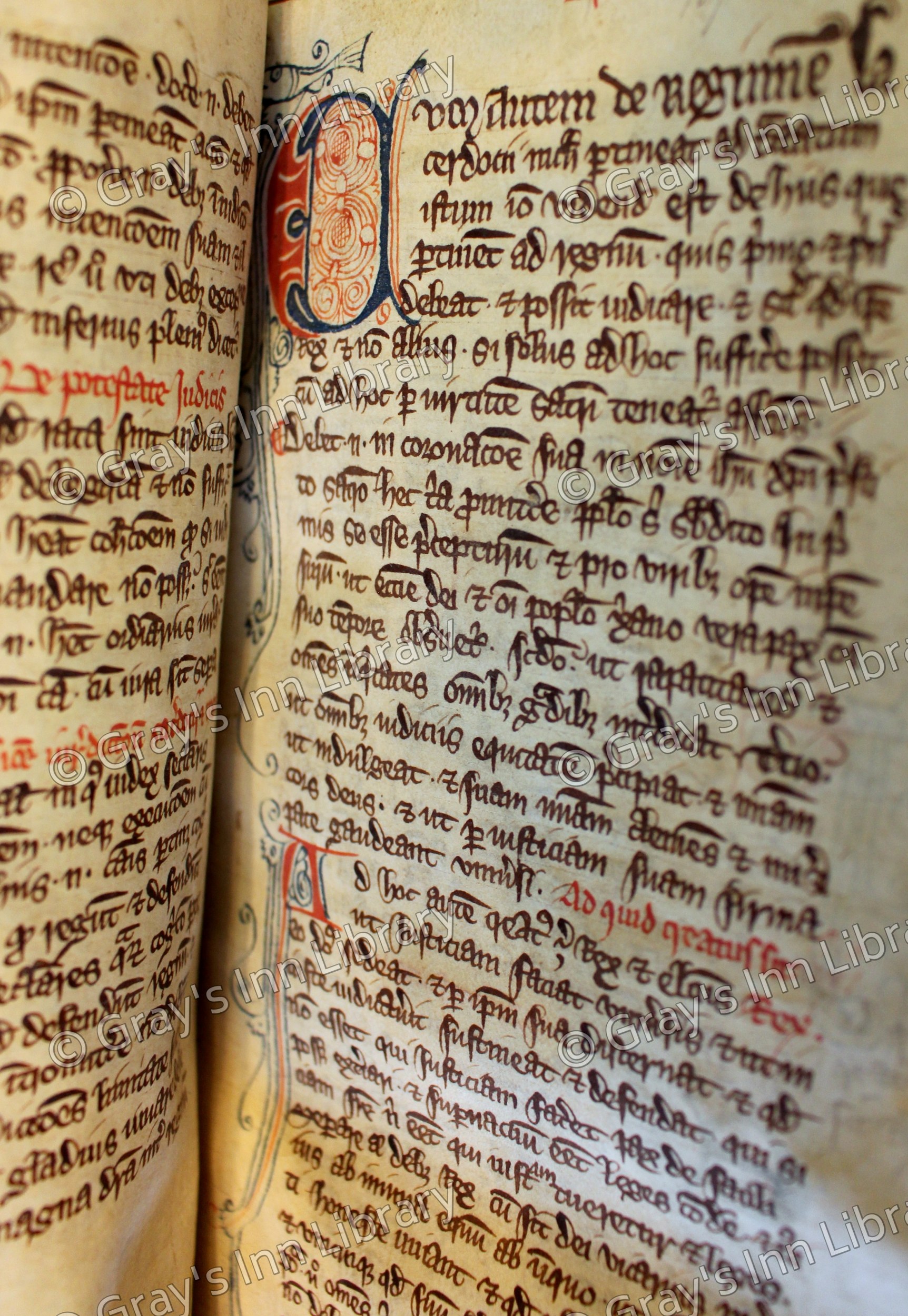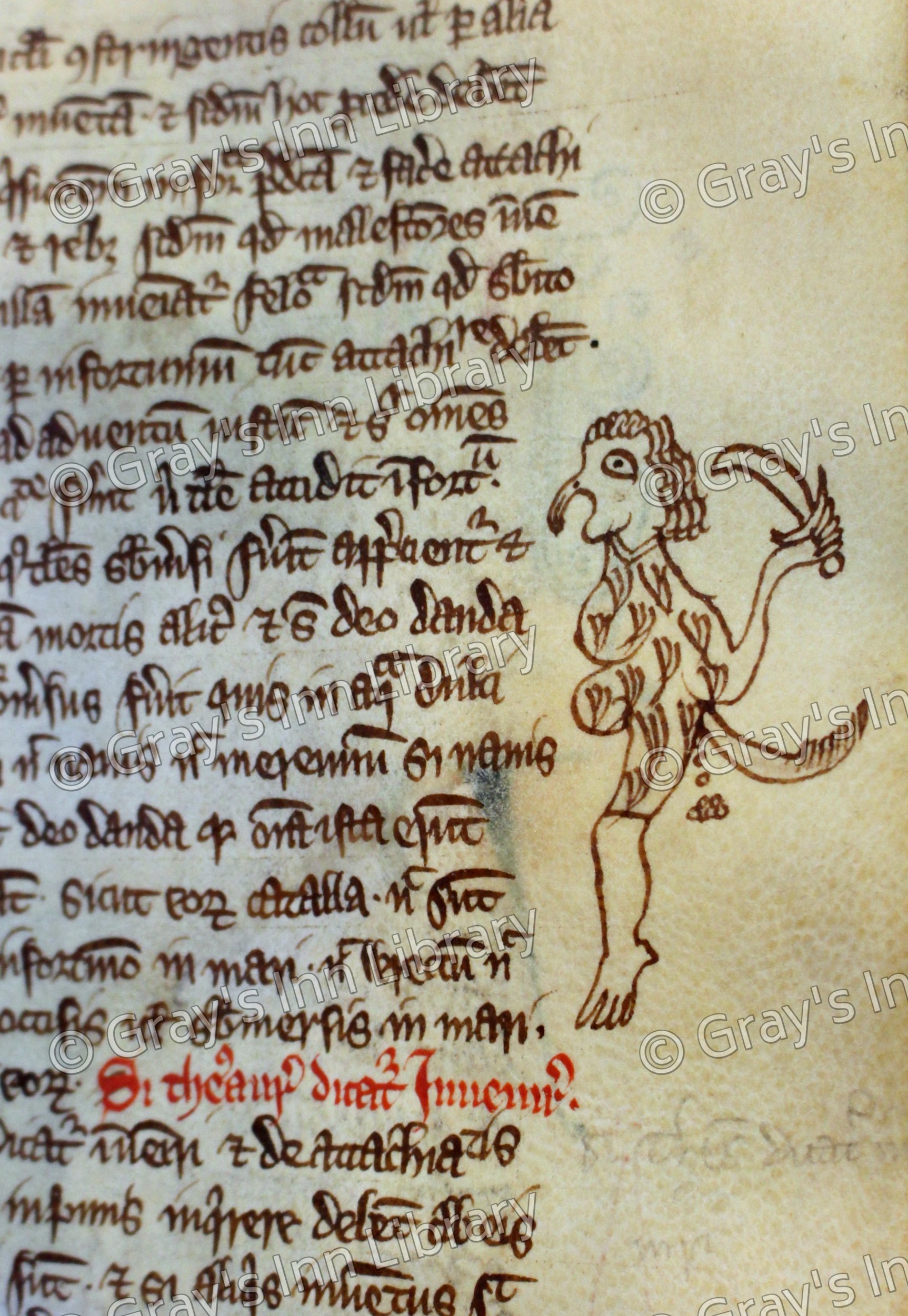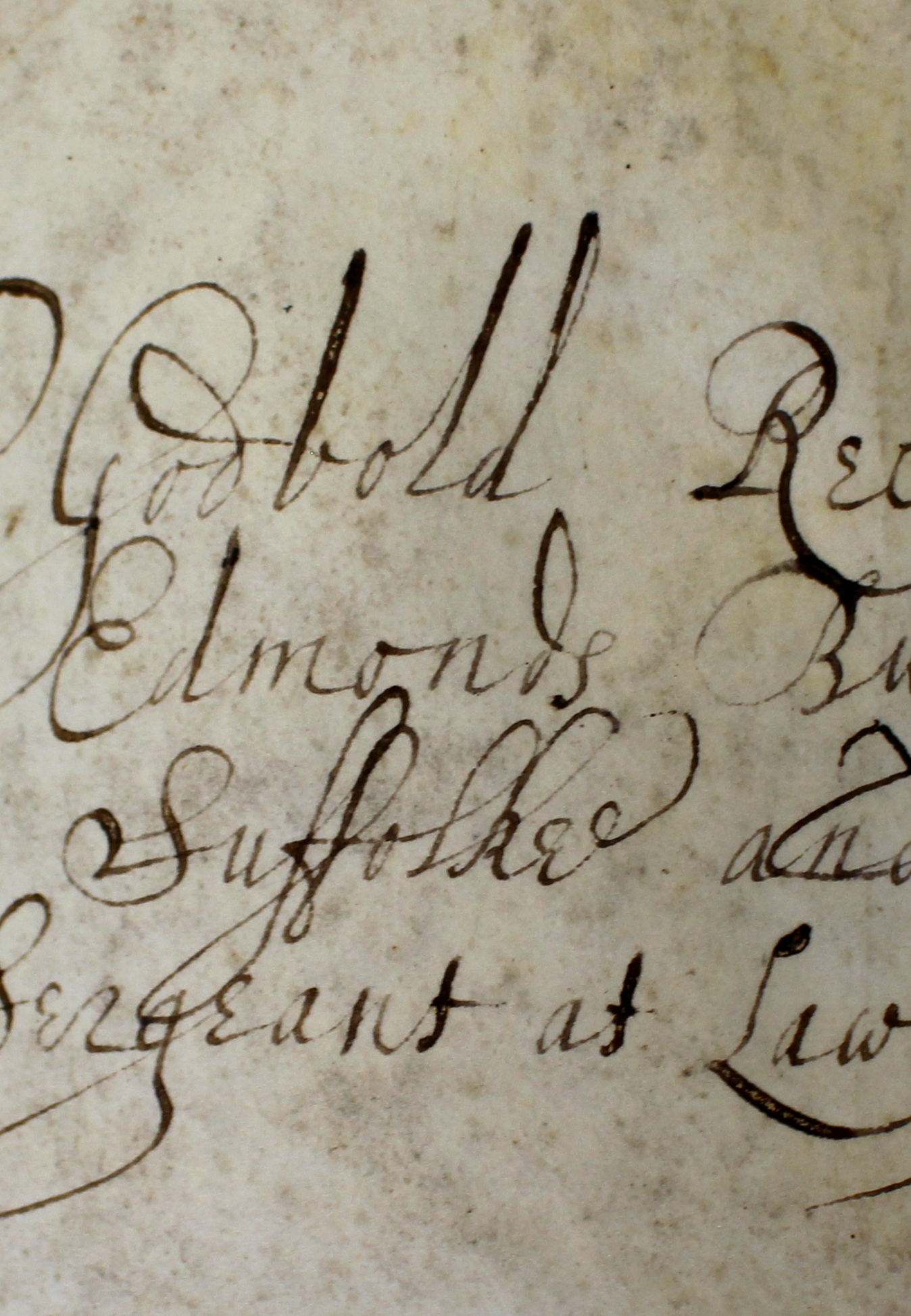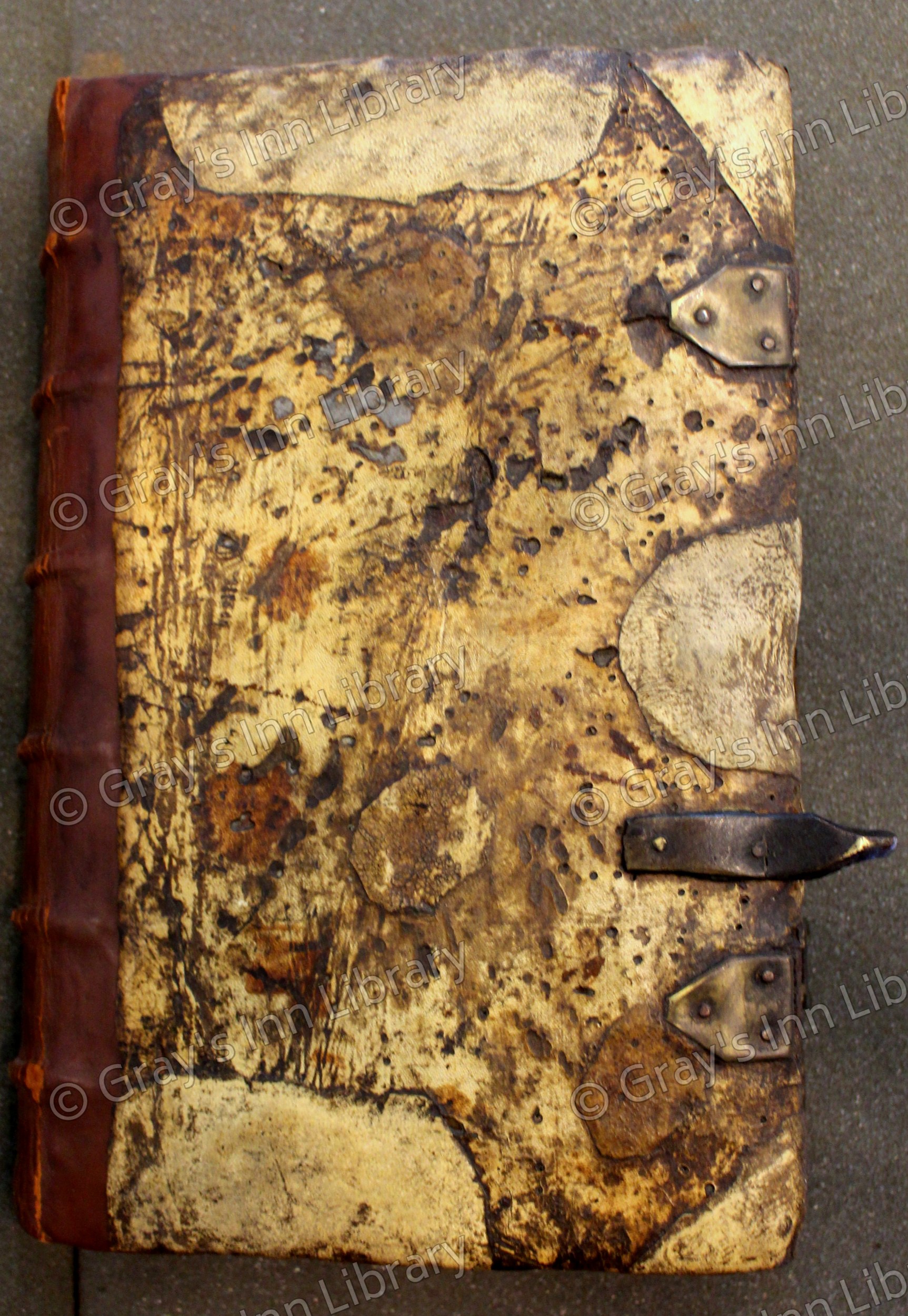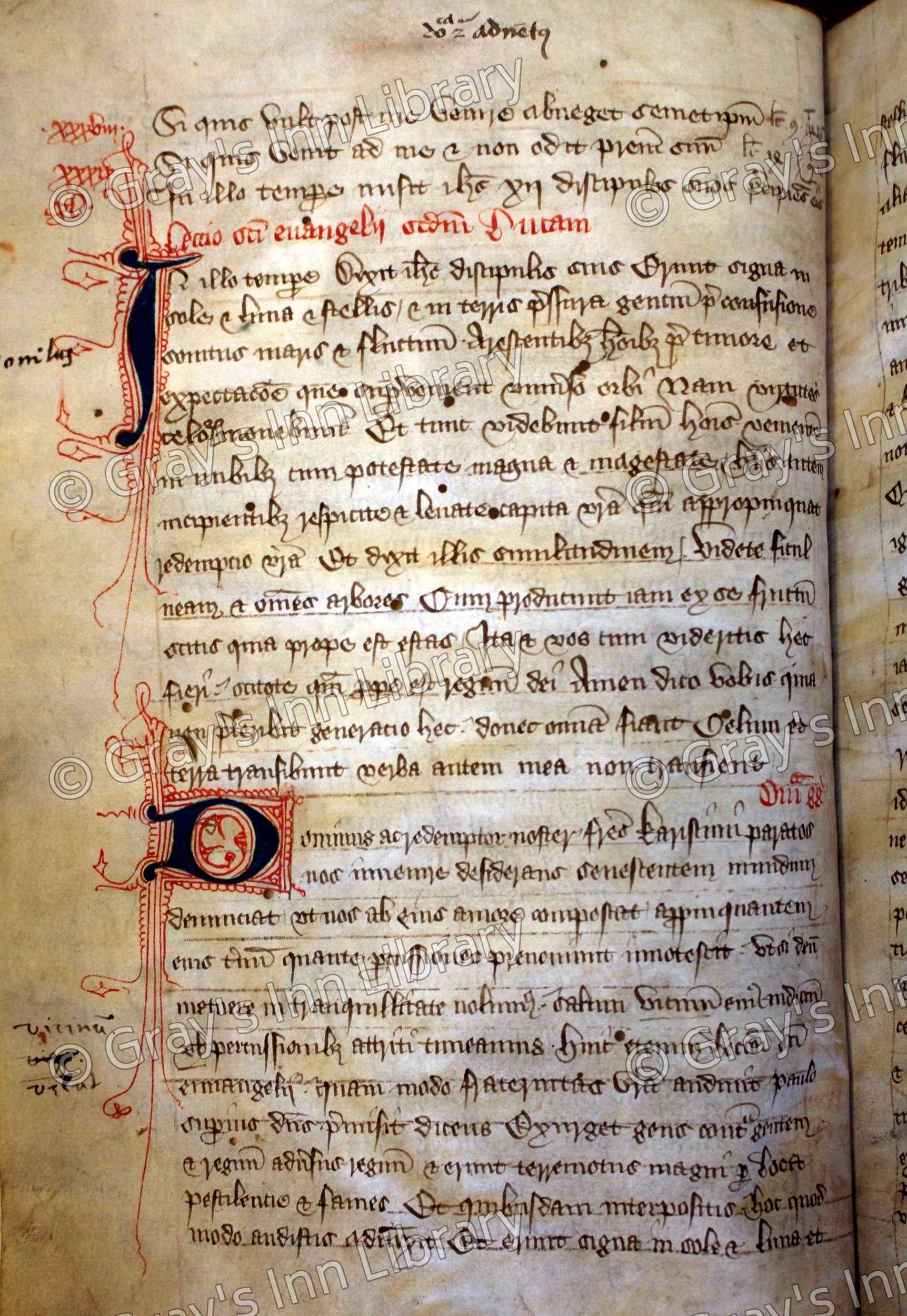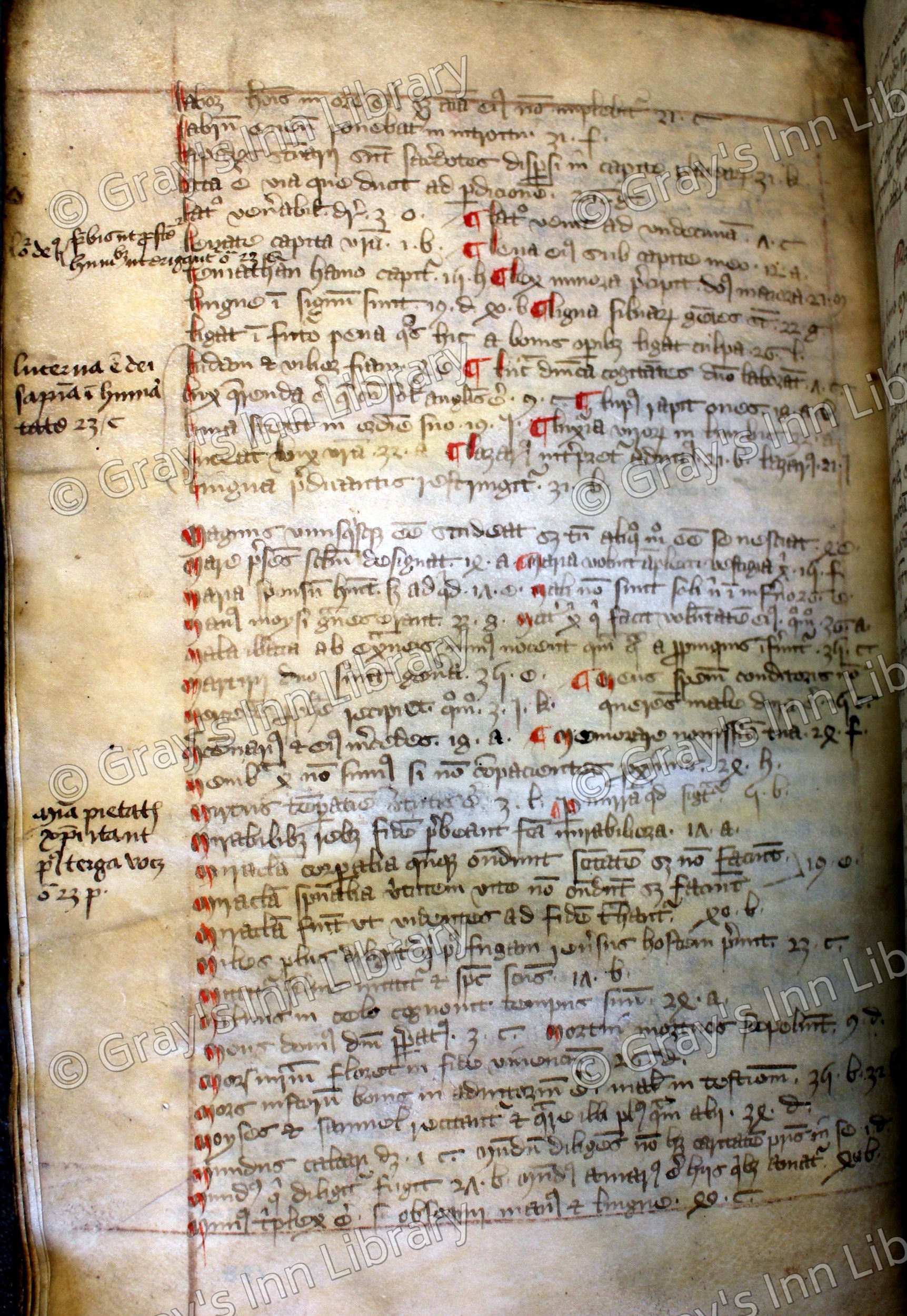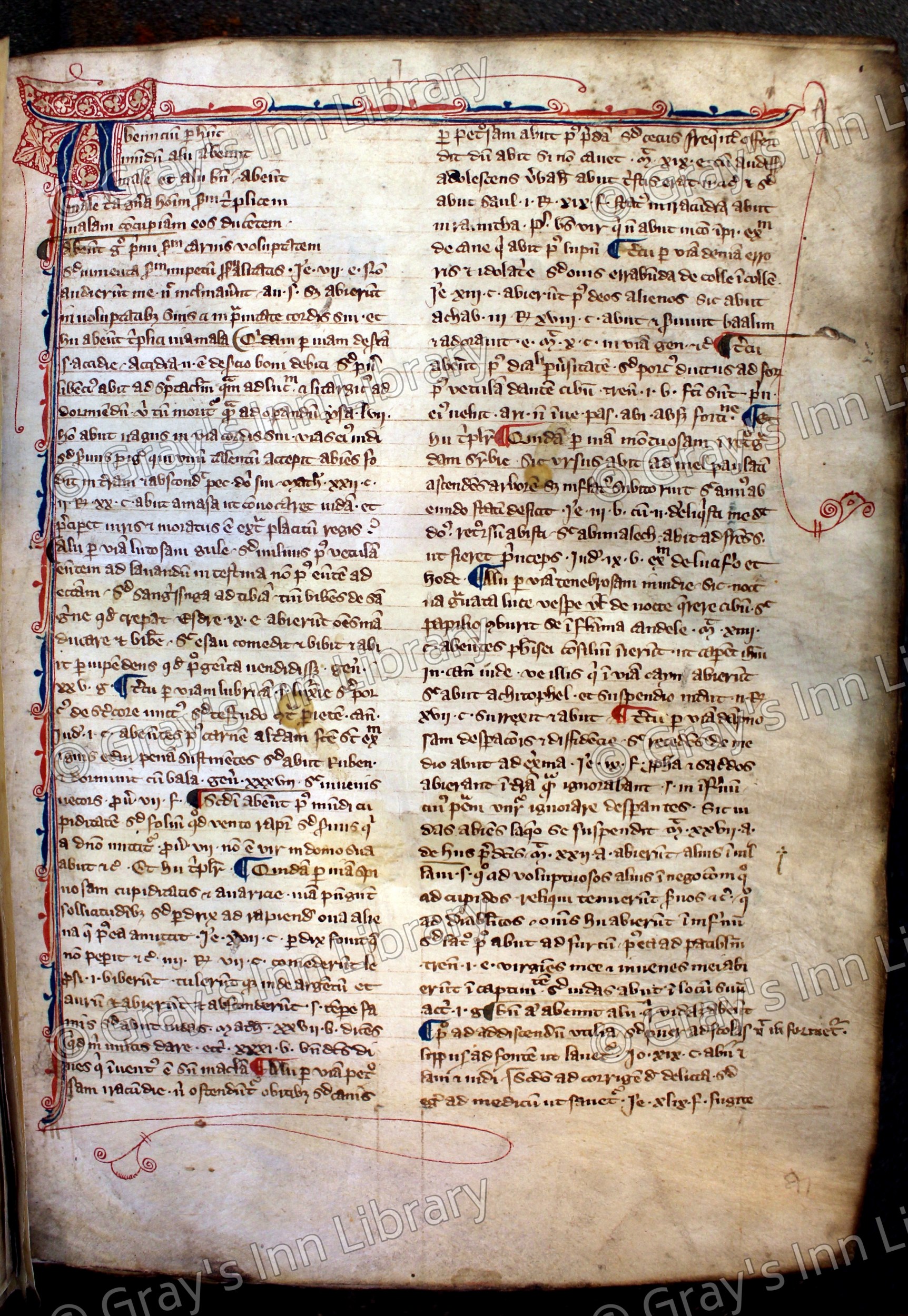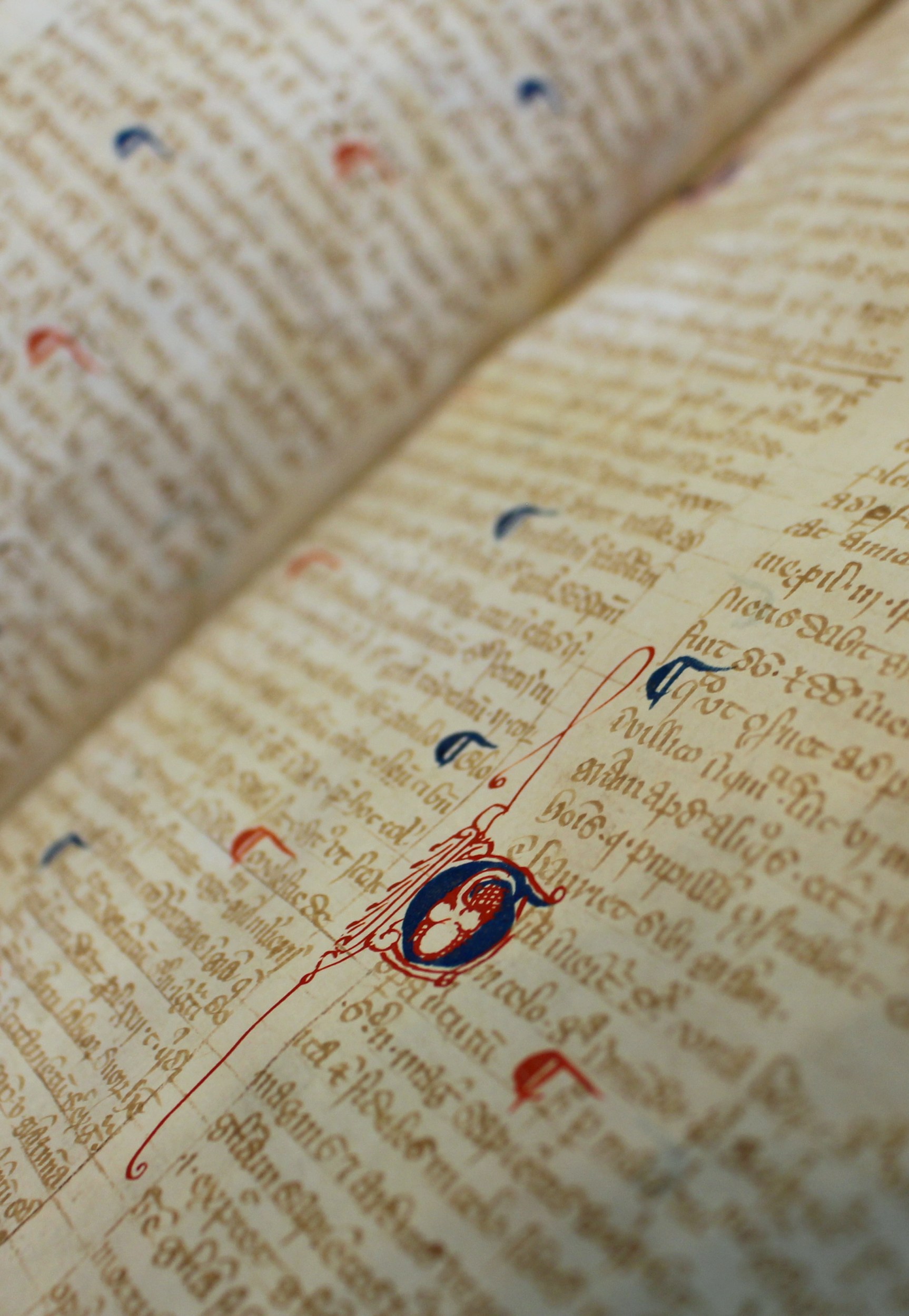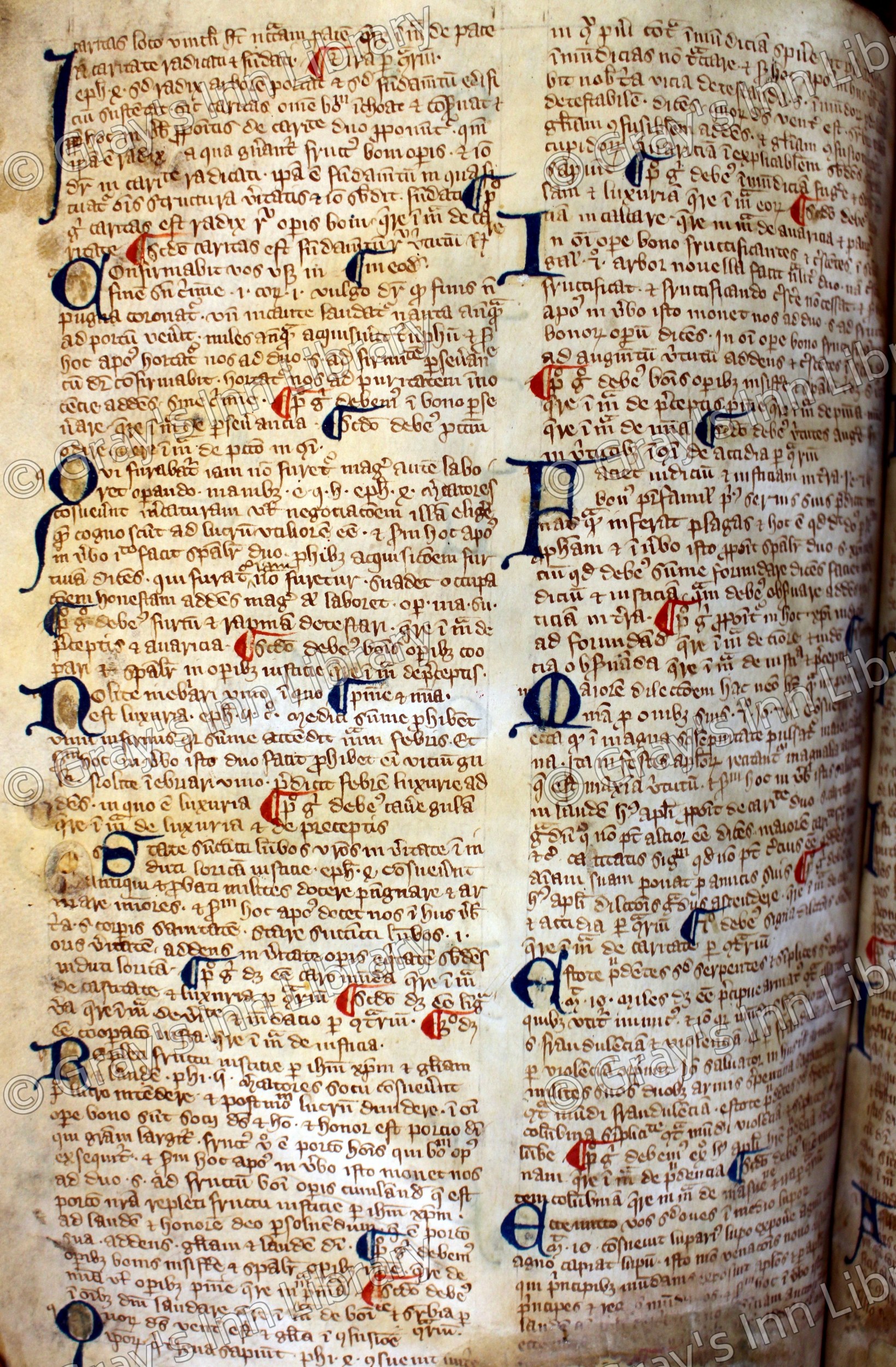Select a manuscript to find out more about it.
Manuscript 1
Johannis Cassiani De Institutis Egiptiorum Coenobiorum
- 12th Century
- 98 leaves of parchment
Begins folio 1a - Incipit prologus Johannis Cassiani
Ends folio 98a - Ejus esse muneris in veritate credamus
On the fly-leaf opposite fol. 1 is the following note, "De communitate Minorum Cestrie de dono Conewey ministri."
On the back of fol. 98 are the following notes: Iste est liber fratris Rogeri de Conewey. Liber Johannis Cassiani de institutis egiptiorum cenobiorum qui alio nomine dicitur de Collationibus Sanctorum patrum, et continet libros XII, sed deficiunt X capituli libri duodecimi.
This last note is erroneous; the work "de Collationibus Sanctorum patrum" is a different work, and the 12th book of this MS. is not deficient of 10 chapters. According to the folio edition of Paris, 1642, the 12th book contains 33 chapters, and ends with the same words as does this MS: the 12th book here is made to contain 32 chapters. The first printed edition is that in folio printed at Brussels, about the year A.D. 1474, by the Fratres Communis vitae.
The Author lived in the fifth century.
Taken from A Catalogue of the Ancient Manuscripts Belonging to the Honourable Society of Gray's Inn by Alfred Horwood, published 1869.
Manuscript 2
Holkot (Robert) Super Prophetas; and other works mentioned below
- 14th Century
- 197 leaves of parchment
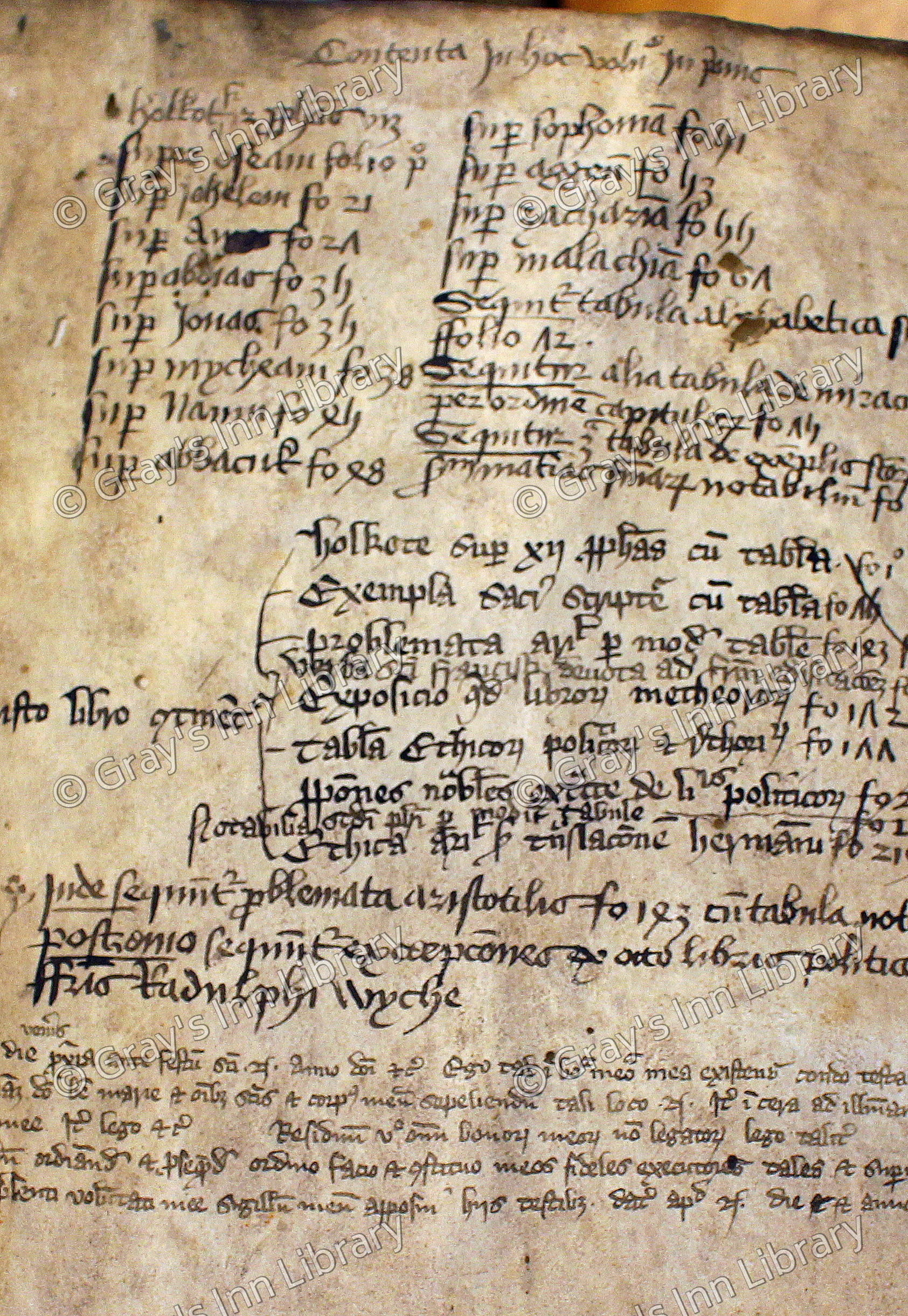
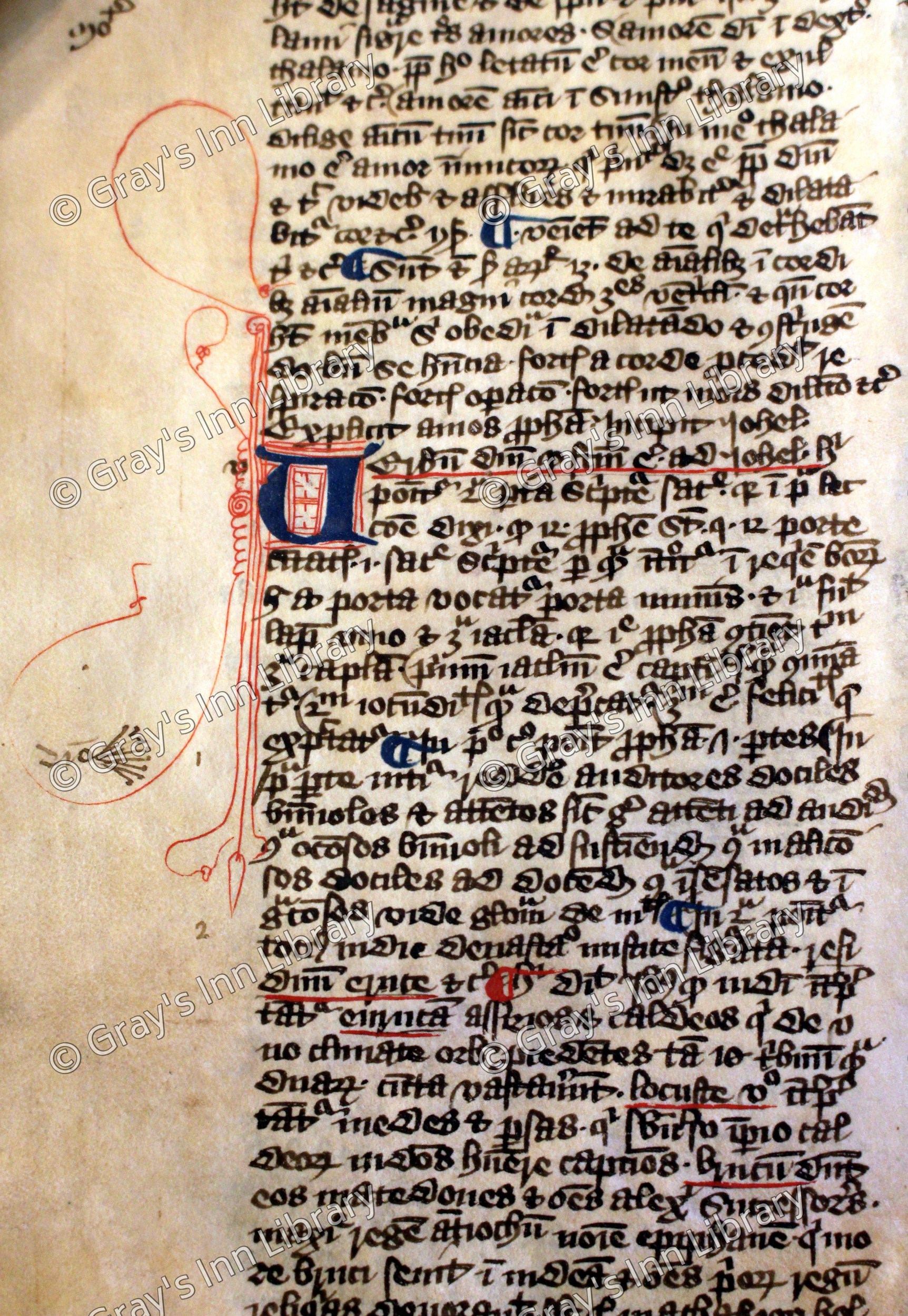
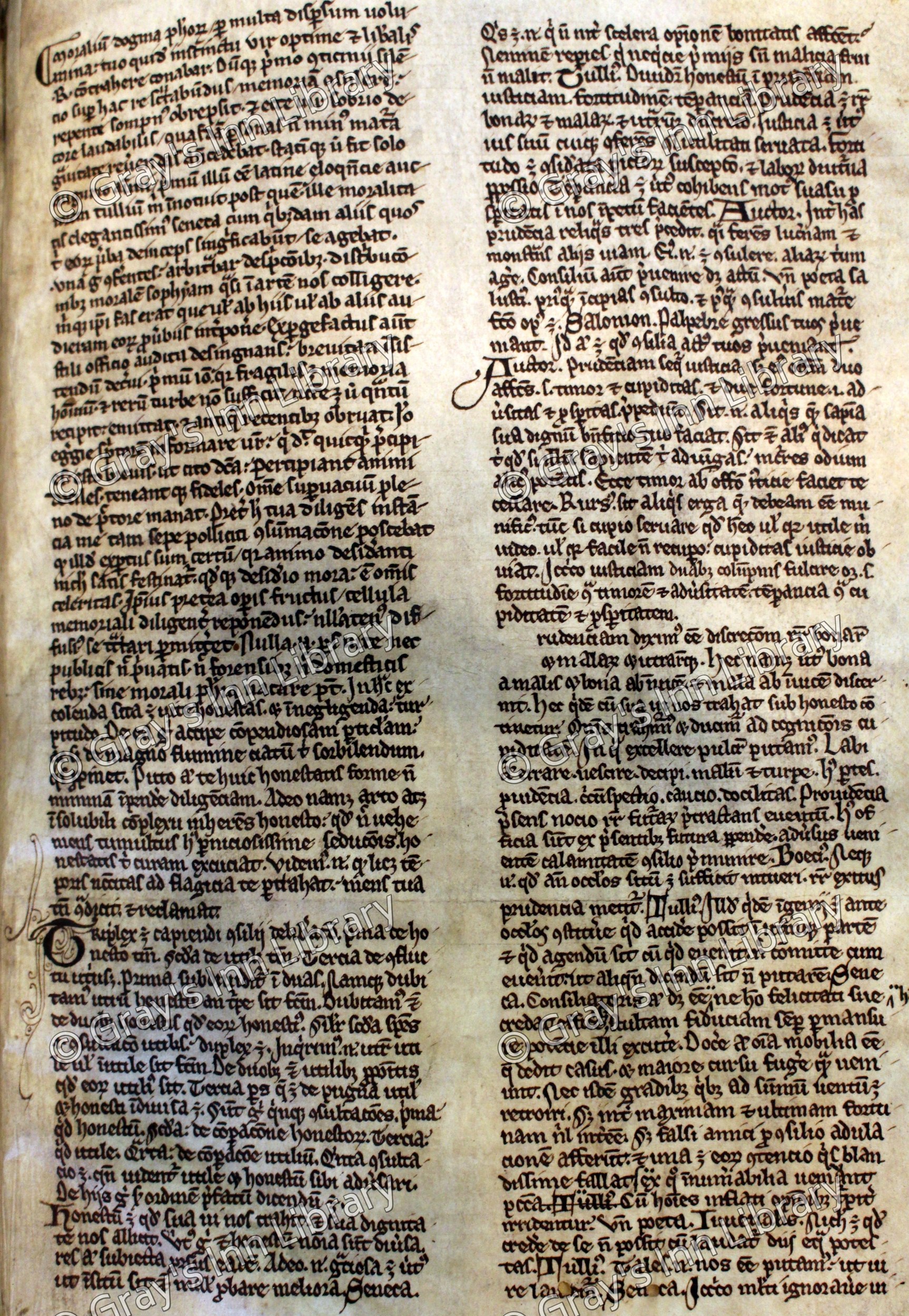
I. The Commentaries of Robert Holkot (a Dominican, temp. Edw. III) on the twelve minor prophets - folio 1 - 72a
A table on the same - folio 72a - 74b
II. A table to the next work - folio 75a
Exempla Scripturae - folio 75a - 141b
An alphabetical table to the same (quam scripsit Ra. Wyche) - folio 142
III. Problemata Aristotelis - folio 143a - 170b
IV. Haec sunt verba Sancti Francisci ad fratres de ordine Domini, primo de malo propriae voluntatis (scripta per fratrem Rad. Wyche) - folio 170b - 171a
V. Sententia quatuor librorum Metheorum (extracta a Fratre...) - folio 172a- 176b
VI. Tabula ethicorum politicorum et rhetoricorum - folio 177 - 214a
VII. Proposiciones notabiles extracte de libris politicorum - folio 214b - 217b (The last leaf of this tract, fol. 218, is absent)
VIII. Ethica Aristotelis secundum quosdam et secundum translationem Hermanni Alemanni ad Arabico in Latinum - folio 219a - 227b
From the table of contents on the fly-leaf at the beginning of the volume, the whole of the volume, except the last tract, would seem to have been written by brother Ralph Wyche; and the writing seems to be of the end of the 14th century. The last tract is be a different hand, and is of the middle of the 13th century. The last leaf, numbered 228, is no part of any of the tracts, and seems to have been used in binding the book. It is a Latin account of a dream, beginning Moralium dogma philosophorum, and ending Idcirco multi ignoravere in... At the beginning of the volume are three vellum fly-leaves; the first has a short table of contents, and a short form in Latin of a will. The second and third are occupied by a political poem, in Latin, evidently composed in the latter part of the reign of Edward III., and in answer to the Latin poem in the same metre printed in volume 1. p. 255, of "Political Songs" ("Chron. and Mem. of the Middle Ages"). The Wyt &c., which commences each fifth line, is to be read as "Wyth an O and an I." The poem is in defence of the Friars; whereas that printed is an attack on them: there are 30 stanzas of five lines; but, as each fifth line is a distich, there are 180 lines. In the foliation, the numbers between 79 and 90, and between 109 and 120, and between 189 and 200, are accidentally omitted. Thus the volume appears to have 228 folios. But nothing is wanting except the leaf which was between 217 and 219. The poem above referred to is very likely the composition of Roger de Conewey, who lived at the same time as Richard fiz Ralph, Archibishop of Armagh, and wrote in opposition to him, and perhaps the same person as the donor of several of these volumes to the house of the Minorites at Chester. The Archbishop's defence of the Curates and Conewey's defence of the Friars were printed in small folio at Lyons in 1496. It is a volume of great rarity. Taken from 'A Catalogue of the Ancient Manuscripts Belonging to the Honourable Society of Gray's Inn' by Alfred Horwood, published 1869. Make a request to view this manuscript.Manuscript 3
Passionale
Accounts of the deaths and miracles of martyrs, beginning with St. Ansbert
- 11th Century
- 161 leaves of parchment
- It appears from the numbering to have 165 leaves; but folios 3, 4, 5 and 6 are absent
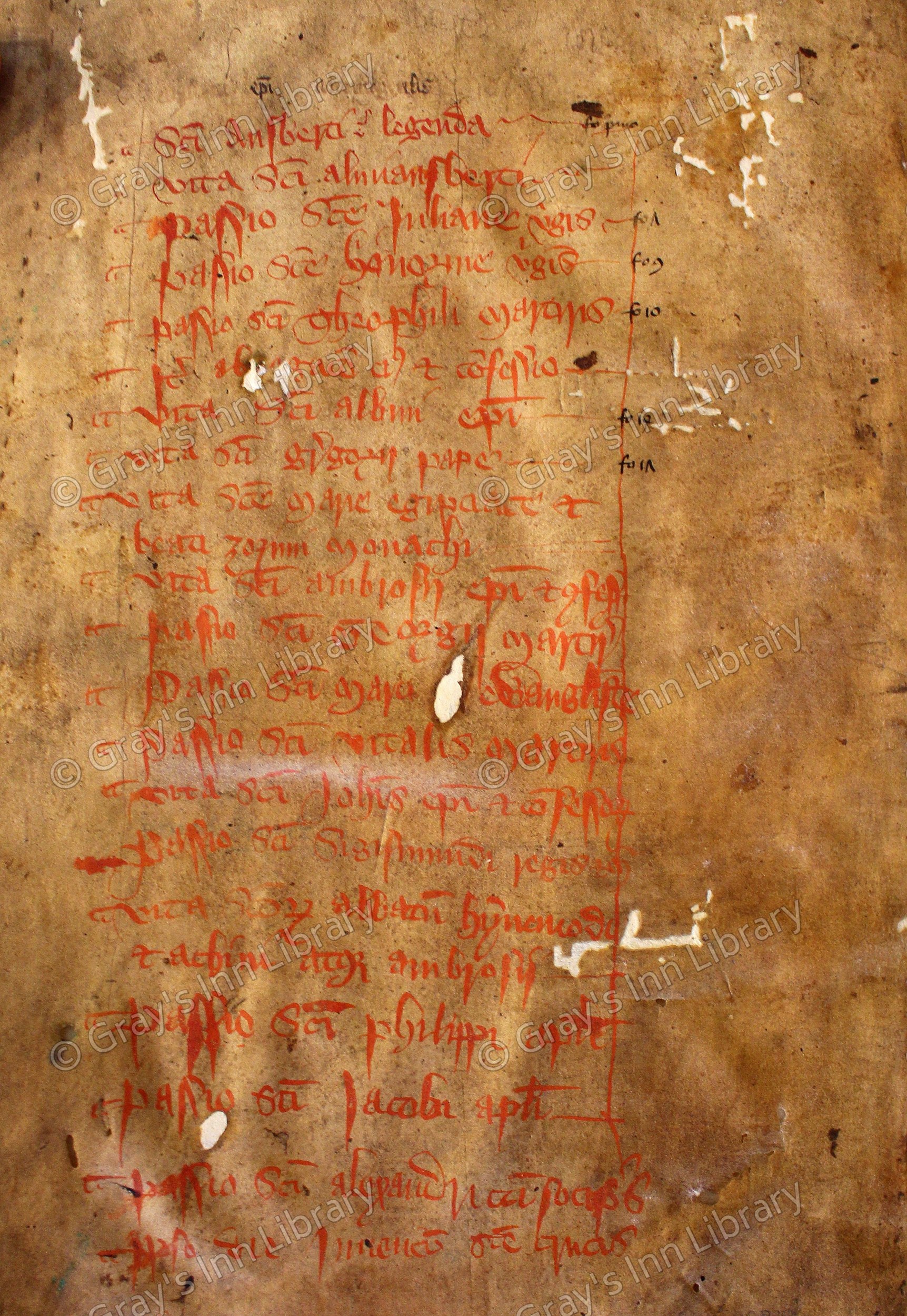
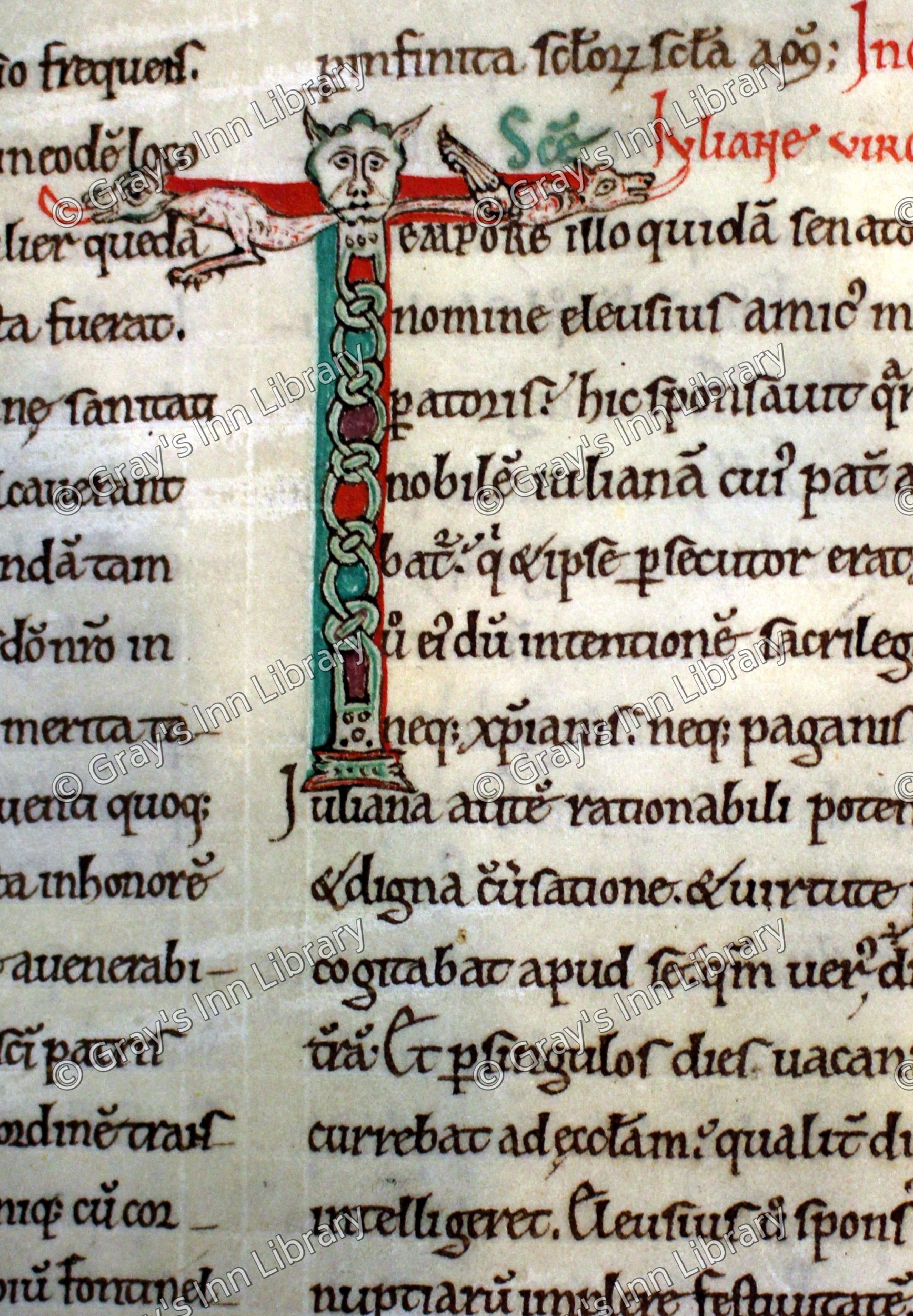
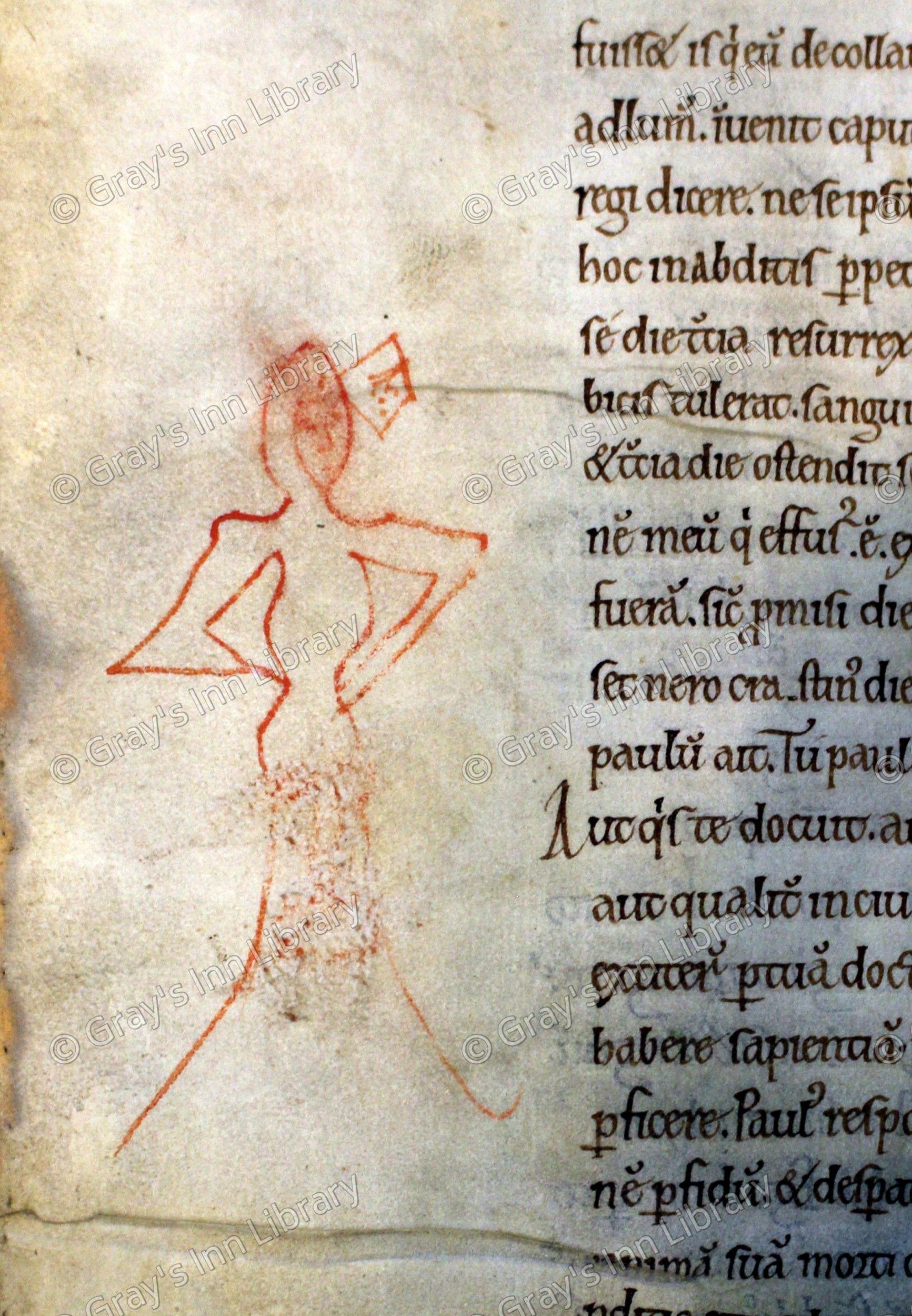
An index on two paper leaves in writing of the 15th century is prefixed; but only those items marked with pencil are in the volume; and of these, the references to the folios are correct. Most likely there was a fellow volume containing the other items, for at the head of the first folio of the present volume are the words primum passionarium XI loco: and the fellow volume must be of later date, because the name of Thomas of Canterbury occurs in the index.
On the verso of folio 165 is an incomplete list of the contents.
The vellum fly-leaf at the beginning of the volume contains in red ink a list of the first 20 items in the volume.
Taken from 'A Catalogue of the Ancient Manuscripts Belonging to the Honourable Society of Gray's Inn' by Alfred Horwood, published 1869.
Manuscript 5
Beda Super Canticum Canticorum, &c.
- 13th Century
- 154 leaves of vellum
- The old numbering of the leaves begins on folio 2
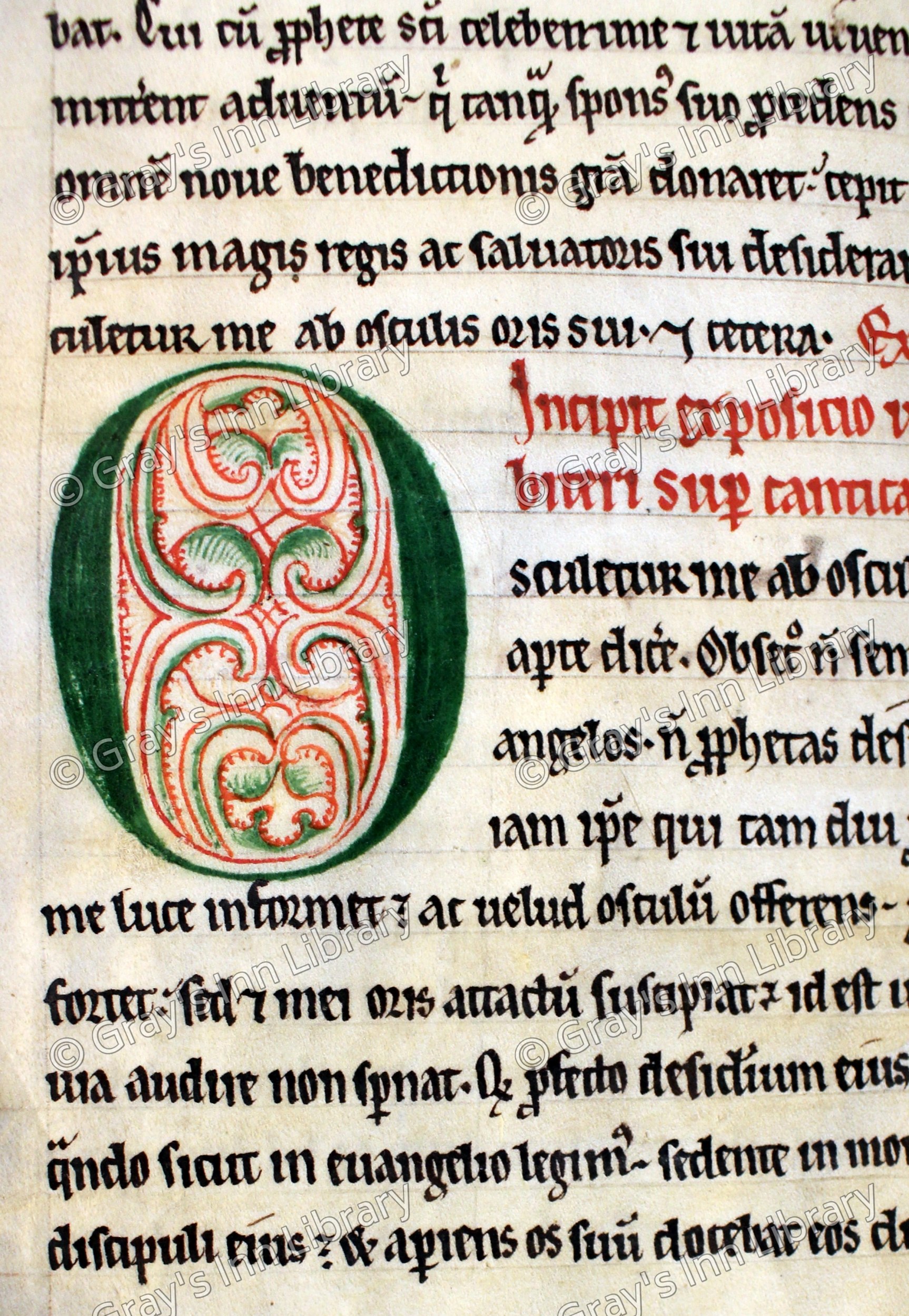
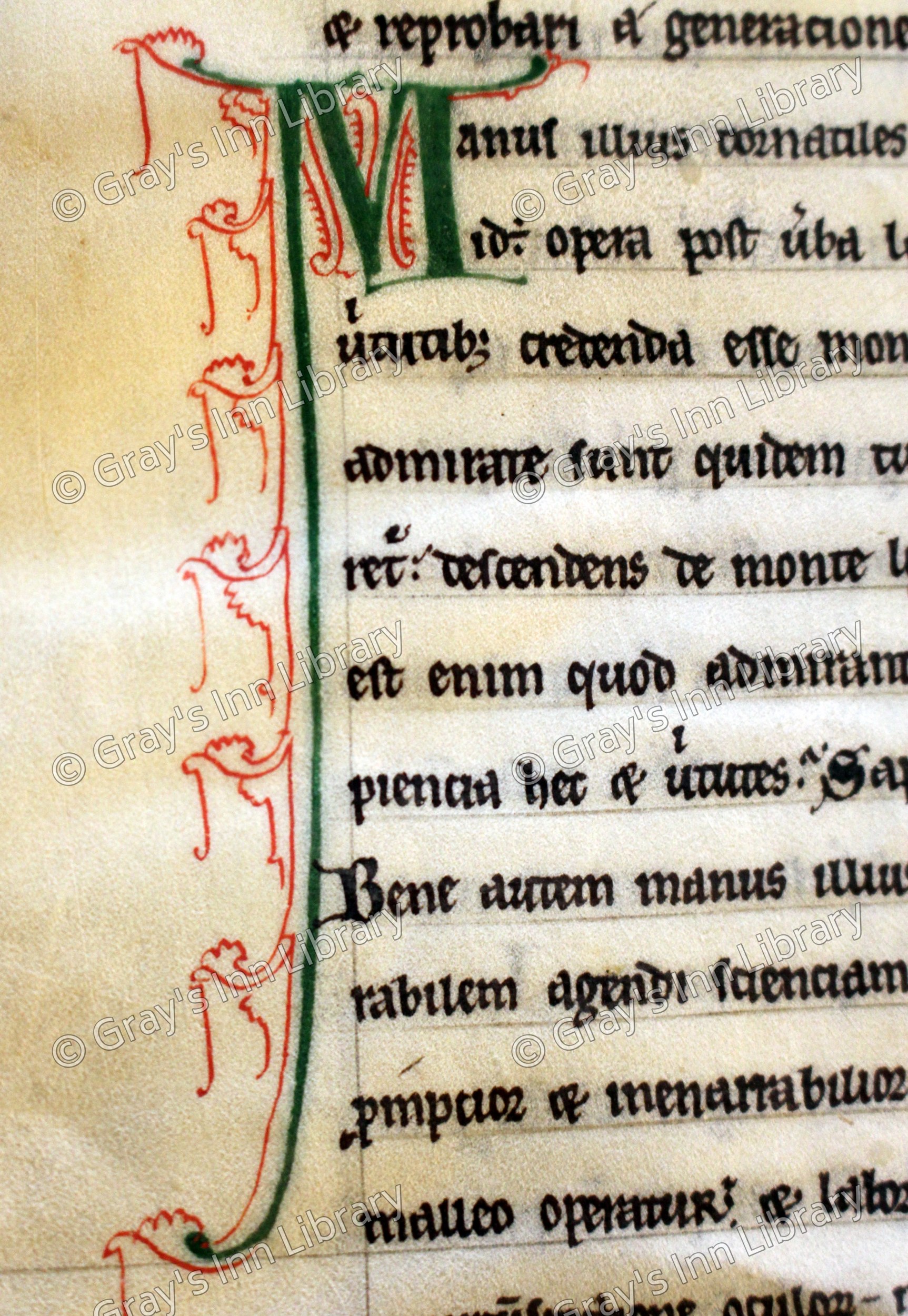
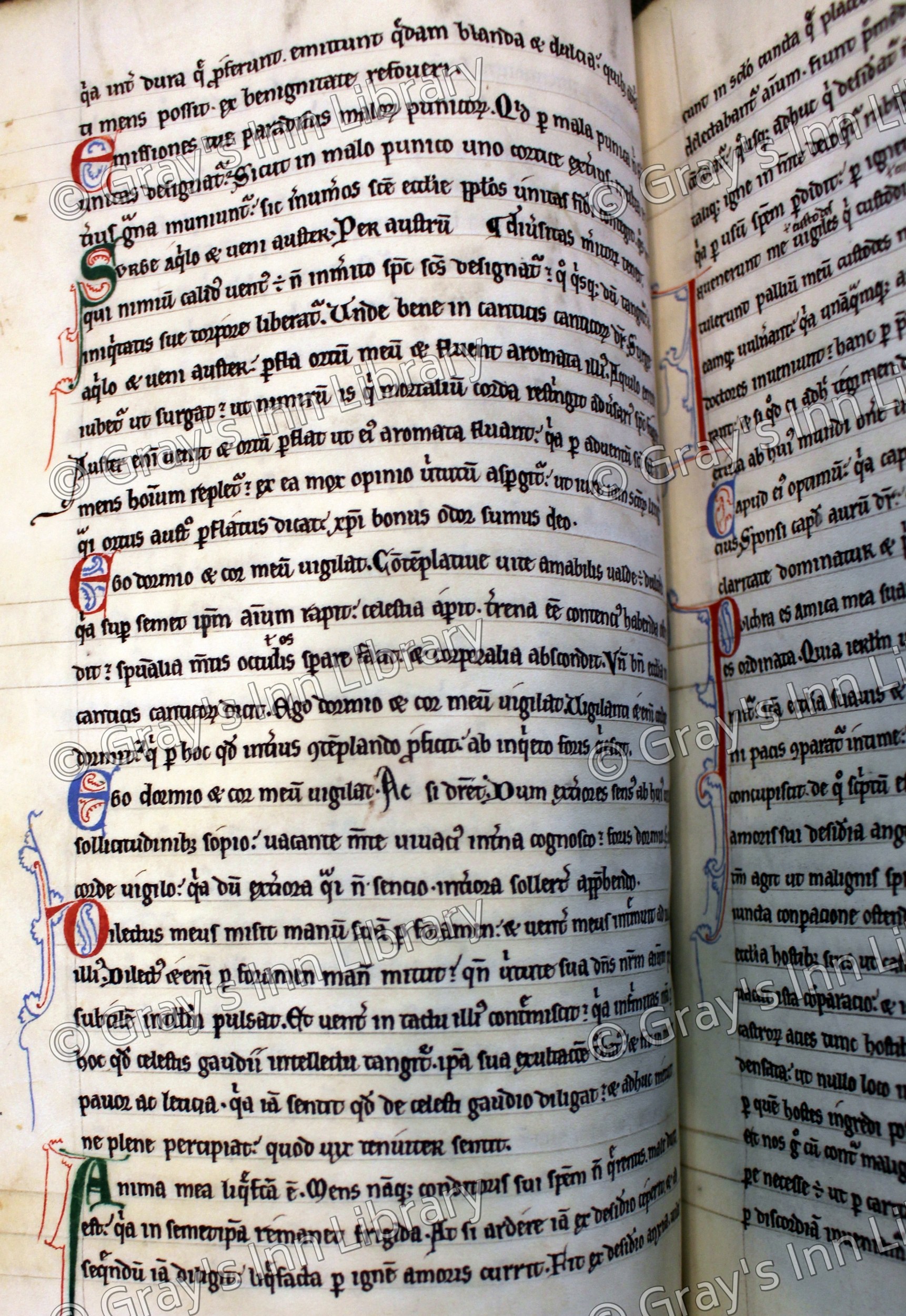
I. Beda super Cantica - folio (1) - 95b
II. Liber Hugonis de Archa Noe - folio 96a - 144a
III. (Hugo) de Arra anime - folio 144a - 153b
Colophon: (h)ić est liber sancte Marie et sancti Andree de Lundors. In hoc volumine continentur hec. Beda super cantica canticorum. Hugo de archa noe. Idem de arra anime. The colophon seems to assign the two latter treatises to the same Hugo. But the first is said by Oudin to be the work of Hugh de Foliet (fl. 1130), and the second to be the work of Hugh de St. Victor (fl. 1130). This copy of the second contains the author's prefatory address to his brethren of the monastery of Hamerisleve, which is not in some of the other printed editions, but is in the edition of Paris, 4to, 1506. There are two old fly-leaves at the beginning and one at the end of the volume. On the verso of the 1st is a table of contents, and this note: Beda A. De communitate minorum Cestrie, De dono ministri Conewey. The second fly-leaf is occupied, in writing of the beginning of the 13th century, by what the table of contents describes as "Innocentius Papa et Stephanus Cardinalis ad Johannem Regem pro episcopatu Cantuarie." The fly-leaf at the end contains, in writing of the 14th century, what the table of contents calls Cotaciones omnium librorum Bede. Taken from 'A Catalogue of the Ancient Manuscripts Belonging to the Honourable Society of Gray's Inn' by Alfred Horwood, published 1869. Make a request to view this manuscript.Manuscript 6
Robert Cowtone, Super Quatuor Libros Sententiarum
- 15th Century
- 151 leaves of parchment
- Includes a table of the Questiones and an alphabetical index
- Formed of 4 books, the first page of each ornamented on the margins with gold and colours
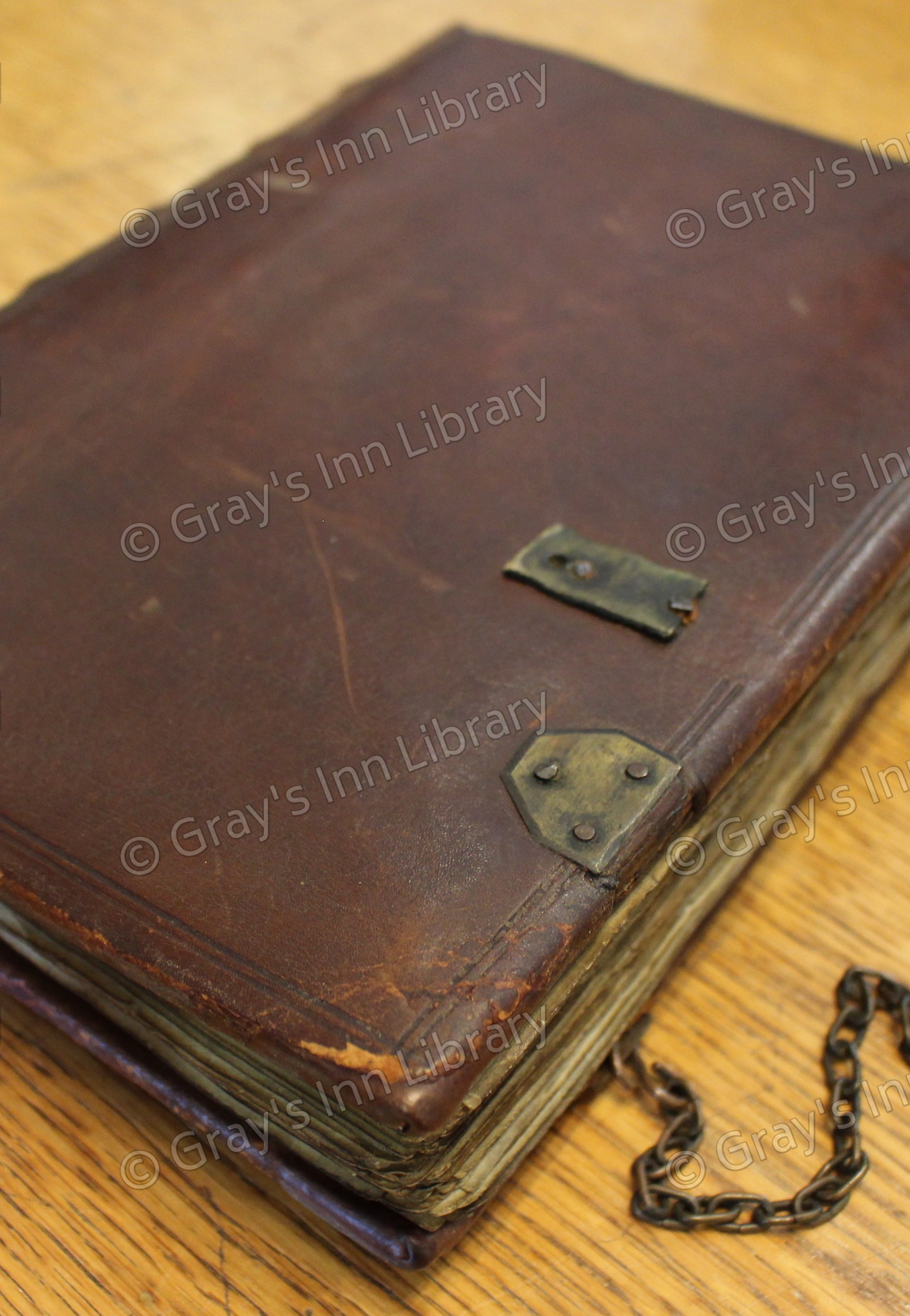
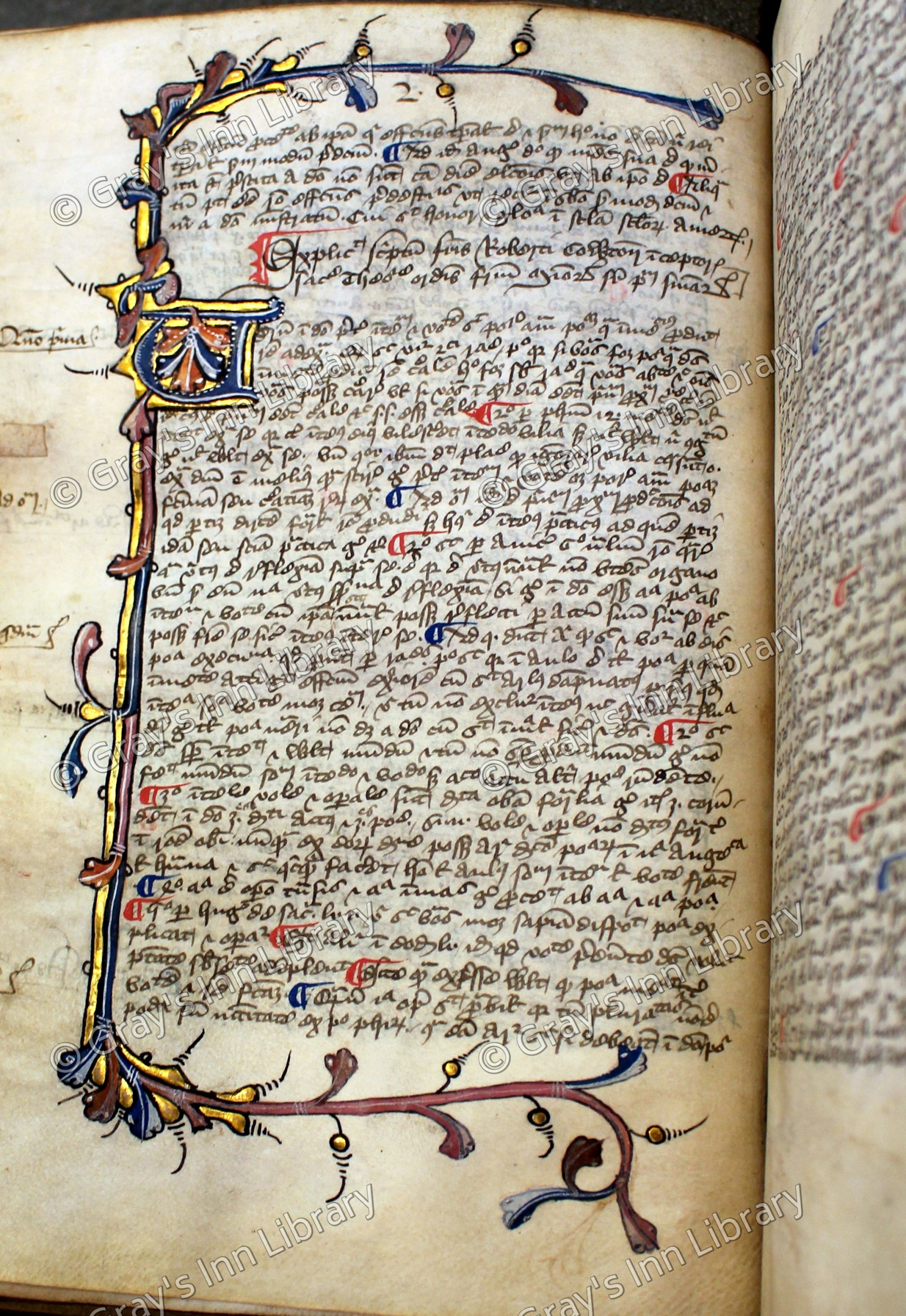
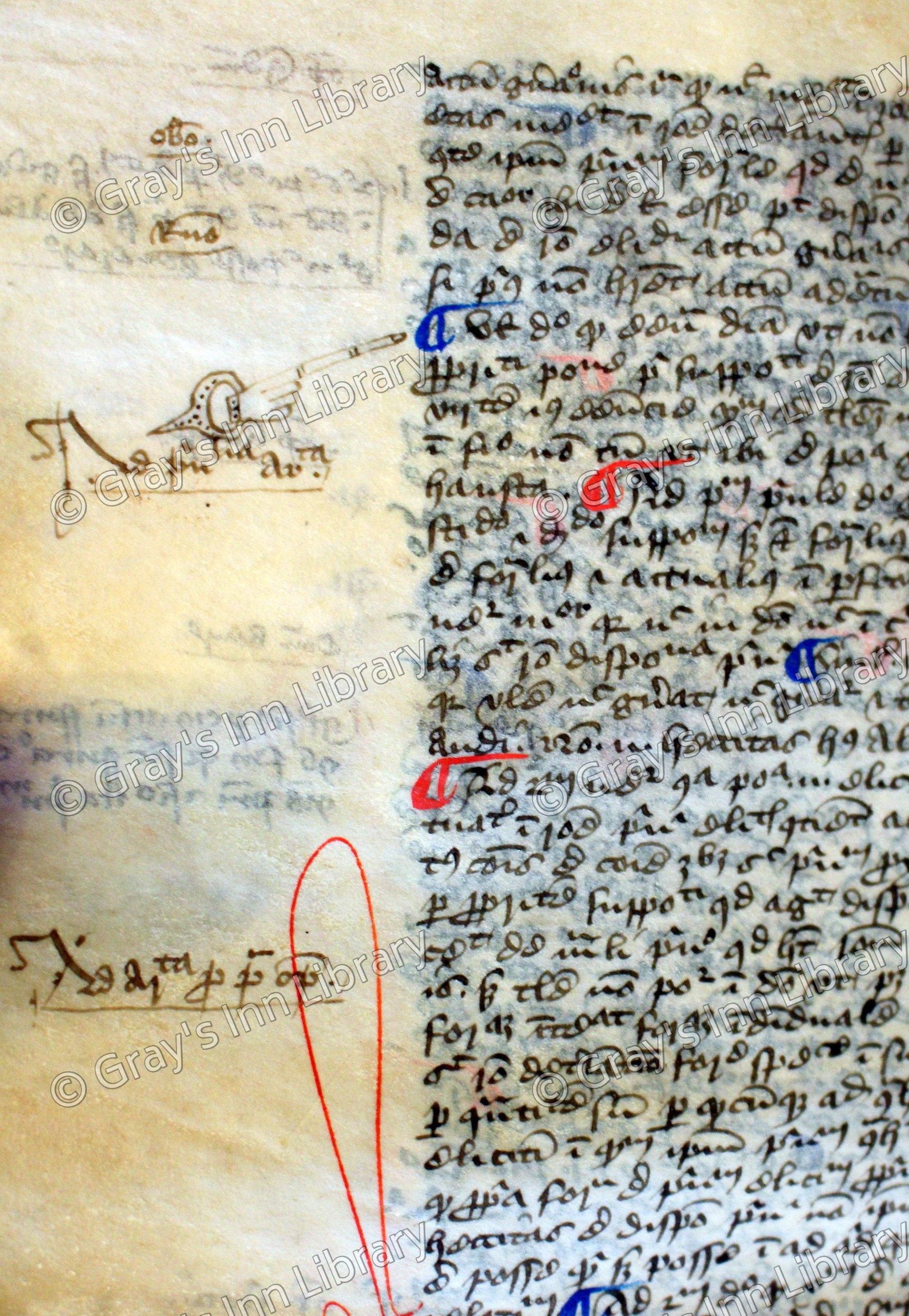 At the end of each book is, "Explicit scriptum fratris Roberti Cowtone inceptoris sacre theologie* ordinis fratrum Minorum super primum [secundum, tertium, quartum] sententiarum."
*pagine (instead of theologie) at the end of the 3rd book.
The "Questiones" occupy folios 143 and 144, and are thus closed: Expliciunt questiones quarti libri. Qui scribit carmen sit benedictus Amen. W. Treugos. The alphabetical index is thus closed, Explicit tabula super Robertum Cowtone abbreviatum quod (quoth) P. Perdix. And another hand adds, Barba carens pilis est omni masculo vilis. Septem sacramenta continentur in hoc versu.
The first of the 3 old fly-leaves at the beginning of the volume contains a copy of an epitaph by Seneca.
Cowtone flourished in the 14th century.
Taken from 'A Catalogue of the Ancient Manuscripts Belonging to the Honourable Society of Gray's Inn' by Alfred Horwood, published 1869.
Make a request to view this manuscript.
At the end of each book is, "Explicit scriptum fratris Roberti Cowtone inceptoris sacre theologie* ordinis fratrum Minorum super primum [secundum, tertium, quartum] sententiarum."
*pagine (instead of theologie) at the end of the 3rd book.
The "Questiones" occupy folios 143 and 144, and are thus closed: Expliciunt questiones quarti libri. Qui scribit carmen sit benedictus Amen. W. Treugos. The alphabetical index is thus closed, Explicit tabula super Robertum Cowtone abbreviatum quod (quoth) P. Perdix. And another hand adds, Barba carens pilis est omni masculo vilis. Septem sacramenta continentur in hoc versu.
The first of the 3 old fly-leaves at the beginning of the volume contains a copy of an epitaph by Seneca.
Cowtone flourished in the 14th century.
Taken from 'A Catalogue of the Ancient Manuscripts Belonging to the Honourable Society of Gray's Inn' by Alfred Horwood, published 1869.
Make a request to view this manuscript.
Manuscript 7
Petri Blesensis Epistolae; and other works mentioned below
- 13th Century
- 248 leaves of parchment
- After folio 199 the numeration begins from 1000
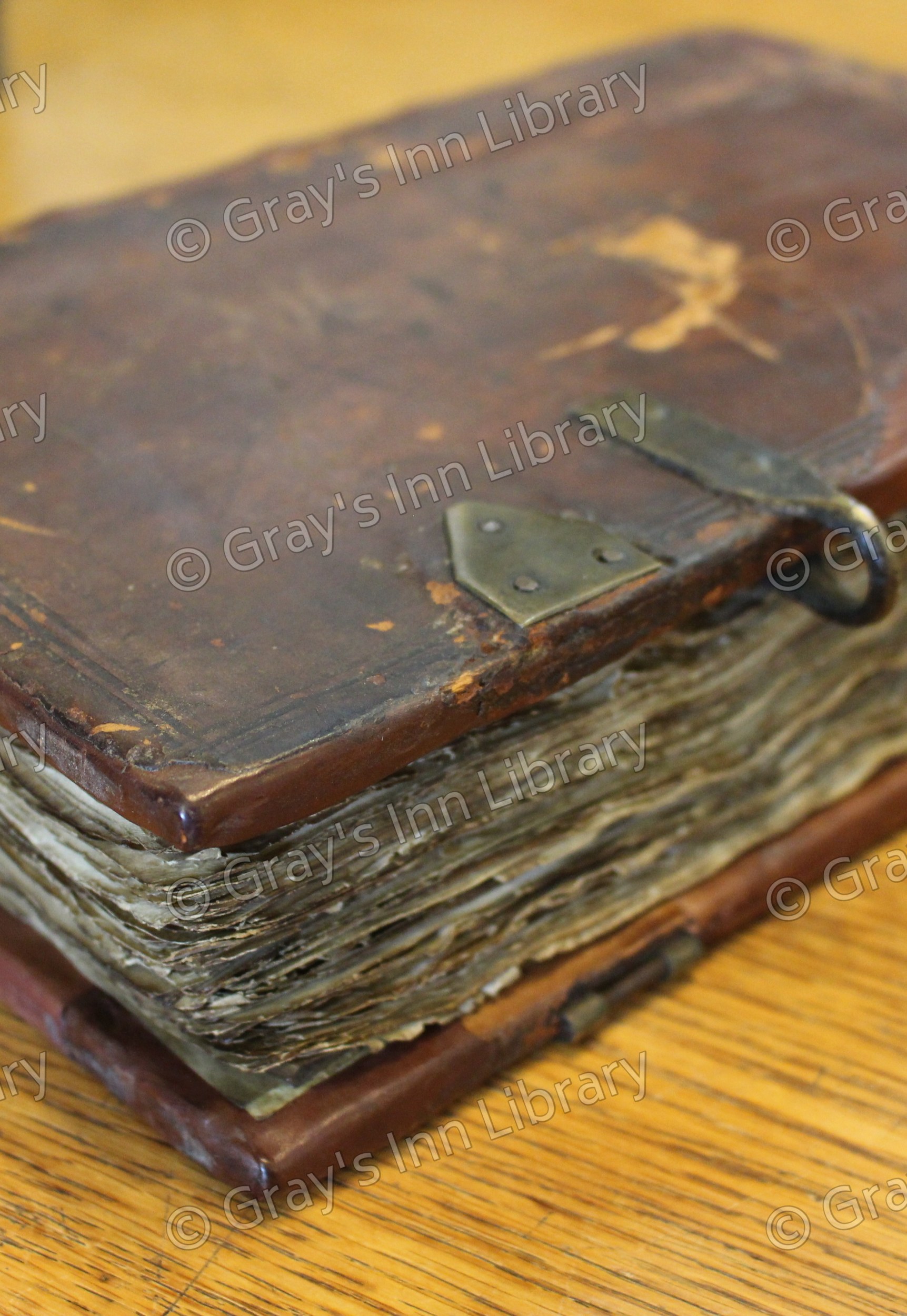
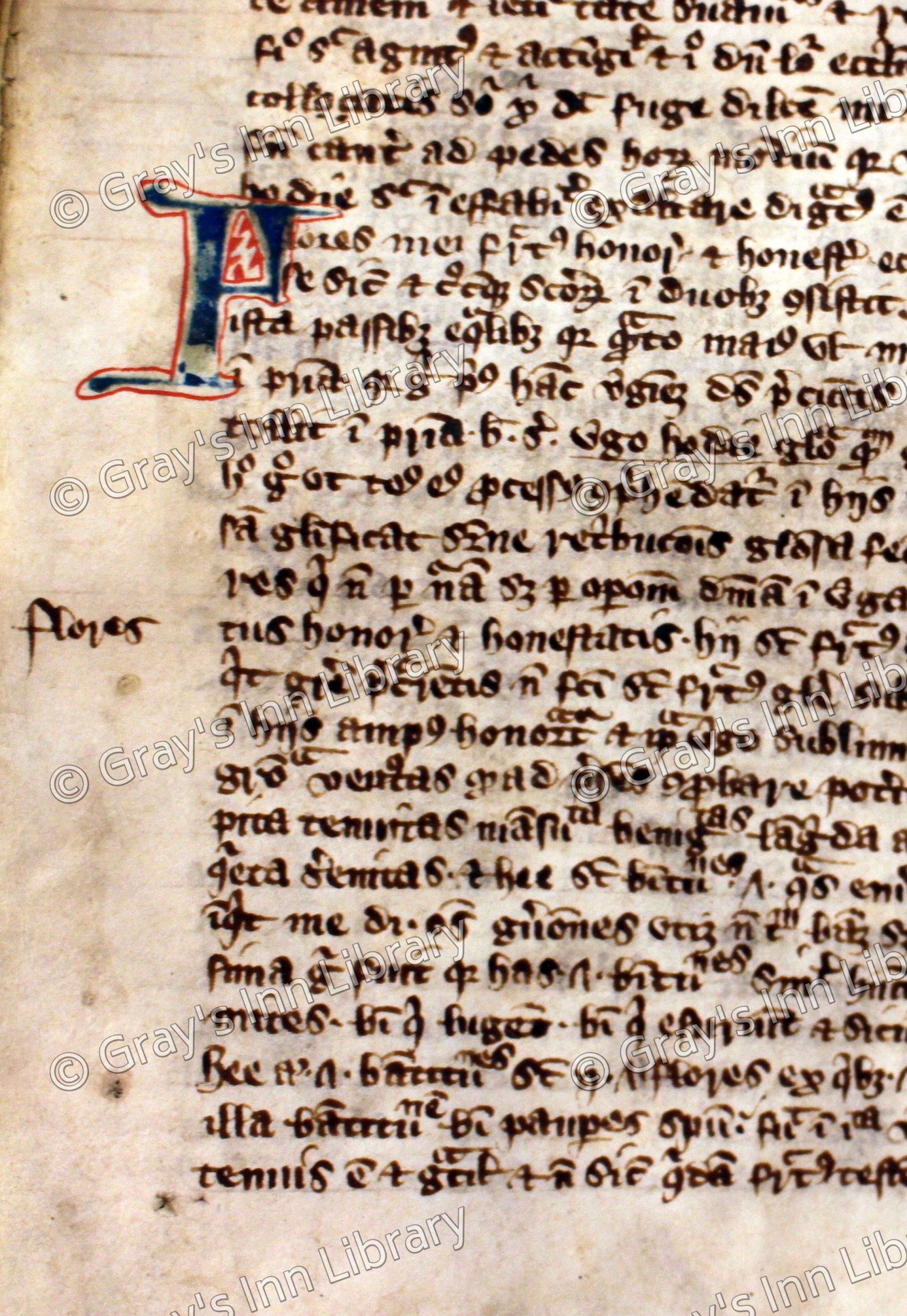
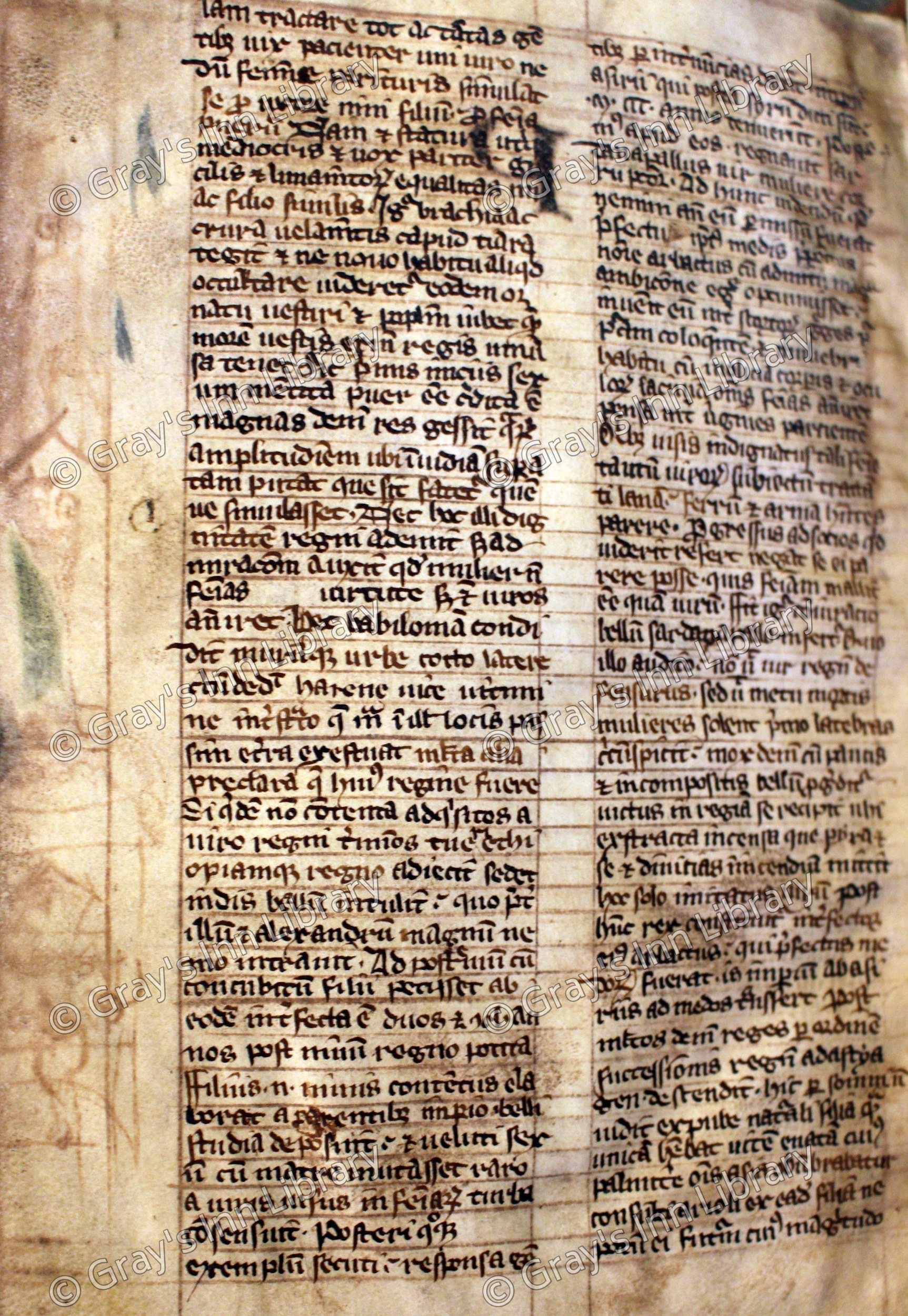 I. Petri Blesensis Epistolae, 108 in number - folio 1a - 54a
II. Daretis Phrygii narratio de Trojano excidio - folio 54 - 60a
III. Vera historia de morte Arthuri - folio 60a - 61a
I. Petri Blesensis Epistolae, 108 in number - folio 1a - 54a
II. Daretis Phrygii narratio de Trojano excidio - folio 54 - 60a
III. Vera historia de morte Arthuri - folio 60a - 61a
Begins - Igitur finito prelii certamine.
Ends - Constantinus Cadori ducis filius britannicum adeptus est regum.
IV. Rosarium beate Marie Virginis - folio 62a - 138bA series of 25 discourses on the Virgin Mary. At the head, in a different hand, is "Prologus fratris Roberti de Ware in rosarium beate marie virginis gloriose."
Begins - A me rosarium scripturarum.
Ends - Sint aliis alia, mea porcio virgo maria.
At the foot of the 1st page of this work is the note: "Iste liber est de communitate fratrum minorum cestrie, per fratrum W. Gyn."
The name of Robert de Ware does not occur in Oudin, or in Cave, or in Fabricius.
It appears, from the Prologue (which the author addresses to his brother John), that he was the eldest son of his father, and was devoted to study from an early age, and went to Oxford, and at length entered the order of Minorites. His father was much enraged, and employed his own entreaties, and sent his wife and other children, to endeavour to reclaim Thomas; and commenced proceedings in the Court of Othobon, then Legate in England, to withdraw him, but failed for want of Thomas's consent. He was consequently very angry, and would neither speak to nor see his son. One day, when Thomas and some of the brethren were at the gate, the father threatened to kill him with a sword if he tried to enter. The father afterwards fell ill, and had a vision, in consequence of which he was reconciled to his son.
V. Tractatus domini pape Innocentii tercii de contemptu mundi - folio 138b - 147b(Printed, generally, under the title "Lotharius de miseria humanae conditionis.")
VI. Testamentum duodecim Patriarcharum - folio 147b - 158b(The Latin translation, several times printed, by Robert Grostête, bishop of Lincoln).
VII. Apologie Anselmi - folio 159a - 170bBegins - Cum ex rebus non fictis
Ends - Et per hoc ad supernam patriam fideliter pervenire.
This is not mentioned in the list of Anselm's works given by Oudin.
VIII. Collaciones (de temporali) fratris Bertrandi Cardinalis de ordine fratrum minorum - folio 171a - 1009b. An index follows, extending to folio 1012a. IX. Collaciones (de Sanctis) fratris Bertrandi Cardinalis ordinis fratrum minorum - folio 1013a - 1031b(Cardinal Bertrand died A.D. 1348 or 1349. These works are not mentioned by Oudin.)
X. Collaciones fratris Thome de Braundestone - folio 1031b - 1034b(Sermons for the four Sundays in Advent. This author is not mentioned by Cave, Oudin, or Fabricius.)
XI. Sermons for the four Sundays in Advent and succeeding feasts - folio 1036a - 1044b XII. Trogus Pompeius - The prologue and part of the history - folio 1045a - 1048aThree old parchment fly-leaves at the beginning of the volume are occupied with portions of treatises of Physics, and the 3rd has a table of contents.
Taken from 'A Catalogue of the Ancient Manuscripts Belonging to the Honourable Society of Gray's Inn' by Alfred Horwood, published 1869. Make a request to view this manuscript.Manuscript 8
L'Horloge De Sapience, by Jehan de Souabe
- 15th Century (in French)
- 119 leaves of vellum
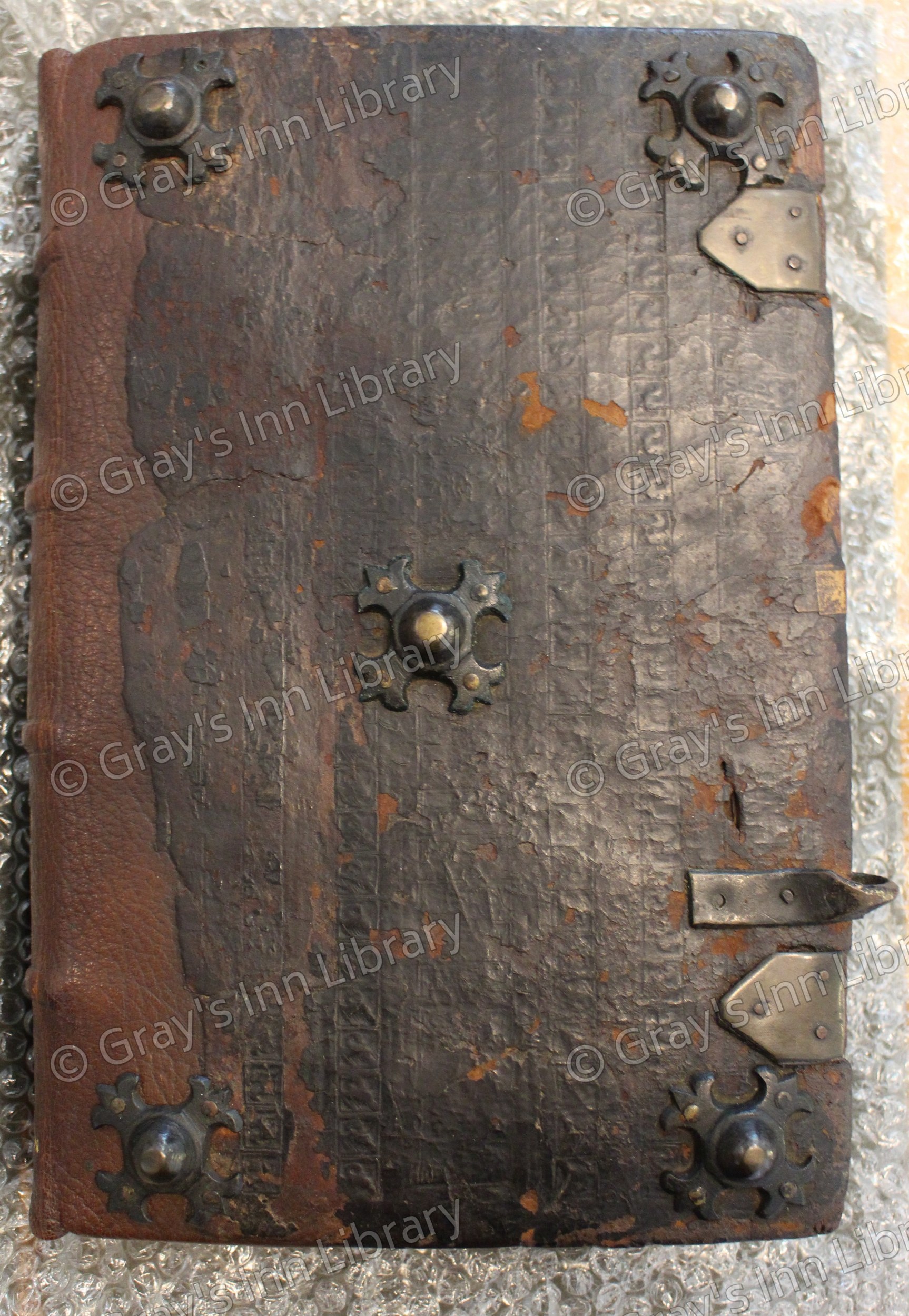
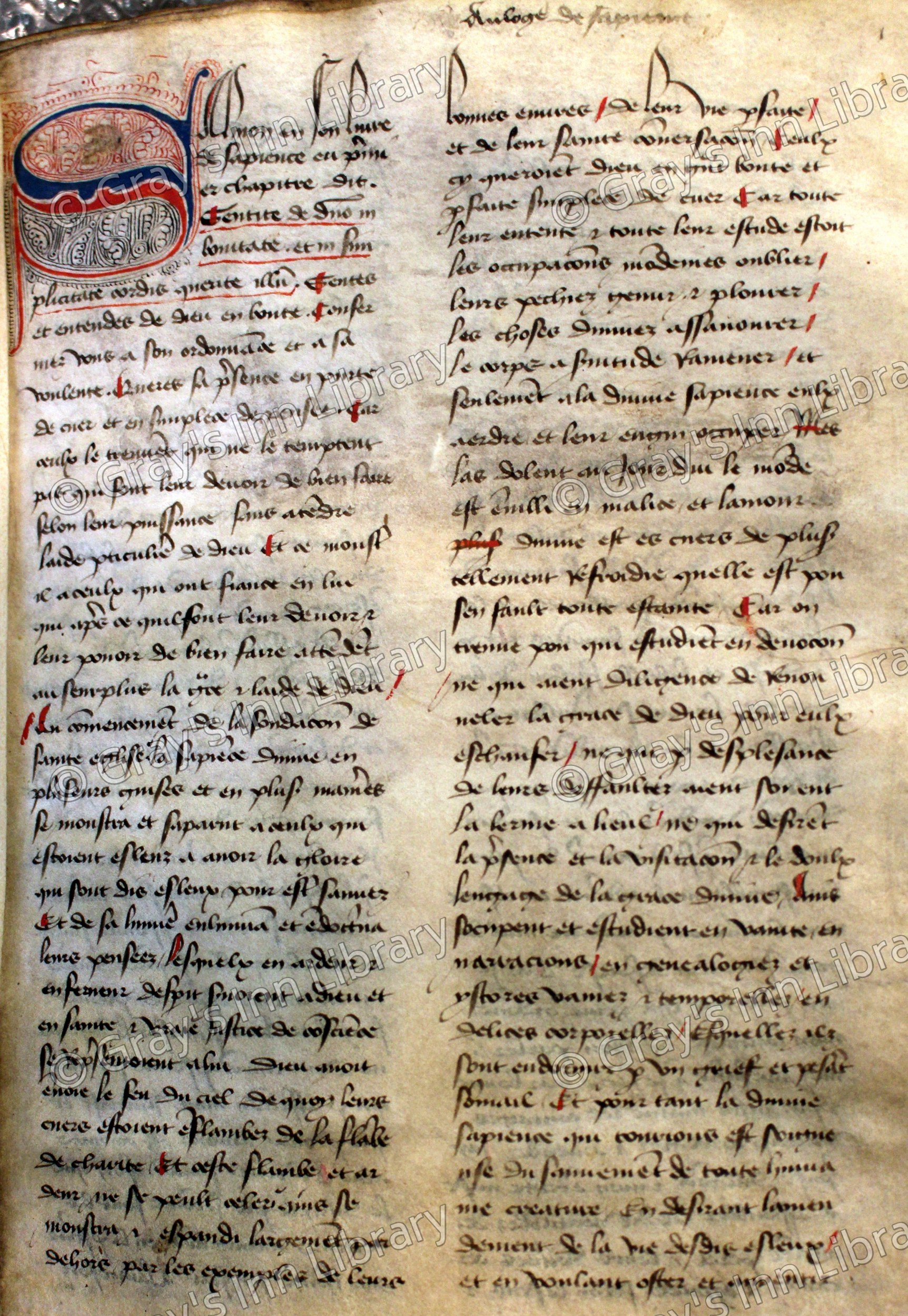
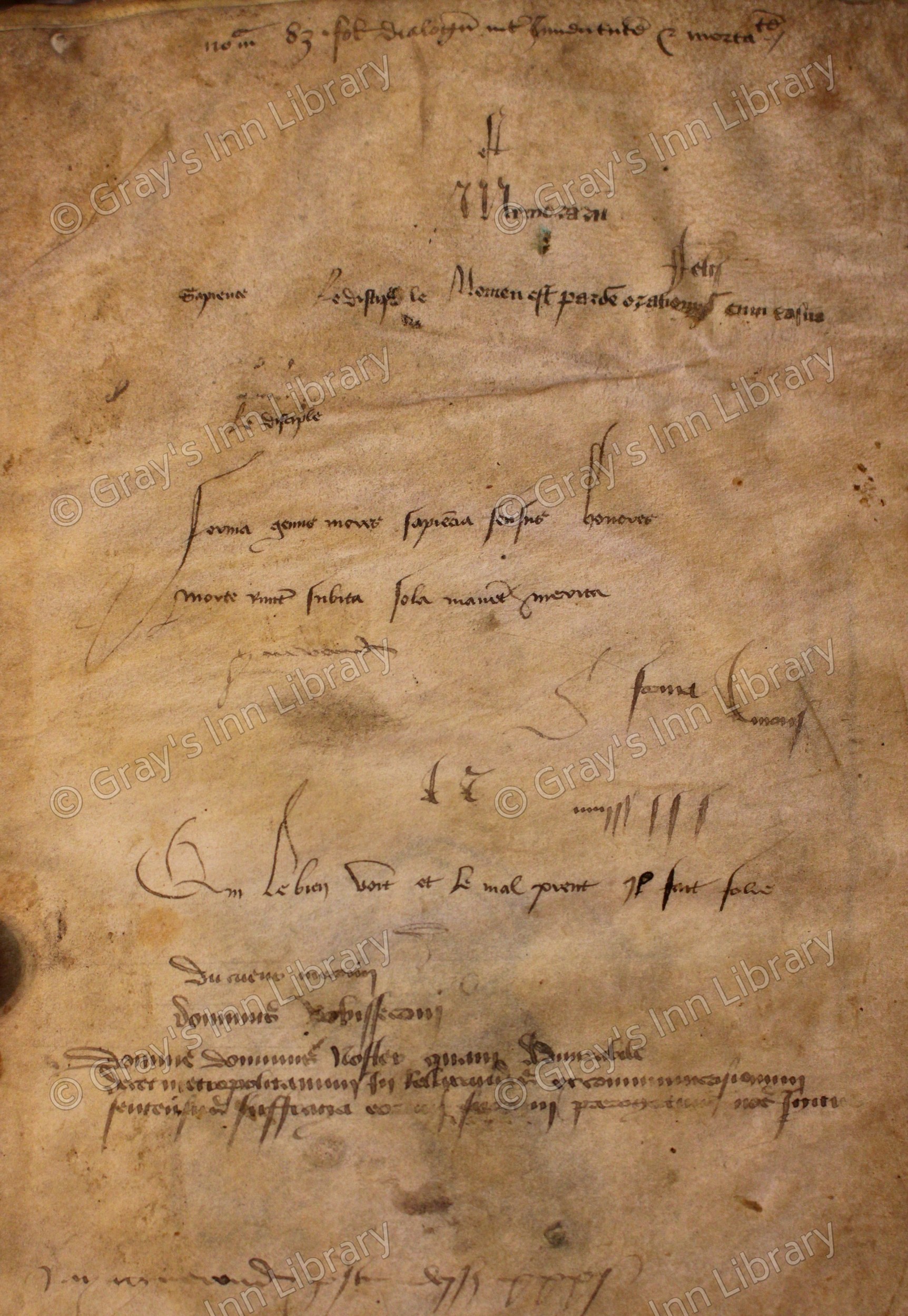 Begins - Salomon en son livre de Sapience
Ends - Cy fine le livre que est dit auloge de Sapience le quel fist frere Jehan de Souhaube de lorde des freres prescheours. Escript lan mil IIII ͨ. xxxiii. (1433) le samedi dapres le saint sacrement en juing.
On the second fly-leaf at the beginning is the name J. Pye in writing of the 15th century.
There is no leaf numbered 77, but the volume is perfect.
In the 4th volume, p. 155, and the 7th volume, p. 262, of "Les Manuscrits François de le bibliothèque de Roi," M. Paulin Paris gives accounts of several MS. copies of this work. It was composed, in Latin, near the end of the 14th century. The name of the translator into French does seems to be ascertained. It is a didactic work, Wisdom and her disciple being confabulators. The Latin text and this French version have both been printed.
Taken from 'A Catalogue of the Ancient Manuscripts Belonging to the Honourable Society of Gray's Inn' by Alfred Horwood, published 1869.
Make a request to view this manuscript.
Begins - Salomon en son livre de Sapience
Ends - Cy fine le livre que est dit auloge de Sapience le quel fist frere Jehan de Souhaube de lorde des freres prescheours. Escript lan mil IIII ͨ. xxxiii. (1433) le samedi dapres le saint sacrement en juing.
On the second fly-leaf at the beginning is the name J. Pye in writing of the 15th century.
There is no leaf numbered 77, but the volume is perfect.
In the 4th volume, p. 155, and the 7th volume, p. 262, of "Les Manuscrits François de le bibliothèque de Roi," M. Paulin Paris gives accounts of several MS. copies of this work. It was composed, in Latin, near the end of the 14th century. The name of the translator into French does seems to be ascertained. It is a didactic work, Wisdom and her disciple being confabulators. The Latin text and this French version have both been printed.
Taken from 'A Catalogue of the Ancient Manuscripts Belonging to the Honourable Society of Gray's Inn' by Alfred Horwood, published 1869.
Make a request to view this manuscript.
Manuscript 9
Speculum Humane Salvacionis, &c.
- 15th Century
- 123 leaves of parchment
- Numeration begins with 31: folios 87, 148 and 149 are absent; folio 56 is bis
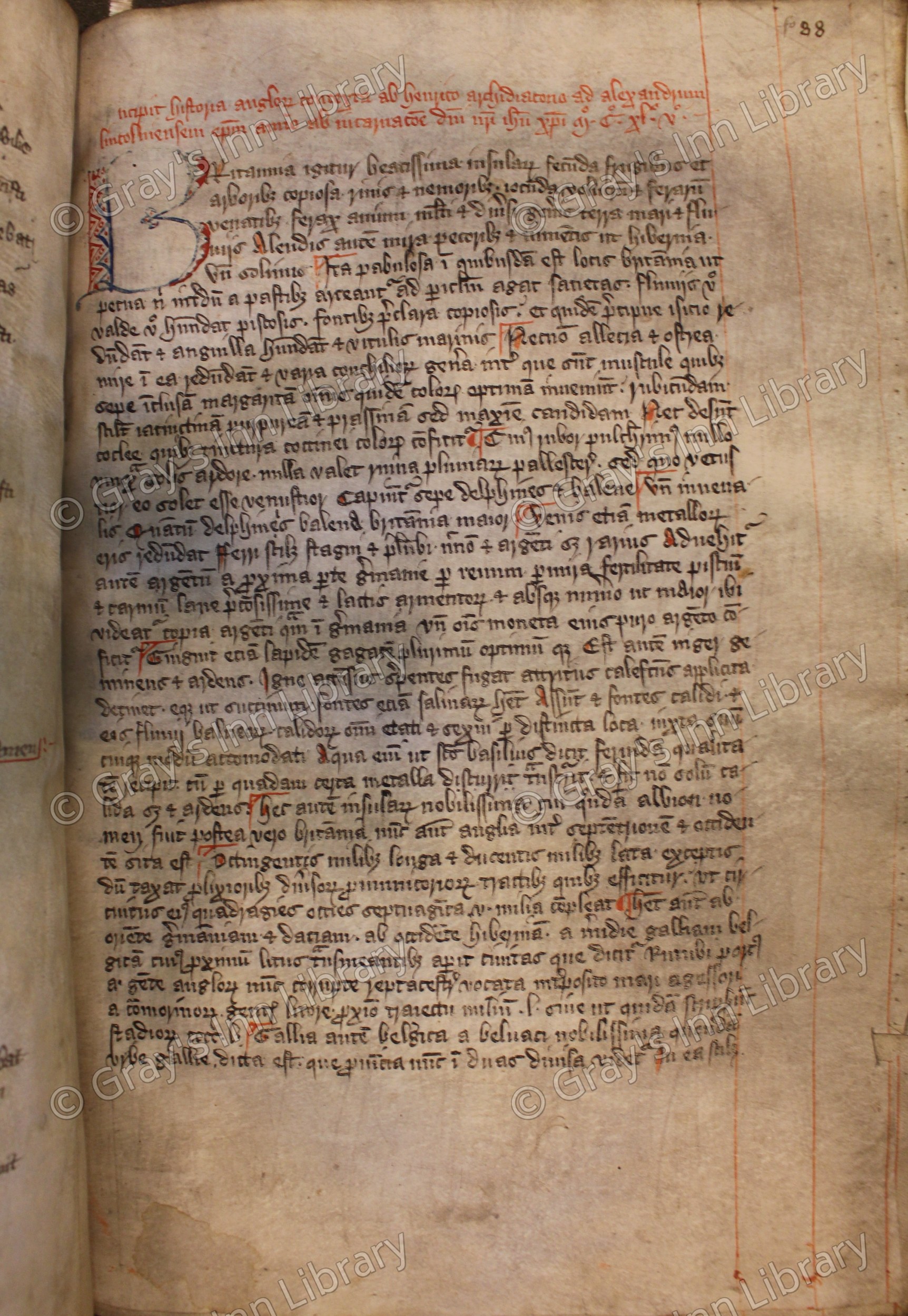
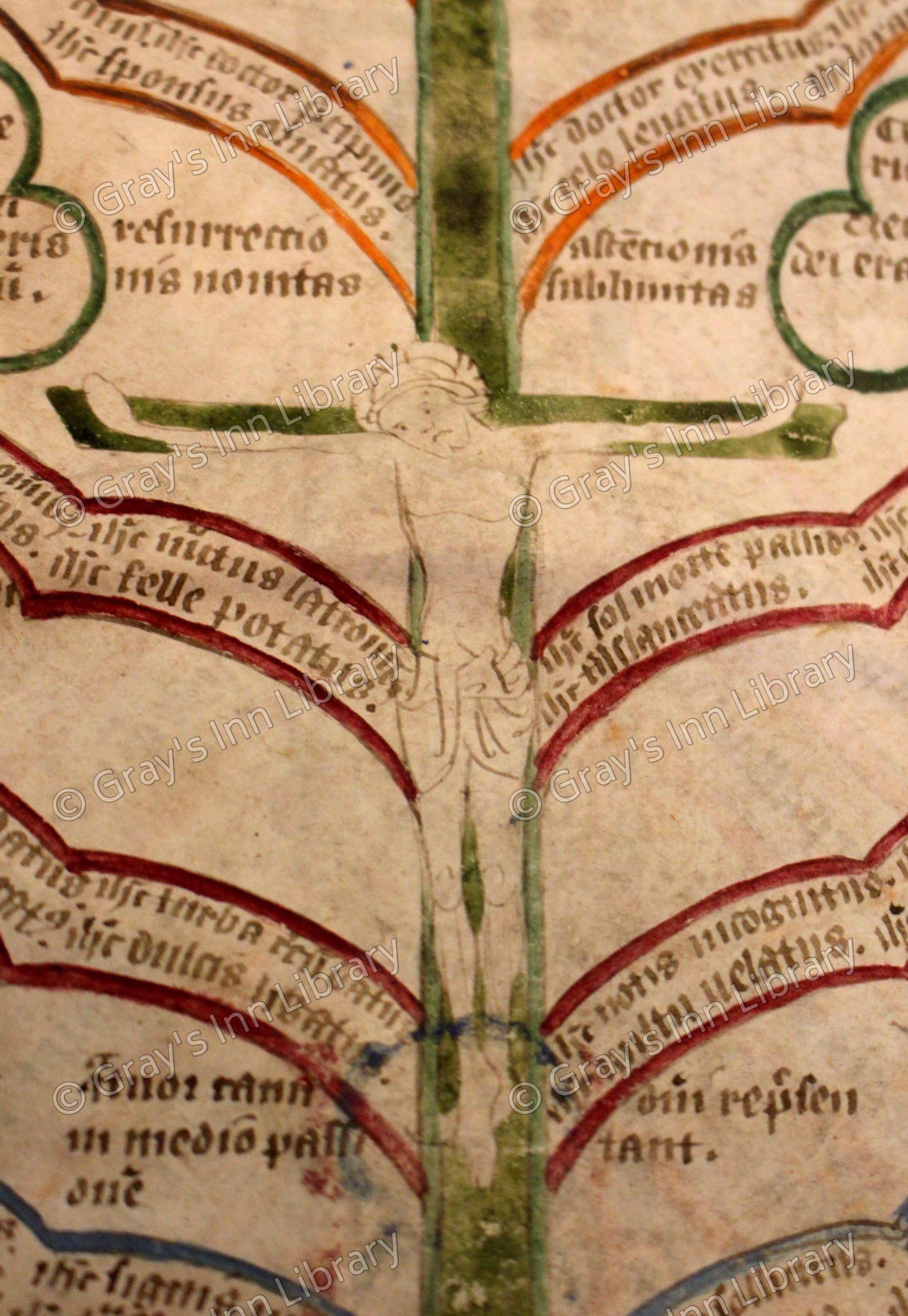
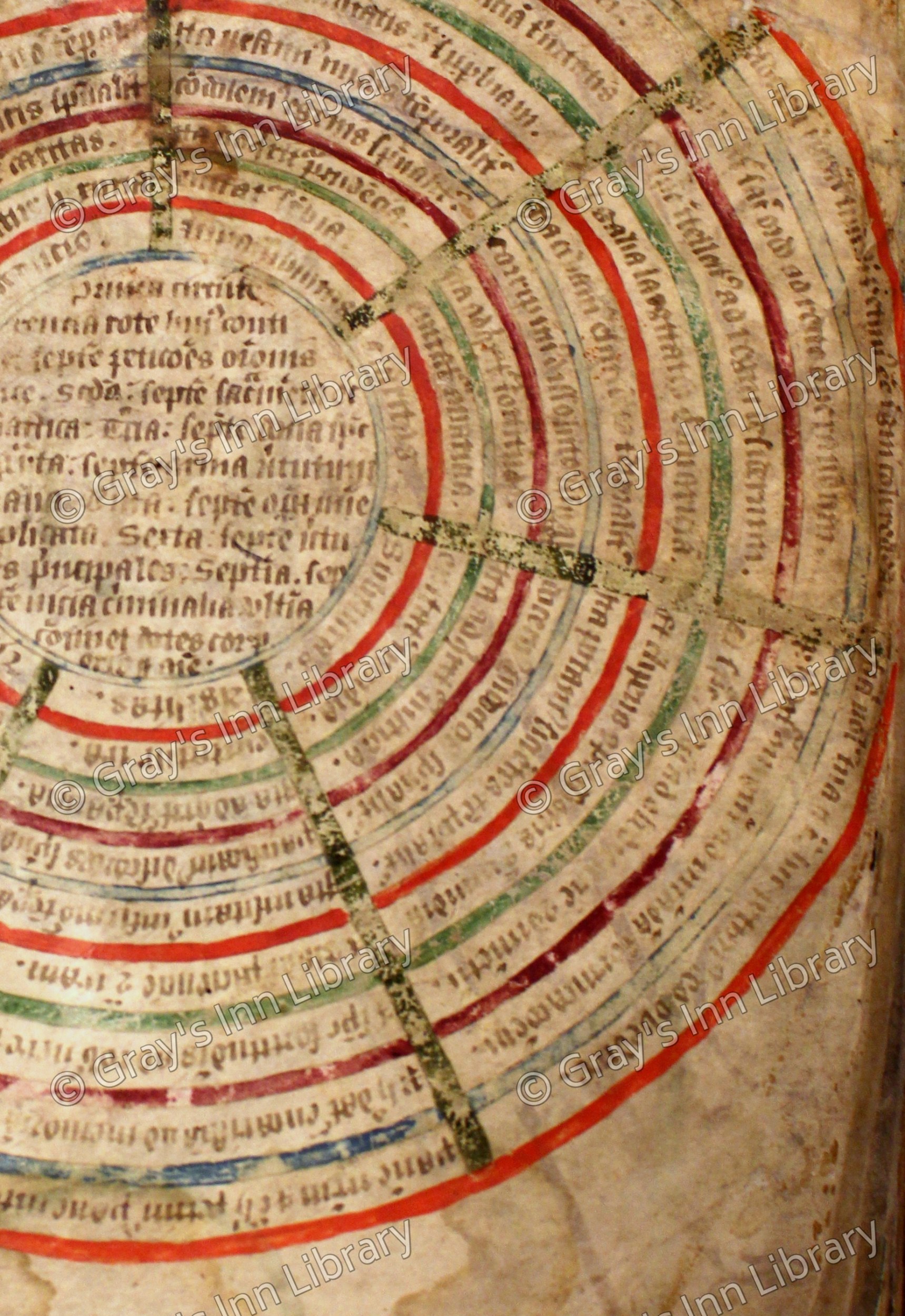 I. Alphabetical index to the Speculum - folio 31 - 32a
I. Alphabetical index to the Speculum - folio 31 - 32a
Prohemium to the Speculum - folio 32a - 35a
Incipit Speculum humane salvacionis - folio 35a - 86b. The concluding eight lines of the poem are wanting, folio 87 being absent. The work is in long lines, commencing:-
Incipit prohemium cujusdam nove compliacionis
Cujus nomen et titulus est speculum humane salvacionis.
It is the text to the celebrated Block Book with the same title. Also it was printed in small 4to, Paris, 1503, the proemium and table being there placed at the end of the work.
II. Incipit historia anglorum contexta ab Henrico archidiacono ad Alexandrum lincolniensem episcopum anno ab incarnacione domini nostri Jesu Christi M ͦ.C ͦ.xl ͦ.v ͦ.Begins - Britannica igitur beatissima insularum - folio 88. From 88a - 90 b the manuscript agrees with the printed text (Henry of Huntingdon) in "Scriptores post Bedam", fol. Lond. 1596. Thence to the end of the chapter, on 97b, is an abbreviation of the original. From 97b to 112b it nearly agrees with the print, the chief difference being that the years are indicated by numerals in the margins instead of being incorporated with the text. After the account of the death of Wm. I. the manuscript adds the word Amen. The 7th book of H. Huntingdon is omitted. Folio 113a of the manuscript takes up the 8th book (King Stephen), and goes on to 118b, in accordance with the printed text, to the end of the 13th year of King Stephen. Folio 119 and part of 120 are occupied with hexameters containing a brief history of England from Alfred to Henry II., and the remainder of folio 120 is occupied with a royal genealogy from Rollo to the children of Henry III. (here called Henry IV), and the lengths of the reigns of the kings from Wm. I. to Hen. III.
III. 129a. Excerpciones de diversis auctoribus de monarchia Anglie de orbe terrarum et de ejus dimensione et divisione.Begins - Repertum est quod omnis orbs habet famosa maria xxx. (The extracts seems to be from Beda, Solinus, Isidore, Higden and Giraldus Cambrensis).
136a. Explicit pars prima. - Nomina regum Anglie qui fuerunt in ea ab inicio terre predicte. (A brief account of the succession of the kings of England from Brutus to Hen. IV., dates of coronations, years of death, and burials.)
138a. Descriptio Genealogie Comitum Cestrie et qua de causa comitatus Cestrie devenit ad manus primogenitorum regum Anglie.
141a. Explicit pars secunda. - Incipiunt guerre inter Angliam et Francian. Begins - Anno domini millesimo ccc ͫ ͦ. xxxvii ͦ. From 142b (accession of Rich. II.) the manuscript proceeds very much in the style of the "Brute" Chronicles. Down to the death of Rich. II. it is by a partisan of that king; then, 185b, col. 1, is an interpolation by the copyist or the composer of the following portion, stating that he finds much in his copy that is untrue, "et hoc scio pro certo, quia in multis locis interfui et vidi." The chronicle ends on 146a, after describing the battle of Shrewsbury and the execution of some of the rebels, with the words, Deditque rex graciam et pacem universis; citius causa metus quam amoris &c. ut quidam dixerunt. - Explicet tertia pars.
The original leaves 148 and 149 are absent.
IV. 150b - Begins, "Tria genera fidelium in ecclesia." - Ends, "Ad vindictam malorum et tutelam bonorum." It is a descriptive of a Tower of Wisdom composed by a certain Johannes Metensis; and folios 151 to 154 are occupied with rude drawings in colour to illustrate it. The volume ends with folio 154, but fragments of 2 more folios occupied by coloured drawings remain. The Tower of WisdomSo set up that the virtues that are the foundation of the Christian Edifice, that sustain it and defend it, are thrown into relief and set in due proportion. Thus, in the drawing:
- the FOUNDATION is shown to be HUMILITY
- the COLUMNS upon which the Christian Life is built are the four cardinal virtues; PRUDENCE, FORTITUDE, JUSTICE, TEMPERANCE
- the BREADTH of that life, or tower, is CHARITY (which St. Paul says "embraceth all things")
- the HEIGHT is PERSEVERANCE (he that shall persevere unto death shall be saved)
- the DOORS are obedience and patience
- then there are the WINDOWS, the CORNERSTONES, the GUARDIANS of the whole edifice
From left to right:
- the twelve major Prophets, Jeremiah to Ezechiel
- appropriate scriptural texts, to illustrate each article
- God Creator, Jesus Christ, etc. (i.e. what the content of each article is)
- I believe in God, etc. (i.e. the words of each article as said in creed)
- the twelve Apostles, Peter, John, etc. (in the Middle Ages each Apostle was taken to represent an article of the Creed)
The 'shamrocks' stemming from the tree contain appropriate quotations from Prophets.
Seven events of the Passion of Christ
- (Left) represented to us by the seven hours of the Divine Office:
- Matins.......Trial before Pilate
- Lauds........Scourging
- Prime........The Cross
- Tierce........Crucifixion
- Sext..........The Death
- None etc.
- Vespers
- Compline
- (Right) represented also how he suffered in his senses:
- Taste
- Smell, etc.
- Consent
- Freedom
HUMILITY is the ROOT and CHARITY (blue rings) the full flowering.
The Wheel of LifeEach circumference is made up of seven segments, thus, circumference 1 contains seven petitions of Lord's Prayer, 2 contains seven sacraments, 3 contains seven gifts of the Holy Ghost, etc.
There is nothing to show the ancient owner of this volume. Taken from 'A Catalogue of the Ancient Manuscripts Belonging to the Honourable Society of Gray's Inn' by Alfred Horwood, published 1869. Make a request to view this manuscript.Manuscript 10
Roman De La Rose and Testament De Jean De Meun
- 14th Century
- 161 leaves of parchment
- Gothic letter in double columns
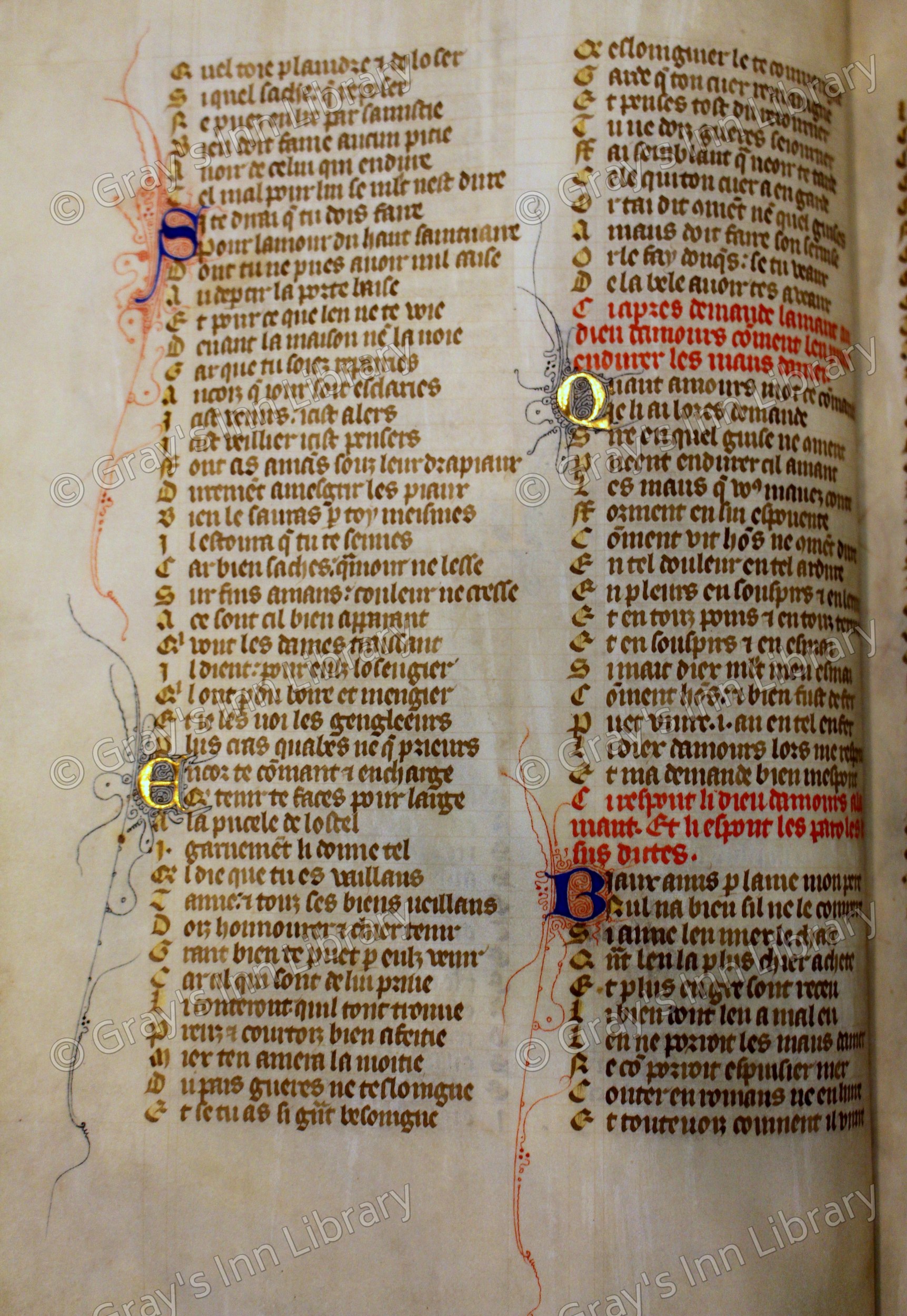
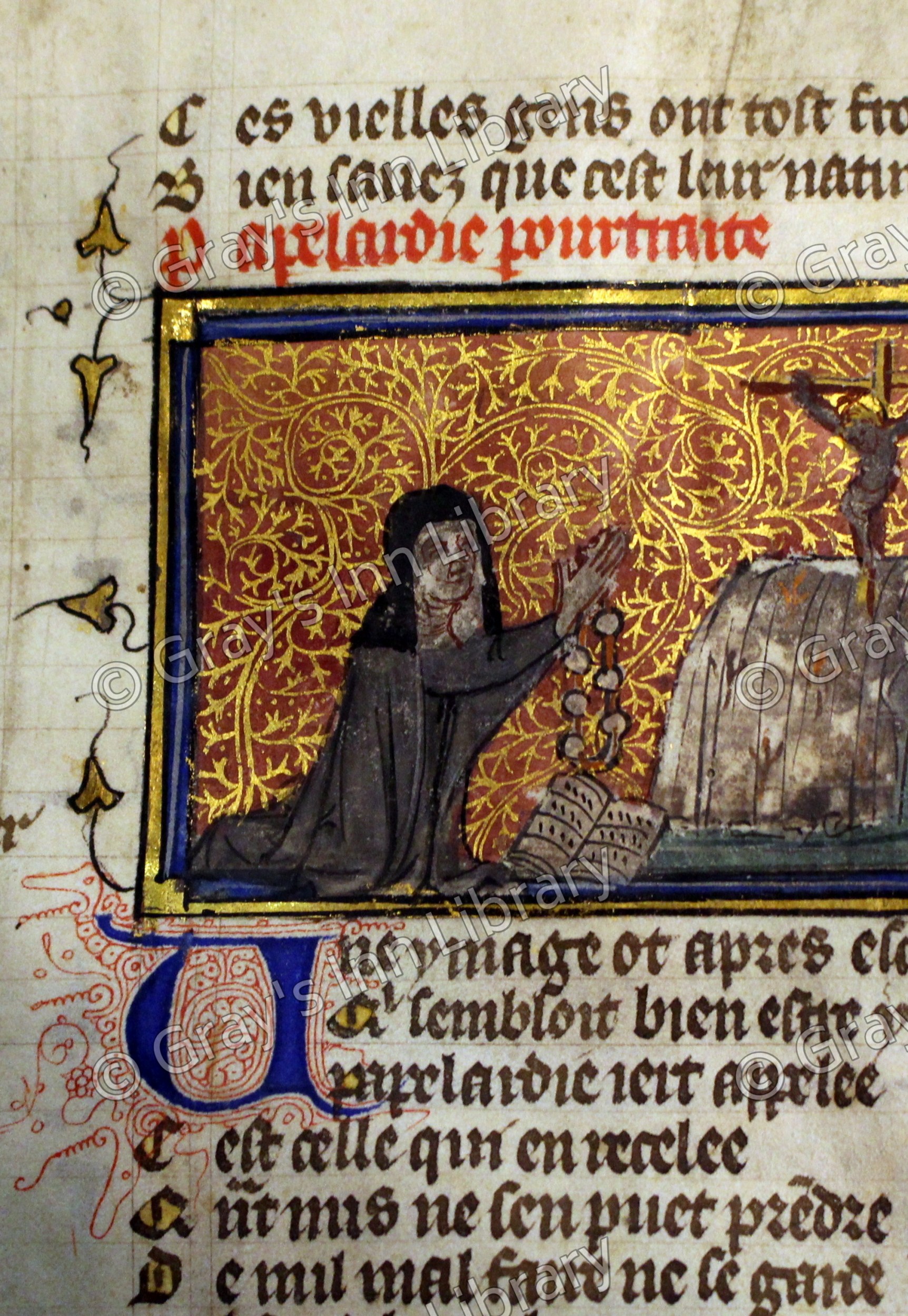
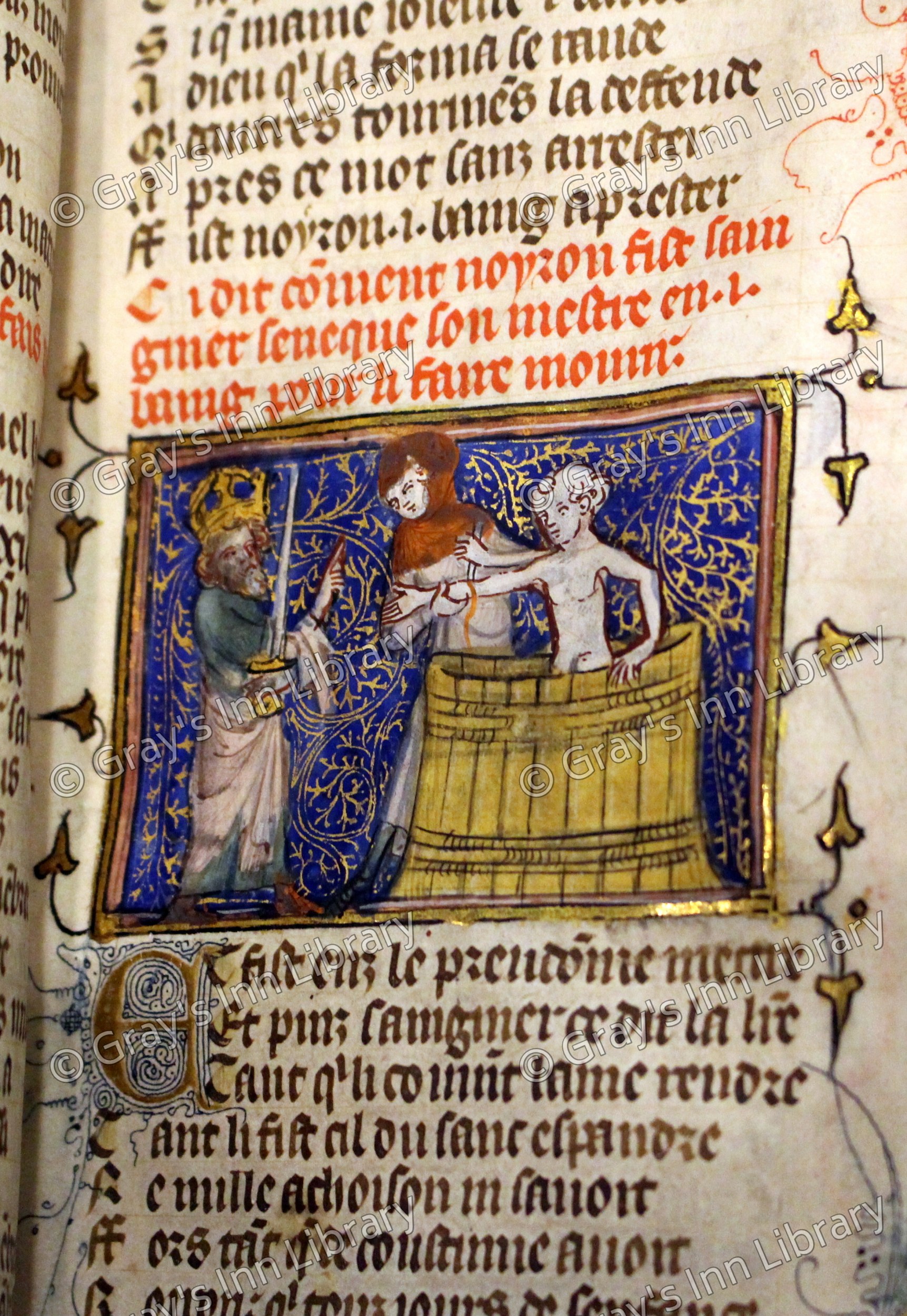 This manuscript contains 34 beautiful miniature drawings in colour, heightened with gold, each about three inches long by two inches wide; and a large drawing, occupying half of the folio 135a at the commencement of the Testament.
This is an early French poem of over 21,000 lines, written by two people, although not in collaboration, as they were unknown to each other, and there was a gap of some 40 years between the part begun by the first writer, and the commencement of the second part.
The first part was composed by Guillame de Lorris, (c. 1200-40), who took his name from a small town in the province of Loiret.
The second part was by Jean de Meun, (Meung), (c. 1250-1304), who was born at Meun-sur-Loire, and surnamed Clopinel (the Halt). He was considered to be one of the greatest poets and satirical writers of his day.
In the poem Guillaume de Lorris affirms his belief in the fulfilment of vision and dreams. He tells of a vision which befell him as a youth of twenty years. He entitled it "The Romance of the Rose", in honour of a lady with whom he was deeply in love.
In his dreams the poet is escorted by Idleness to a palace of Pleasure where he meets Love, accompanied by other human qualities, Riches, Jollity, Courtesy, Liberality and Youth, etc., who spend most of their time singing and dancing. Lorris is eventually conducted to a bed of Roses where he finds the only one he desires to possess. On attempting to pluck the Rose, he is struck by and arrow from Cupid's bow, and falls fainting to the ground. In this state he is carried far from the Rose.
On his recovery he determines to return to the palace once again to find his sweetheart. This time he is escorted by Welcome, but finds that time and again he is thwarted by the human frailties - Danger, Shame, Slander, Fear, etc. Reason advises him to abandon his search, but in vain, for he is stubborn. He is then joined in his fight by Pity and Liberality, until Venus allows him to kiss the Rose, and finally in the second part of the story, he is allowed to possess the loved one for himself.
The first two leaves of the Romance of the Rose are unfortunately absent: thus about 222 lines of the poem are wanting. The first line here is, Avarice en sa main tenoit. That portion which was composed by Guillaume de Lorris terminates at folio 35a. The scribe in the miniature there, intended doubtless for Jean de Meun, has the tonsure. The Roman de la Rose ends on 134b. And the Testament de Jean de Meun begins on 135a with the words
This manuscript contains 34 beautiful miniature drawings in colour, heightened with gold, each about three inches long by two inches wide; and a large drawing, occupying half of the folio 135a at the commencement of the Testament.
This is an early French poem of over 21,000 lines, written by two people, although not in collaboration, as they were unknown to each other, and there was a gap of some 40 years between the part begun by the first writer, and the commencement of the second part.
The first part was composed by Guillame de Lorris, (c. 1200-40), who took his name from a small town in the province of Loiret.
The second part was by Jean de Meun, (Meung), (c. 1250-1304), who was born at Meun-sur-Loire, and surnamed Clopinel (the Halt). He was considered to be one of the greatest poets and satirical writers of his day.
In the poem Guillaume de Lorris affirms his belief in the fulfilment of vision and dreams. He tells of a vision which befell him as a youth of twenty years. He entitled it "The Romance of the Rose", in honour of a lady with whom he was deeply in love.
In his dreams the poet is escorted by Idleness to a palace of Pleasure where he meets Love, accompanied by other human qualities, Riches, Jollity, Courtesy, Liberality and Youth, etc., who spend most of their time singing and dancing. Lorris is eventually conducted to a bed of Roses where he finds the only one he desires to possess. On attempting to pluck the Rose, he is struck by and arrow from Cupid's bow, and falls fainting to the ground. In this state he is carried far from the Rose.
On his recovery he determines to return to the palace once again to find his sweetheart. This time he is escorted by Welcome, but finds that time and again he is thwarted by the human frailties - Danger, Shame, Slander, Fear, etc. Reason advises him to abandon his search, but in vain, for he is stubborn. He is then joined in his fight by Pity and Liberality, until Venus allows him to kiss the Rose, and finally in the second part of the story, he is allowed to possess the loved one for himself.
The first two leaves of the Romance of the Rose are unfortunately absent: thus about 222 lines of the poem are wanting. The first line here is, Avarice en sa main tenoit. That portion which was composed by Guillaume de Lorris terminates at folio 35a. The scribe in the miniature there, intended doubtless for Jean de Meun, has the tonsure. The Roman de la Rose ends on 134b. And the Testament de Jean de Meun begins on 135a with the words
Li peres et li filz
Et li sains esperis
.j. dieu en .iij persones
Aourez et chieris.
and ends on 161a. The text of both poems is good. Both have been often printed. On the fly-leaf at the beginning are the words, "Radus Egertone ar. est versus proprietarius hujus libri," in writing of the end of the 16th or beginning of the 17th century. Taken from 'A Catalogue of the Ancient Manuscripts Belonging to the Honourable Society of Gray's Inn' by Alfred Horwood, published 1869. Make a request to view this manuscript.Manuscript 11
Speculum Religiosorum, &c.
- 14th Century
- 167 leaves of parchment
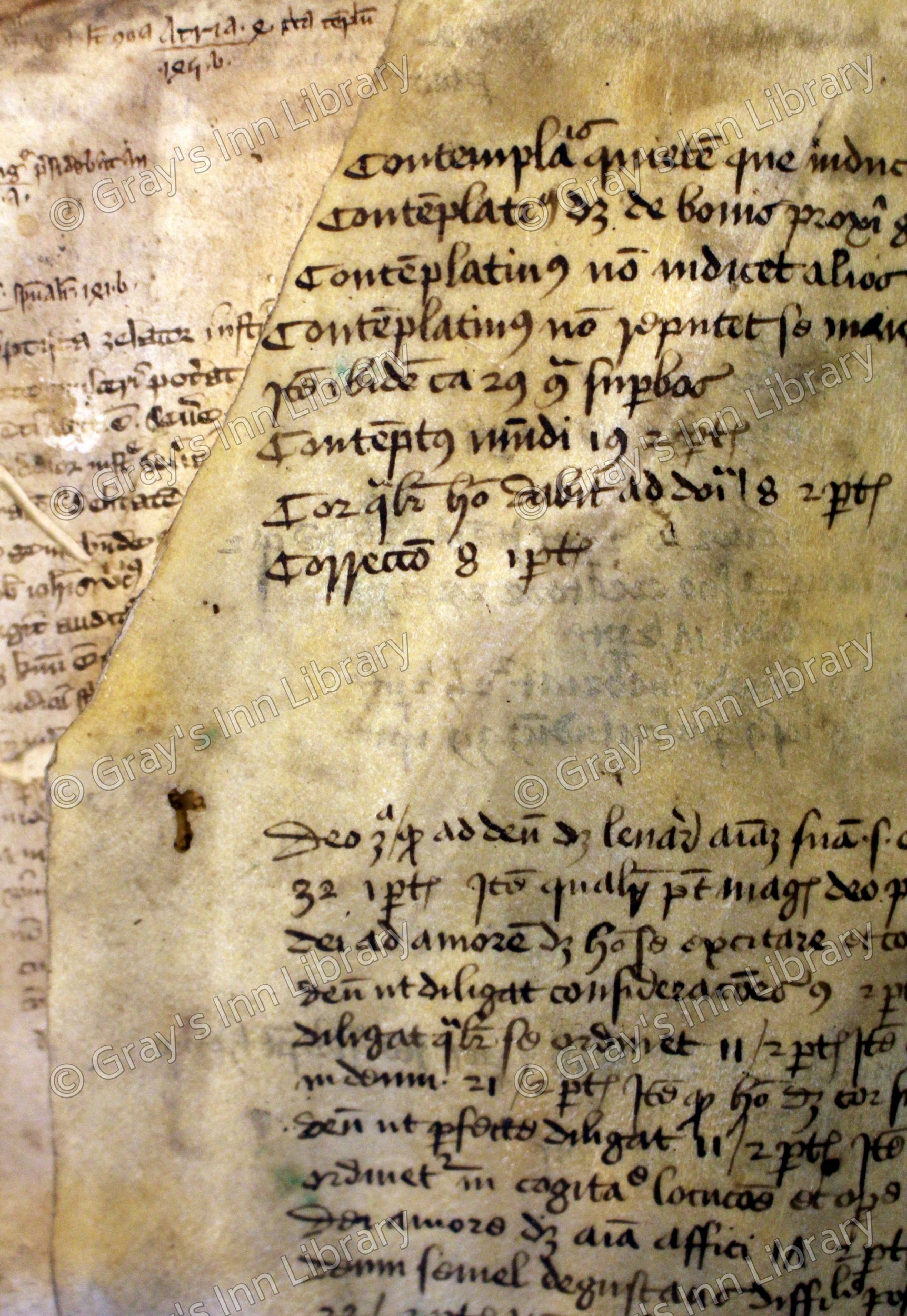
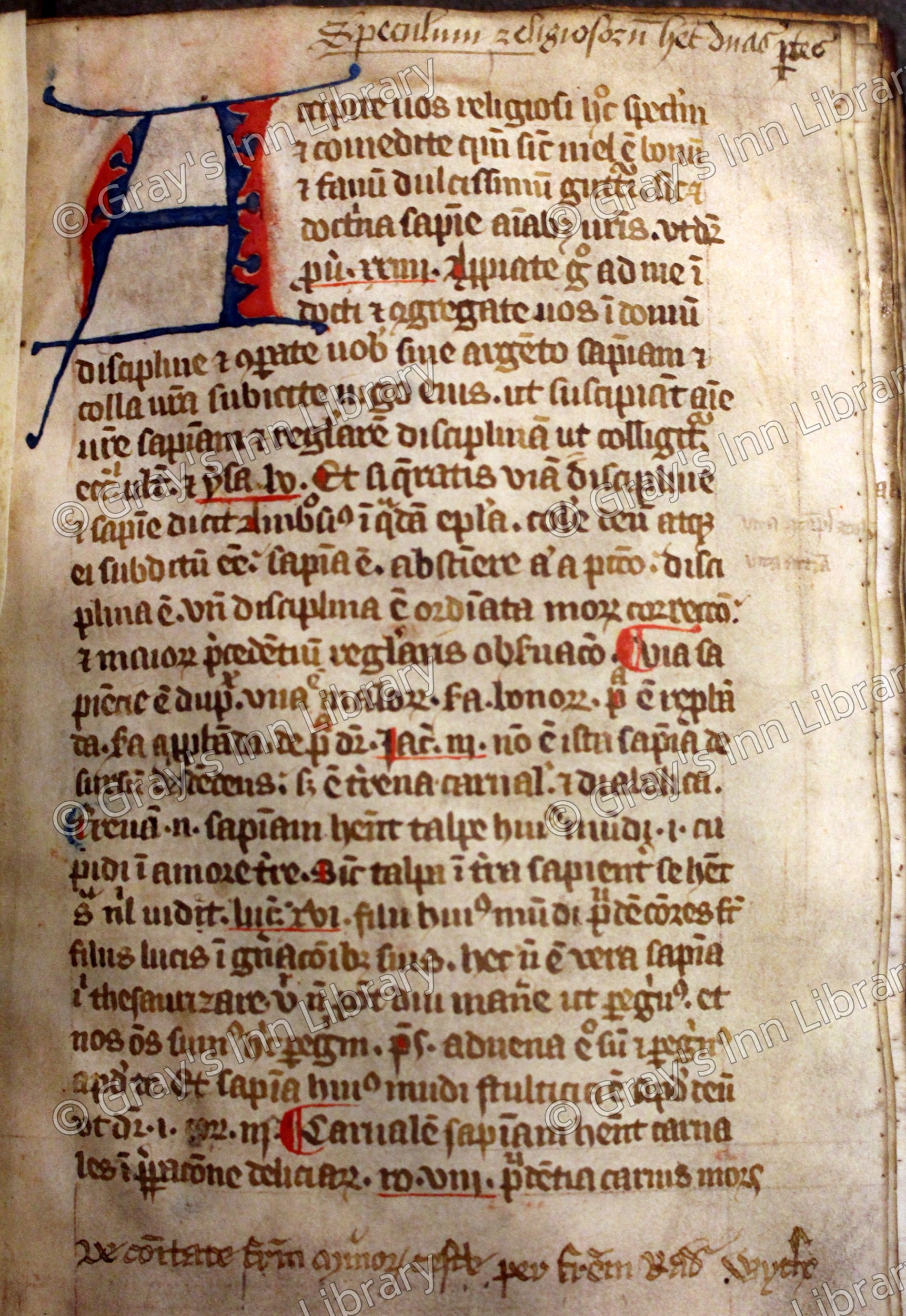
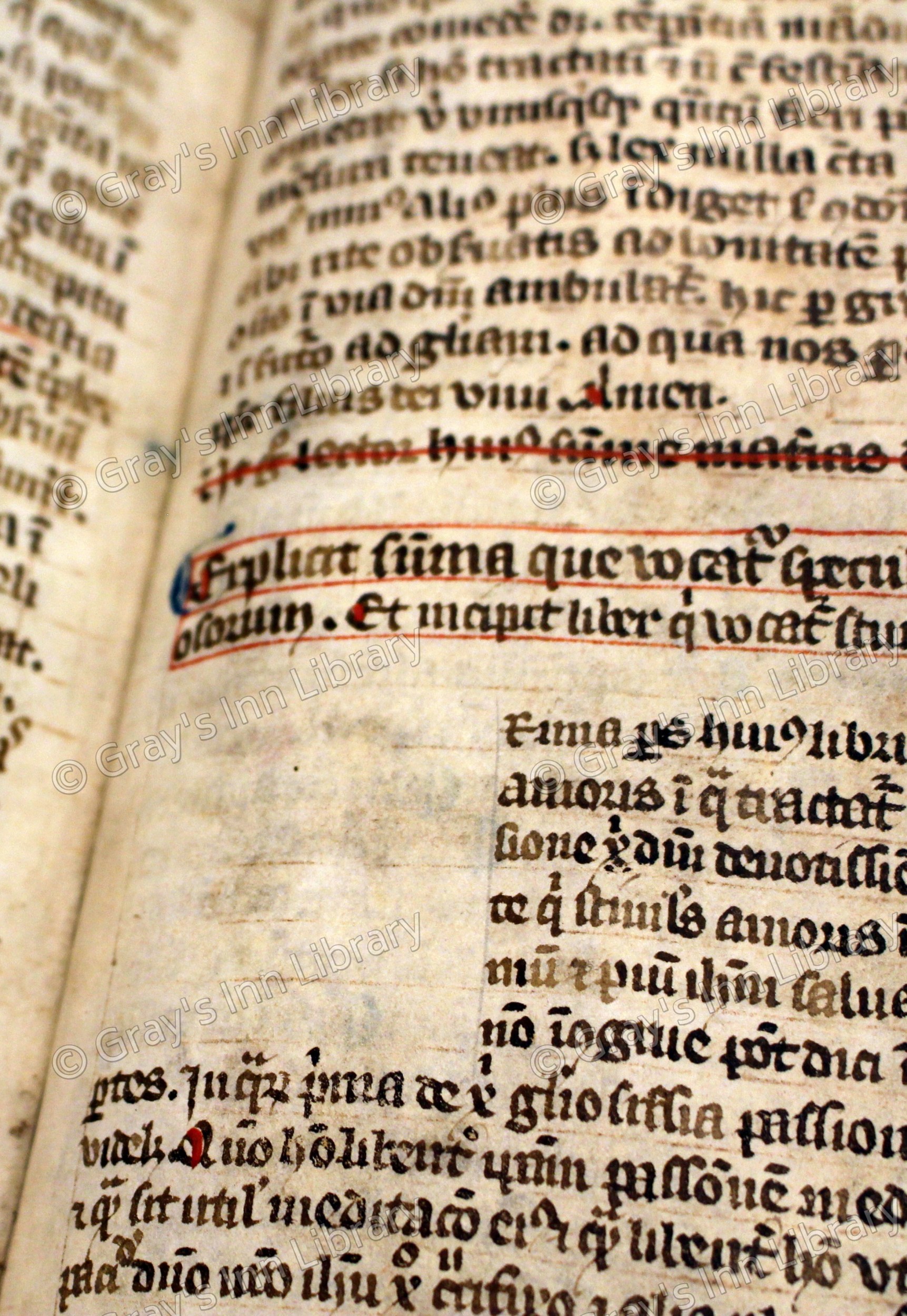 I. Speculum Religiosorum
I. Speculum Religiosorum
Begins, Accipite vos religiosi hoc speculum et comedite, quoniam sicut mel est bonum et favum dilectissimum gutturi, sic... At folio 101a is the rubric De contemplatione; and a later hand adds in the margin pars 2 capitulum primum.
Ends folio 165a - Et in futuro ad gloriam, ad quam nos perducat Jesus Christus filius dei vivi. Amen. Explicit summa que vocatur speculum religiosorum. Et incipit liber qui vocatur stimulus amoris.
II. Begins - Prima pars hujus libri dicitur stimulus......amoris in qua tractatur spiritualiter de passione Christi domini devotissime. Liber iste, qui stimulus in dilectissimum et pium Jesum Salvatorem nostrum non incongrue potest dici, in tres dividitur partes. Then follows a short note of the contents of the three books, and of the head of the chapters of the first book, for one of which the author refers alio libro post capitulum de contemplatione: and accordingly the subject is found in the Speculum Religiosorum at folio 104a. The manuscript ends with the chapter of the first book, intituled, De septemplici assensu contemplacionis secundum septiformam graciam spiritus sancti.
Ends folio 167b - In illa beatissima passione. On the verso of the first fly-leaf are notes on John the Baptist. The second, third, fourth and part of the fifth fly-leaves are occupied with an Alphabetical Table to the Speculum Religiosorum. The sixth is occupied with a table of the chapters of the first and second parts of the same work. At the foot of folio 1 of the text is the note, De communitate fratrum minorum Cestrie per fratrem Rad ͫ Wyche.
Both treatises are attributed to Bonaventura; but the latter, according to Oudin and the Cologne edition of 1502, should rather be assigned to Henricus de Balma, who died in 1439. The Stimulus Amoris is rather a long treatise, but only the first three leaves are here. Taken from 'A Catalogue of the Ancient Manuscripts Belonging to the Honourable Society of Gray's Inn' by Alfred Horwood, published 1869. Make a request to view this manuscript.Manuscript 12
- 14th Century
- 286 leaves of parchment
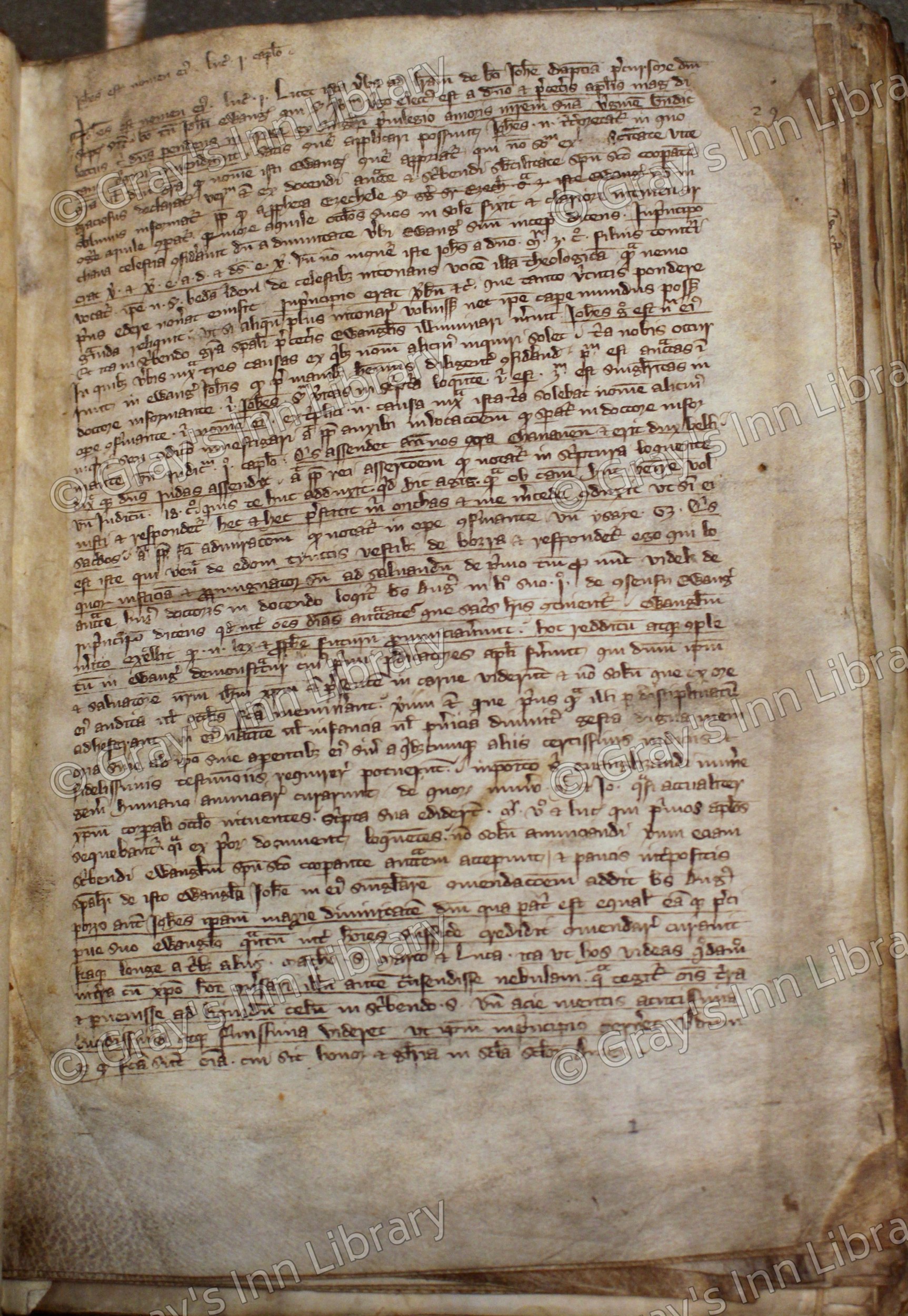
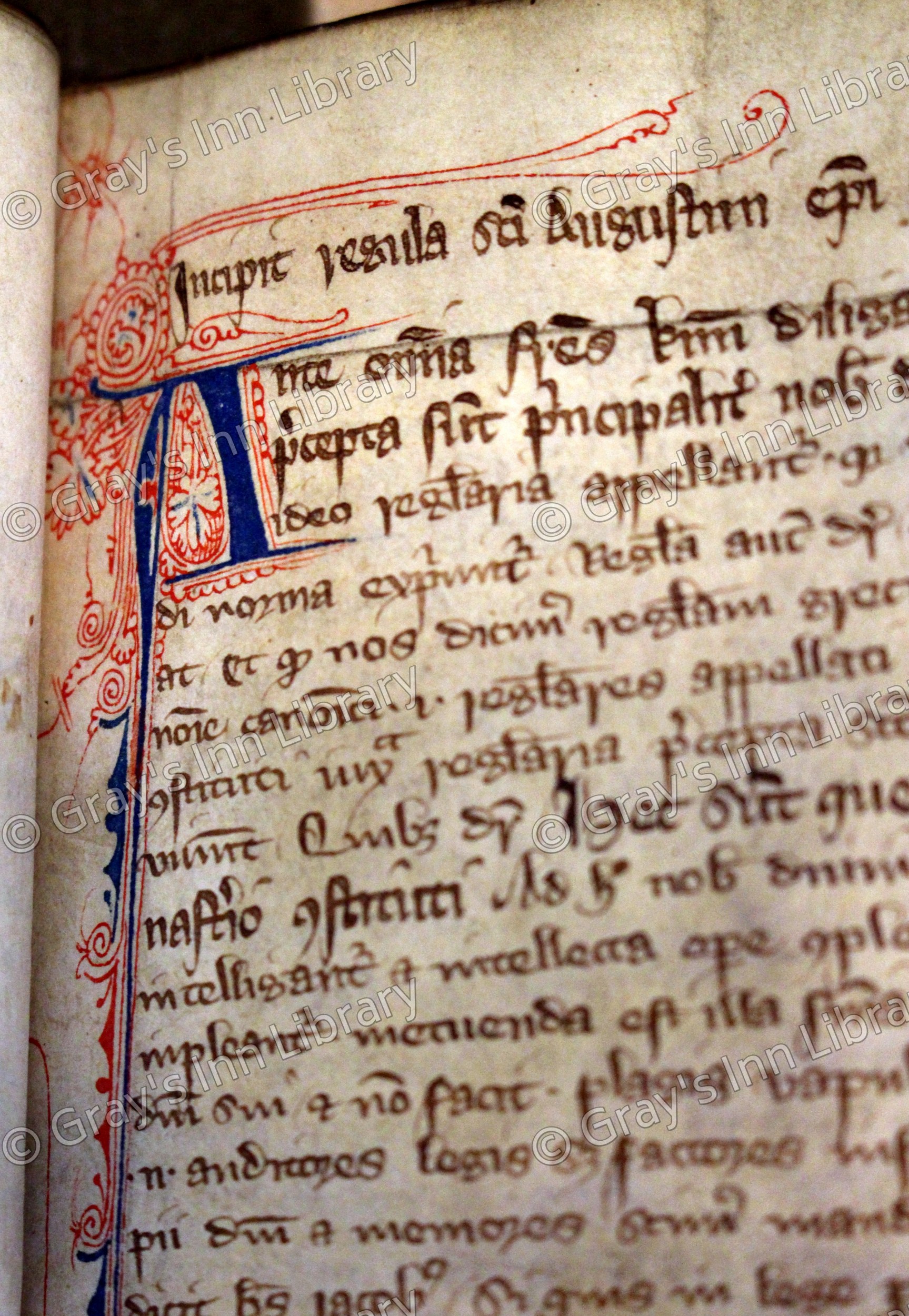
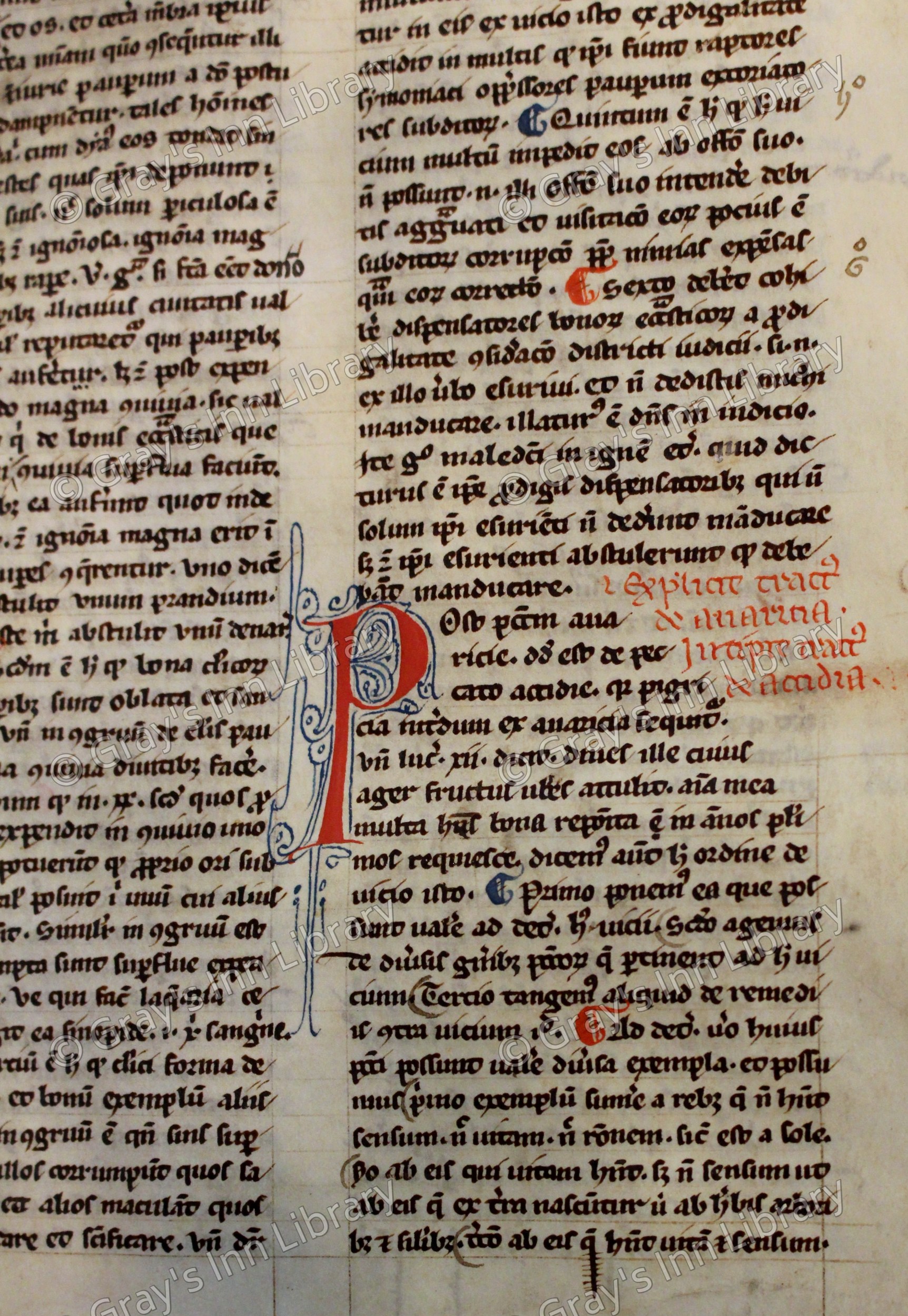 Contents:
Contents:
I. Two Latin sermons: one on the text, His name is John (Luke i.); the other on the text, Turn ye unto me (Joel ii.) - folio 1a - 8a
II. Ars predicandi.
- Begins - omnis tractatio divinarum scripturarum ut ait Augustinus in libris quatuor de doctrina Christiana.
- Ends - Commendat in eo dignitatis fastigium Rex Judeorum - folio 8a - 12a
III. A Latin sermon on the text, I have set watchmen on thy walls, O Jerusalem (Isaish lxii.) - folio 12a - 13b
- Begins - Rex habens duas civitates.
- Ends - Prelati tenentur esse soliciti custodiendo gregem sibi commissum propter committentis auctoritatem. De 3 ͦ cogita. Rogabimus dominum, &c.
IV. A table in Latin (to the next treatise), ending Explicit tabula metaphorarum secundum fratrem Nicholaum Bozon de ordine minorum - folio 15 and 16
A treatise in French, consisting of an introduction of nine lines and 146 numbered chapters - folio 17a - 49b
- Begins - En ceo petit liveret poet lem trover meynt beal ensaumple.
- Ends - e tot se dona a dieu loer e servir e bien vesqui e finy en le servise dieux omnipotente. Cui sit honor et gloria in secula seculorum. Amen.
This is a curious and amusing work, by an author whose name (Nicholas Bozon) is not mentioned by biographers. Nearly every section begins with a statement of the habits of some animal, or the qualities of some stone or herb; then follows a moralisation thereon; and, after the 13th chapter, a fable or a story is added. The sources of some of these are the Indian Fables, Æsop, the Disciplina Clericorum of Petrus Alphonsus, and the History of the Seven Sages. But the author also introduces stories of English life, and strictures on political and social matter in England. Chapters 91 and 92, respectively, begin with recipes for thinning and thickening the hair.
V. Incipit Regula Sancti Augustini episcopi cum comento Hugonis de Sancto Victore - folio 51a - 68b
- Begins - Ante omnia fratres.
- Ends - In tentationem non inducatur.
VI. Bonaventura de vita beate virginis - folio 69a - 78b
VII. Tractus moralis de spetem viciis capitalibus - folio 79a - 260b
- Begins - Tractus iste continet novem partes.
- Ends - Penituit tacere vero nunquam. Explicit summa de viciis.
VIII. [Tractus de quatuor virtutibus] imperfect at the end - folio 261a - 286b
- Begins - Postquam dictum est de morbis anime.
- Ends - Item virga portat aculeum qui pungit bovem, hamum qui capit piscem, viscum qui retardit...
Manuscript 13
Grostête De Homine Errato, &c.
- 14th Century
- 111 leaves of parchment
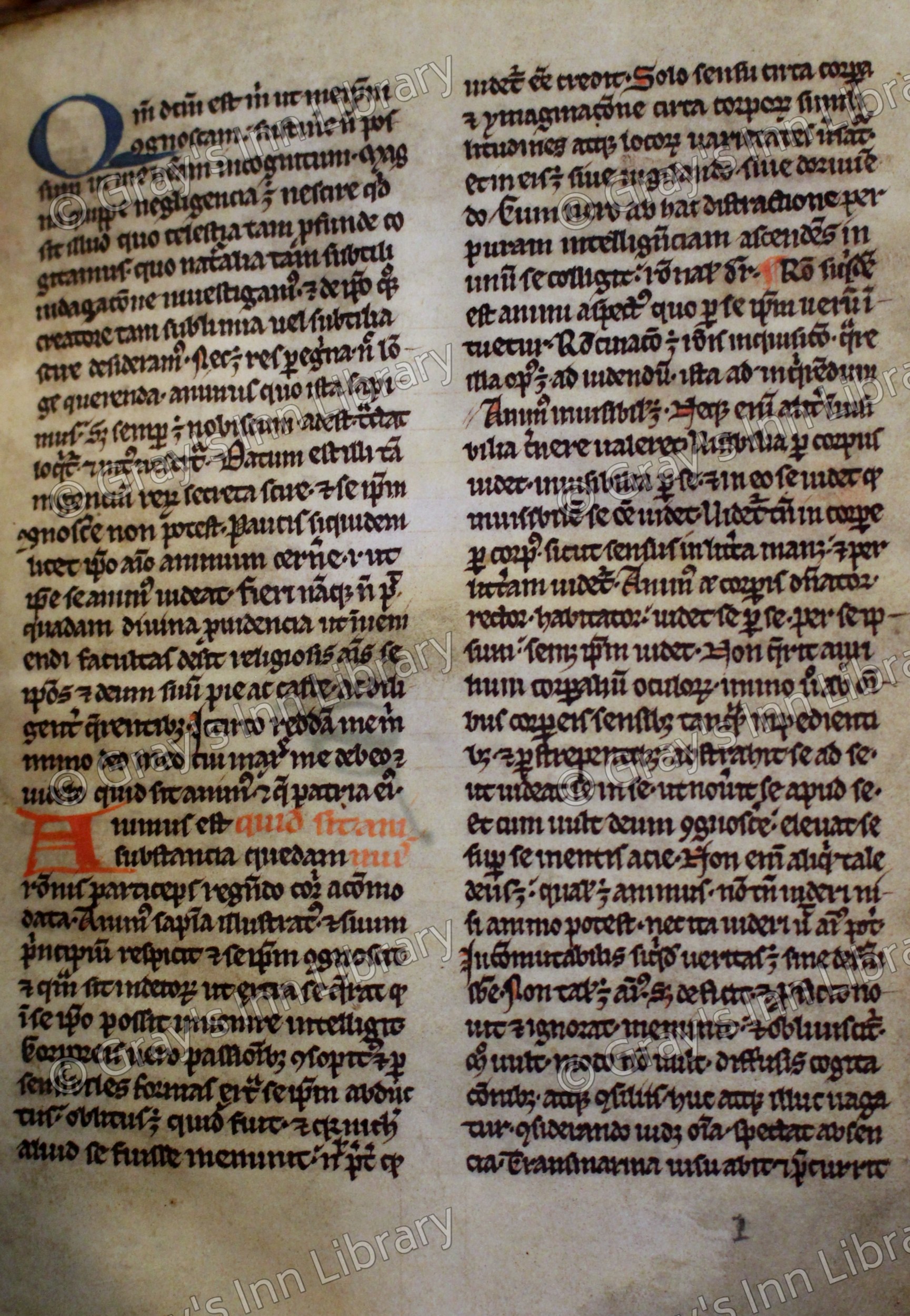
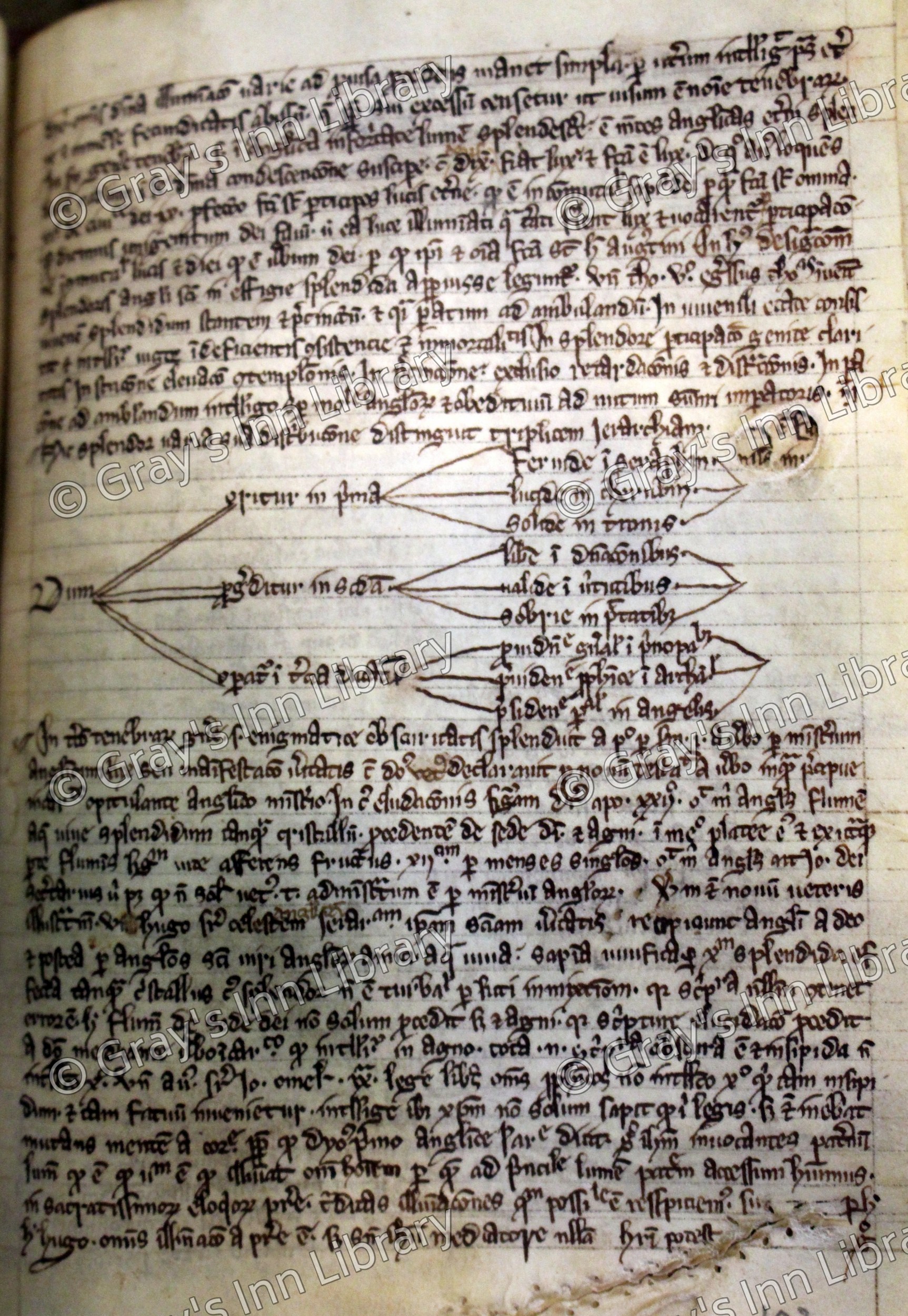
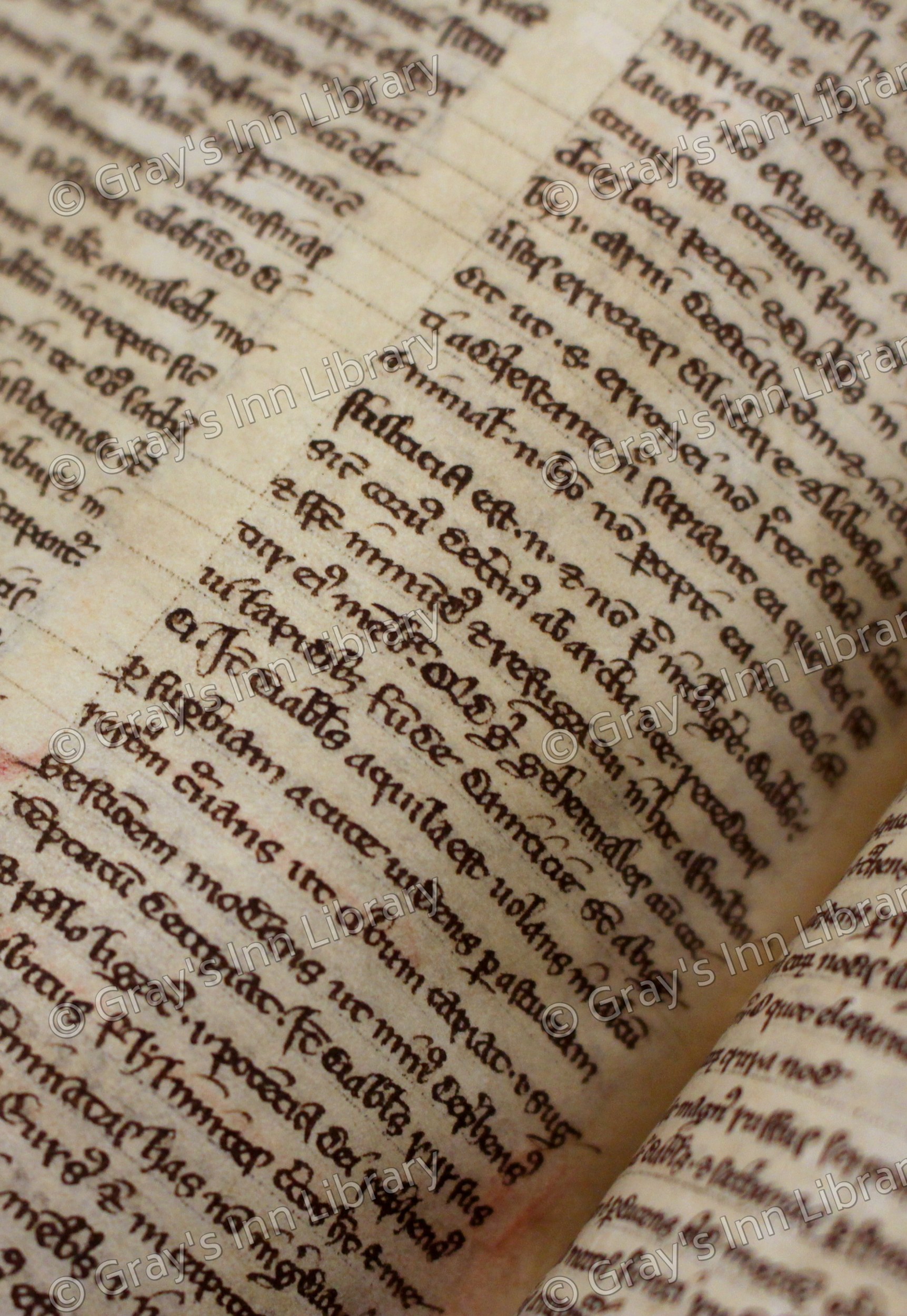 On the fly-leaf, at the beginning, the contents are thus given, in writing of the beginning of the 17th century:
On the fly-leaf, at the beginning, the contents are thus given, in writing of the beginning of the 17th century:
- Grostest de homine errato, corrupto, restaurato
- Gulielmi de Montibus similitudinarium
- Petri Blesensis Breviloquium
Folio 22a ends - Ne sine nobis Christus esse incipiat in futuro. The last ten lines of the column are in a different and apparently later hand, and the sentence id left incomplete. The 23rd folio is blank.
Folio 24a begins - Omnis nostra cognicio intellectualis incipit a sensu: unde philosophus, Deficiente sensu necesse est scientiam deficere.
Folio 29a ends - Quid ergo respondebis sponso cum. The remainder of the column is in a different hand, and of different matter. Folios 30 and 31 are blank.
Folio 32a begins - Omnis nostra cognicio: and the first two columns and the first line and a half of the third column agree with the first two columns and first twelve and a half lines of the treatise which begins at folio 24; but what follows is different.
Ends folio 52b - Unde conqueritur Christus in Psalmis, oculi mei languerunt pro inopia, leaving two thirds of the second column blank.
Folio 53a - 55b begins - Augustinus de fide, ad Petrum, angeli atque homines. Ends - Sed Christus dedit honorem matri. Exo. xx., honora patrem et matrem.
Dr Pegge, in his Life of Grostête, does not mention any treatise with the title De homine errato, &c. These fragments are probably extracts from some work of Grostête.
II. Folio 56 begins - Prologus super Similitundinarium magistri Willelmi de Montibus ad declarandum in sermone quocunque propositum similitudines. Ends at folio 101a - Et Christianus nominatur membrum cum diaboli est et non Christi.This is a collection for the use of preachers. The words out of which the similes are to be wrought are in red ink, and each is followed by the similes.
III. Folio 101b begins - Deus qui dixit lumen de tenebris splendescere; and ends 111a - Ut sic in universo veteris et novi testamenti sun xxiiijᵒʳ libri. Explicit.Dr Giles in his preface to the collected works of Peter of Blois, having seen this manuscript of III, reects it as not being by that author. At the back of the first fly-leaf at the end of the volume is a note in an early hand, Liber ecclesie Beate Marie de Cumba juxta Coventreyam; followed by the curse, which someone has endeavoured to erase; qui a predictâ communitate alienaverit vel furatus fuerit vel folium inde abciderit anathema sit. Amen.
Taken from 'A Catalogue of the Ancient Manuscripts Belonging to the Honourable Society of Gray's Inn' by Alfred Horwood, published 1869. Make a request to view this manuscript.Manuscript 14
Isidore (Bishop of Seville)
Commentaries on some of the book of the Old Testament; and other works.
- In writing of the 12th and 13th Centuries
- 137 leaves of parchment
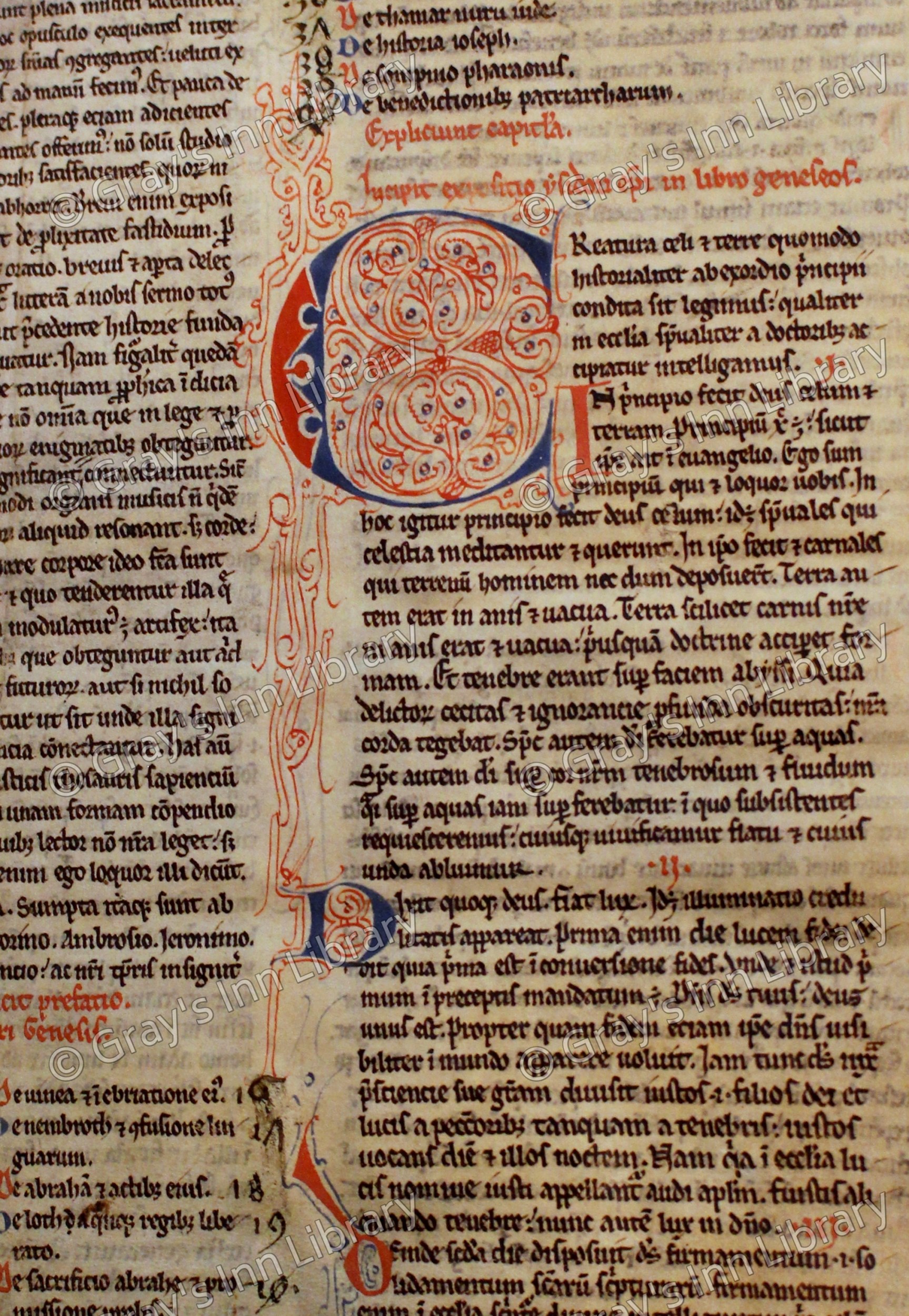
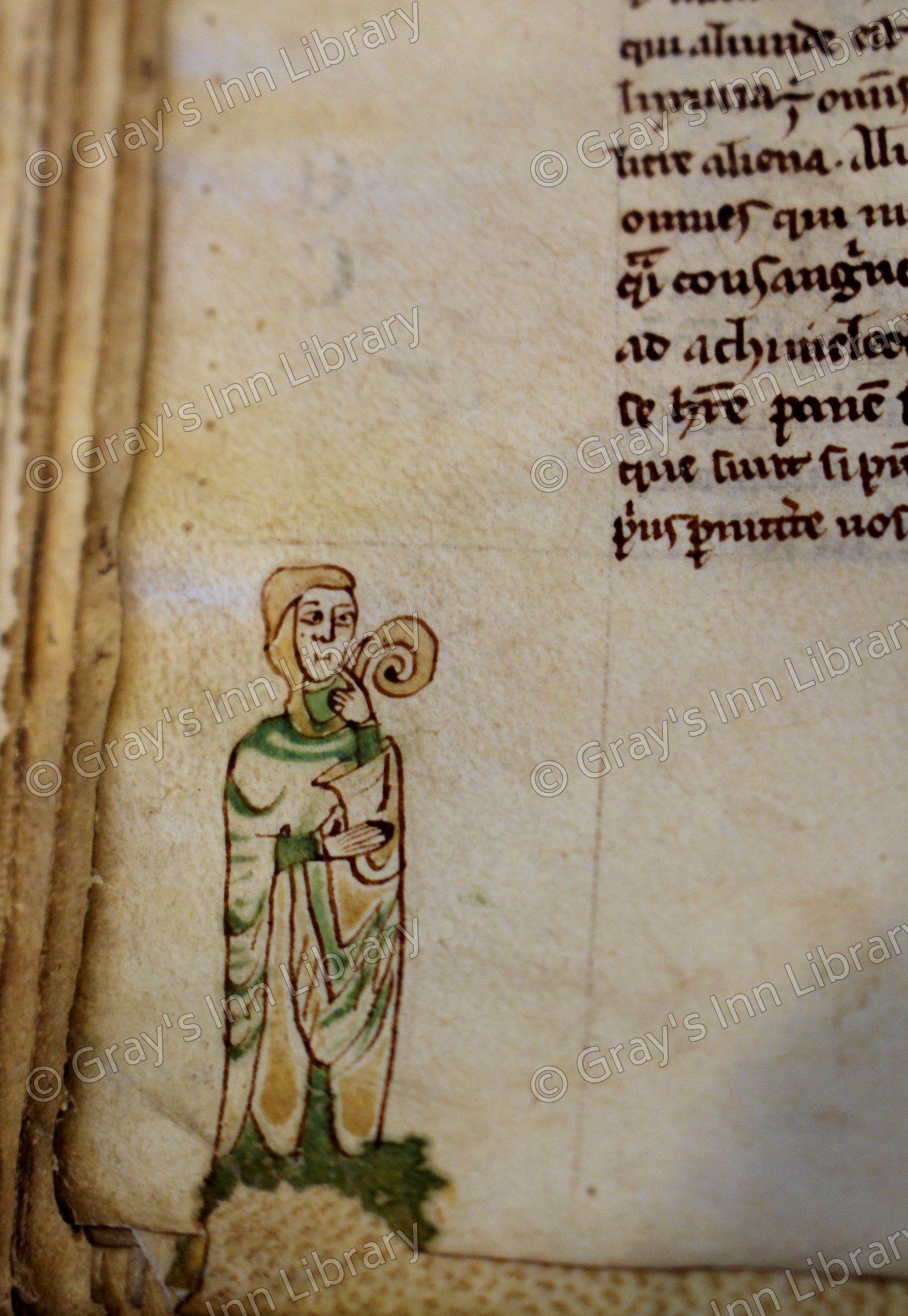
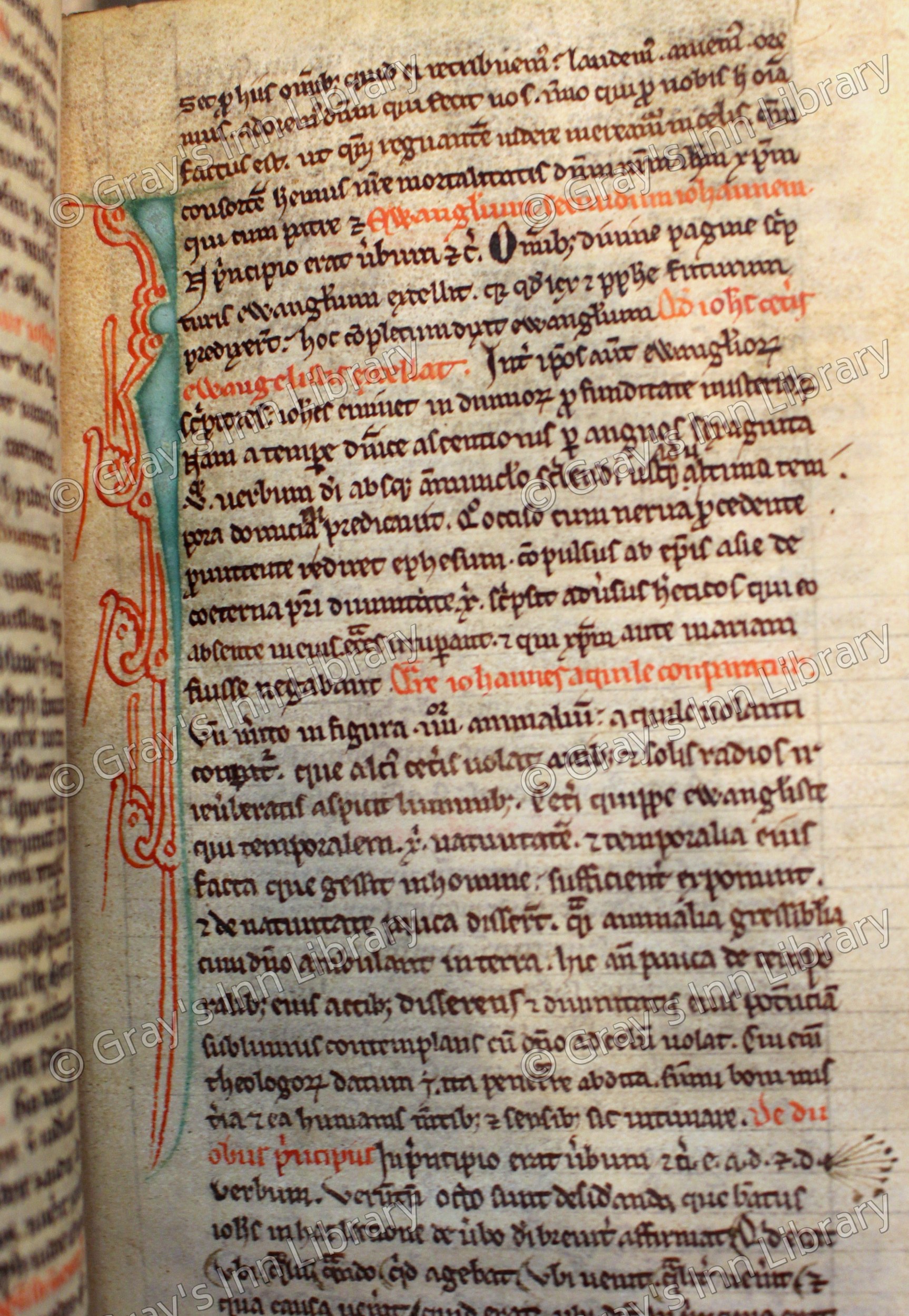 I. Folio 1a. The rubric is Incipt prefatio Ysidori episcopi in libro Genesios.
I. Folio 1a. The rubric is Incipt prefatio Ysidori episcopi in libro Genesios.
The preface begins Historia sacre legis. After the preface and a list of the chapters follow expositions of Genesis, Exodus, Leviticus, the 3rd Book of Kings, and the Proverbs. Ends of 22a - In figura domini salvatoris processisse doceamus.
II. Folio 23a. The rubric is Incipiunt Evangelia communia: primum de apostolis secundum Matheum.These are sermons on the Apostles, Martyrs, Confessors, Virgins, the Trinity, the Holy Spirit, and the Ascension. The first begins, Ecce ego mitto vos, &c. Ante Salvatoris adventum.
III. Folio 28a. A treatise on the Sacrements, headed with the rubric secundum Magistrum R. de Maidinstan archidiaconum Cestrensem super sententias.Begins - Ad hoc quod baptismus fiat ista exiguntur, Verbum, Elementum, que sunt materia baptismi. Ends folio 32a - Propter opera bona que fecit existens malus.
The remainder of column 2 of 32a is filled up with with the prefatory letter of Peter Comestor to his Historia Scolastica.
IV. Folios 32b. The rubric is, Incipit prefatio Epistolaris in historiam scolasticam et veteri et novo.There are 14 books subdivided into chapters.
The text begins, In precedentibus premissa descriptione originis et discrescionis artium.
Ends 60b - Quam largitur incommutabiliter et...bonus deus. A hand of the 15th century has added Explicit Allegoria.
Although the letter of Peter Comestor precedes, yet this work is not the same as the well-known Historia Scolastica of P.C. It seems to be the work of Isidore of Seville.
V. Fol. 61. [Sermones Dominicales per totum. annum.] These are headed by a long letter addressed Viro bone fame viteque celeberrimo domino W. Dei gratia N. ecclesie dispensatori.The first sermon (for the 1st Sunday in Advent) begins Cum appropinquasset Jesus Hierosolimis &c. Non sine magna causa misterii...
The last sermon is for the 22nd Sunday after Trinity, and ends fol. 101b.
VI. Fol. 102a. A treatise on God.Begins - Omnipotens dens pater et filius et spiritus sanctus unus atque trims est.
Ends fol. 103, column 1 - Cujus mors recte dulcis sompnus dicitur.
The remainder of the leaf is occupied with definitions and explanations of words.
VII. Fol. 104. Sanctus Bernardus de singularitate [sea de terrarum distributionibus].Begins - Item sanctus Bernardus sedens in capitulo pontiniacensi.
VIII. Fol. 105a. Chronological tables of the six ages of the world. IX. Fol. 106a. Sermo ad claustrales.Begins - Quia relicta sepias cenobitarum.
Ends 107b - Verbis pugnant cum pugnantibus.
X. Fol. 108a. An account of the wars in the Holy Land, A. D. 1217-1219.Begins - Letatur mons Syon.
Printed by Dr. Giles. 8vo. London, D. Nutt, 1846.
(Fol. 119b-123a, column 1 are occupied with ancient biblical history. Three recipes in French are on the 2nd column of 123a. Fol. 123b contains directions for reading certain portions of Scripture at certain seasons of the year.)
This tract is the first part of one printed by Eccard* in his Corpus Historicum Medii Ævi, volume 2, column 1397. It is assigned by him to Oliver of Cologne. The tract here ends at column 1421 of Eccard (p. 40 of Dr. Giles's edition). But the treatise extends to column 1454 of Eccard.
That portion which ends at p. 40 of Dr. Giles's edition had not only been previously printed by Eccard in 1723, but had in 1687 been printed in Gale & Fell's collection, volume 2, p. 435, from a manuscript in the public library at Cambridge.
And that portion of the manuscript which commences In nomine patris (p. 48 of Dr. Giles's edition), and ends with the word pugnatorum (p. 54 of that edition), was also printed by Eccard, coll. 1451-1454, but with variations from a different manuscript.
* For the reference to Eccard I am indebted to Professor Brewer of King's College.
XI. Fol. 124-131b. Peter of Blois on Job and on the Transfiguration. Printed in the 3rd vol. of the works of P. B., edited by Dr. Giles. XII. Fol. 132a-135b. A sermon or treatise on the text (which heads it), Gustate et videte quam suavis est domiaus &c.; and on the text, Haurietis aquas in gaudio. XIII. Fol. 136a begins - Venerabilis Beda noster dicit sic in cronicis suis.This occupies one column and a half out of the three columns on the page, and is a brief epitome of chronology, Jewish and Roman.
XIV. Fol. 136a, column 2 - Incipit vita Sancti Thorne martiris.Ends on 137b. It is a rhythmical poem on Thomas Becket, of between 600 and 700 lines. Printed by Dr. Giles. The author was Guernes de Pont St. Maxence.
XV. A printed book - Cantica Canticorum Salomonis cum expositione D. Jacobi Perez de Valentia, &c. &c. Folio, 1509. In ædibus ascenscianis. Title, table, and dedication in six leaves, and the text on 76 numbered leaves.On the verso of the fly-leaf at the beginning of the volume are three lists of the contents in old writing of different periods. The rubric at fol. 28a, secundum Magistrum R. de Maidinstan, &c., would seem more naturally to apply to the treatise which precedes it. But the tract III. is so much more in the usual form of exercises on the Sentences that the rubric may perhaps safely be said to belong to it.
Taken from 'A Catalogue of the Ancient Manuscripts Belonging to the Honourable Society of Gray's Inn' by Alfred Horwood, published 1869. Make a request to view this manuscript.Manuscript 15
Staunthone De Decem Preceptis
- 15th Century
- 72 leaves of parchment
- Initial letter of each commandment is ornamented with gold and colours
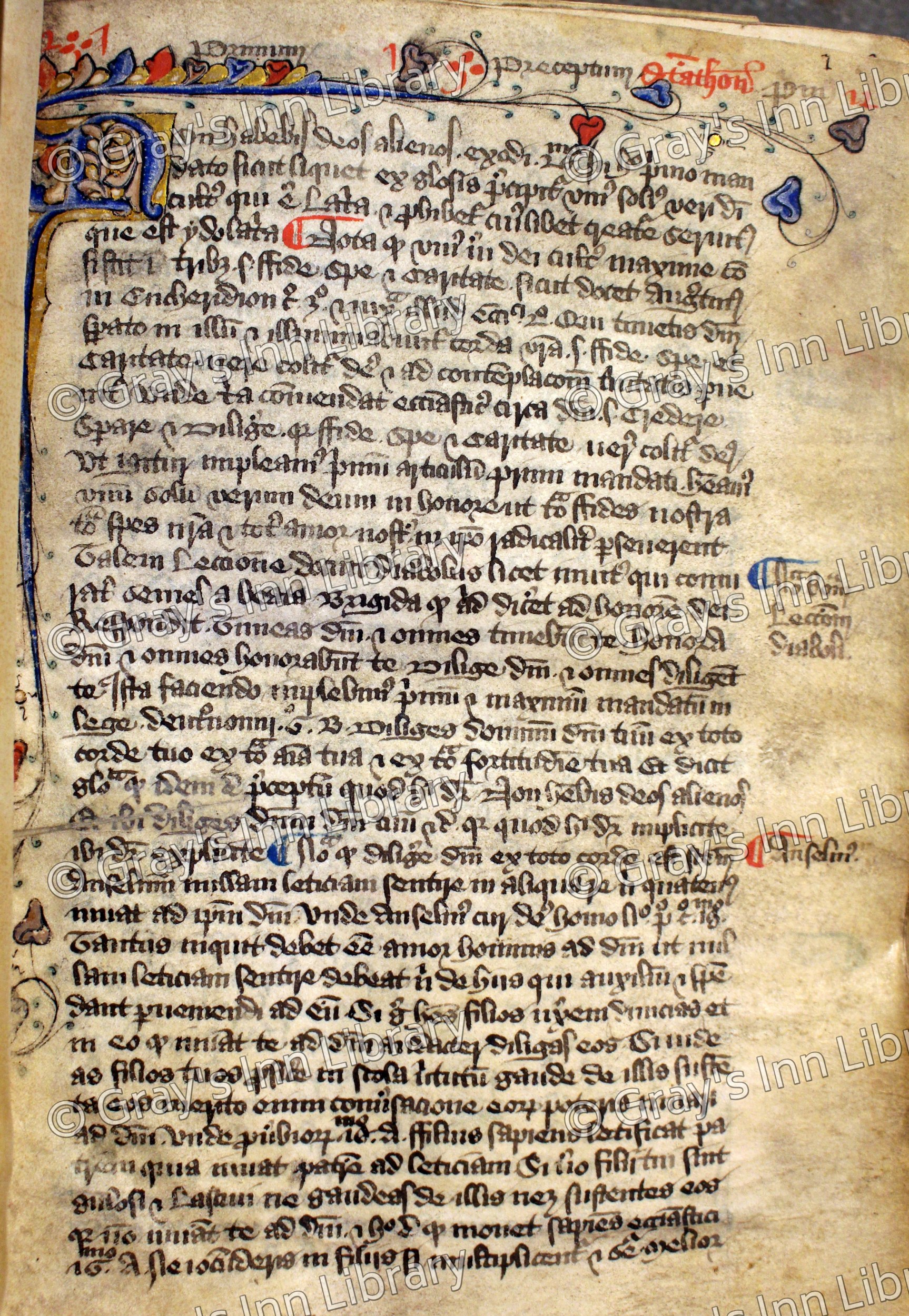
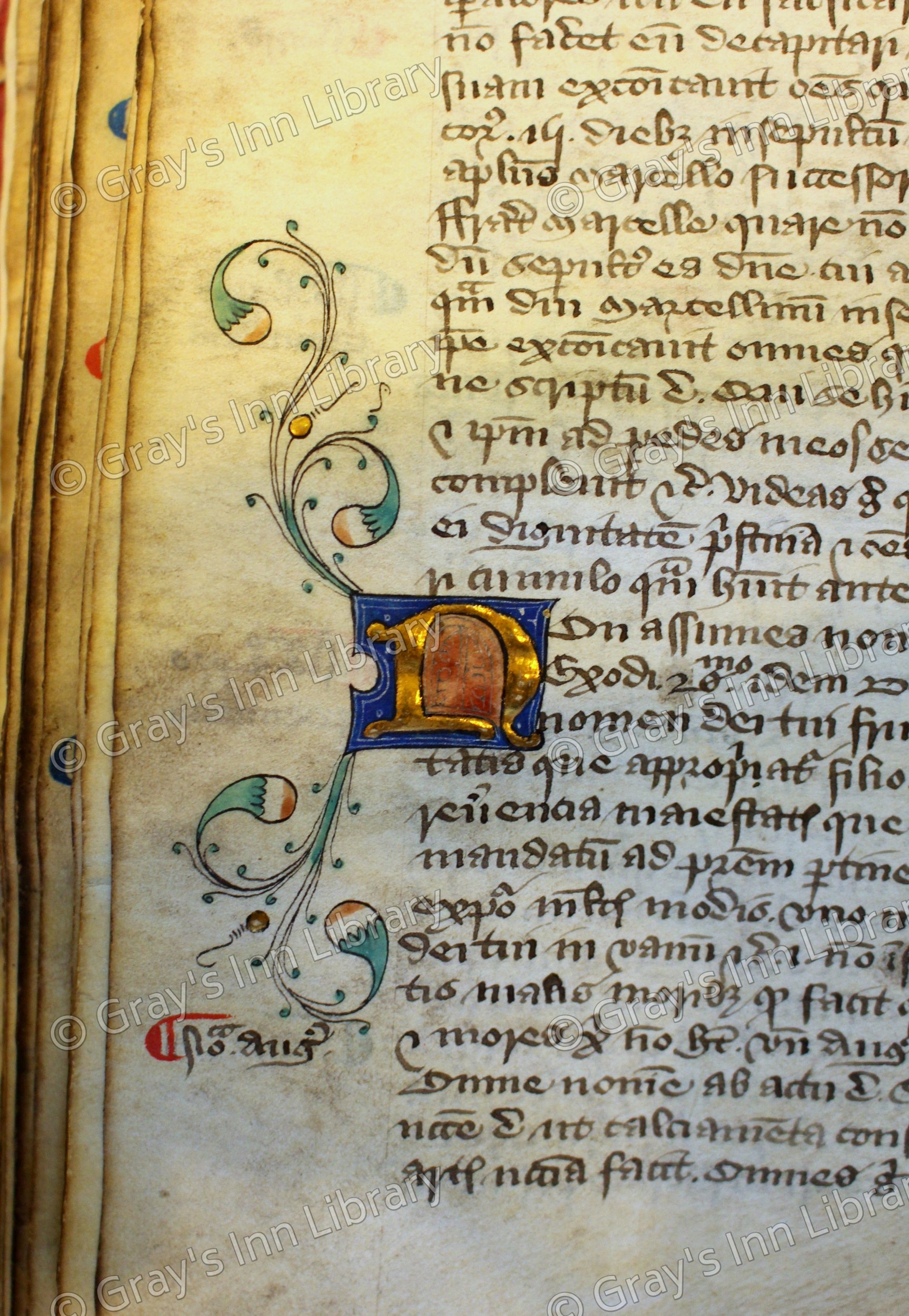
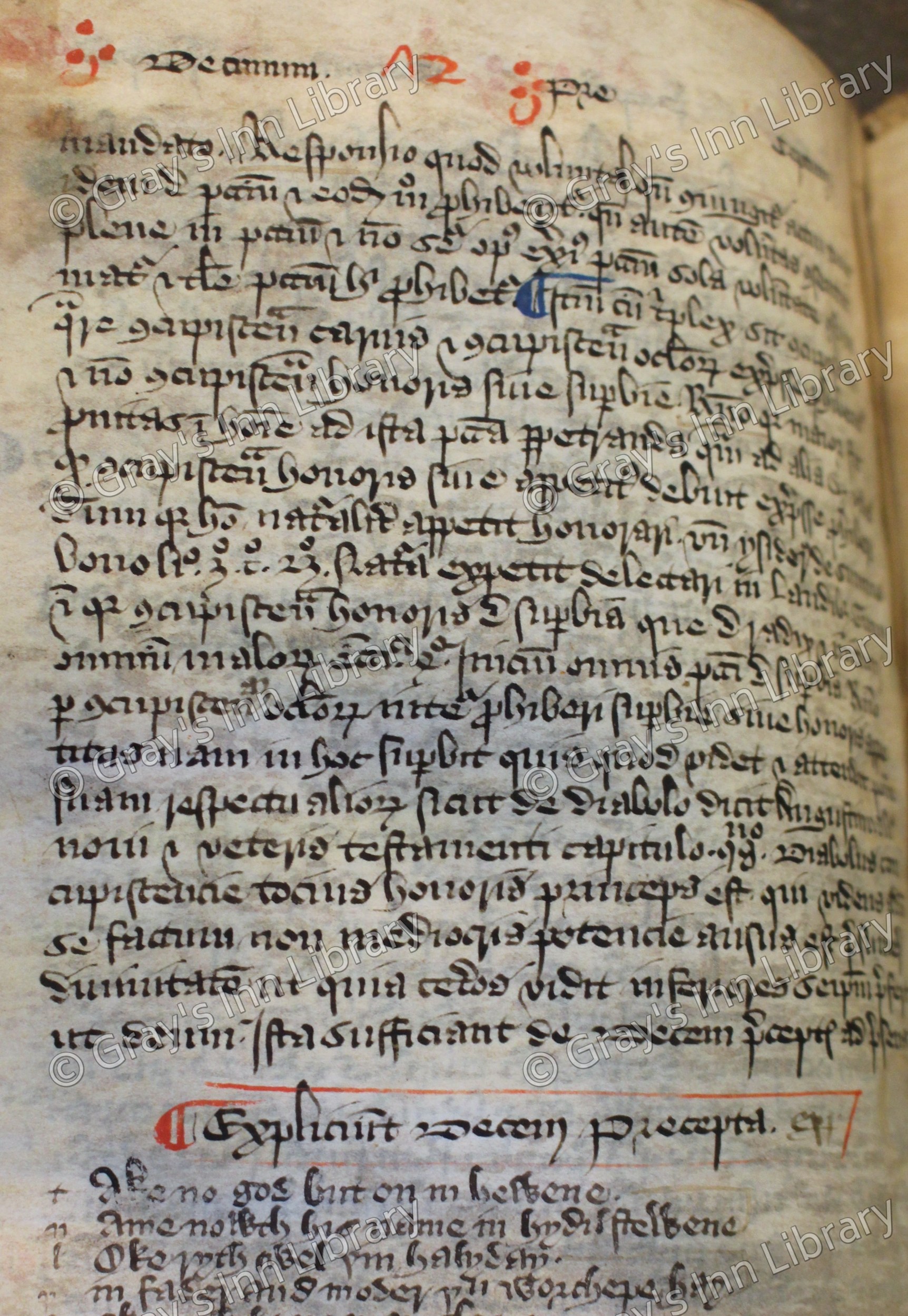 Begins - Non habebis deos alienos, exodi 20 ᵐ. In hoc primo mandato sicut liquet ex glosis.
Ends 72b - Ista sufficiunt de decem preceptis ad presens. Expliciunt decem precepta. The remainder of the page is occupied by the Ten Commandments in twelve lines of old English verse, and in four Latin hexameters.
The comments on the Commandments are interspersed with Narraciones, some of which were stories known to the author personally. At folio 5b he mentions a certain religiosus Gilbertus de Massingham: folio 10b - Ut predicavit frater Walterus de Raveningham: folio 31 - Frater Ricardus de Fraunsham and Radulfus de Swyneland; 36b - Presbiter in villa de Hale.
Taken from 'A Catalogue of the Ancient Manuscripts Belonging to the Honourable Society of Gray's Inn' by Alfred Horwood, published 1869.
Make a request to view this manuscript.
Begins - Non habebis deos alienos, exodi 20 ᵐ. In hoc primo mandato sicut liquet ex glosis.
Ends 72b - Ista sufficiunt de decem preceptis ad presens. Expliciunt decem precepta. The remainder of the page is occupied by the Ten Commandments in twelve lines of old English verse, and in four Latin hexameters.
The comments on the Commandments are interspersed with Narraciones, some of which were stories known to the author personally. At folio 5b he mentions a certain religiosus Gilbertus de Massingham: folio 10b - Ut predicavit frater Walterus de Raveningham: folio 31 - Frater Ricardus de Fraunsham and Radulfus de Swyneland; 36b - Presbiter in villa de Hale.
Taken from 'A Catalogue of the Ancient Manuscripts Belonging to the Honourable Society of Gray's Inn' by Alfred Horwood, published 1869.
Make a request to view this manuscript.
Manuscript 16
Monaldi Justinopolitani Summa Juris Canonici
- 14th Century
- 339 leaves of vellum
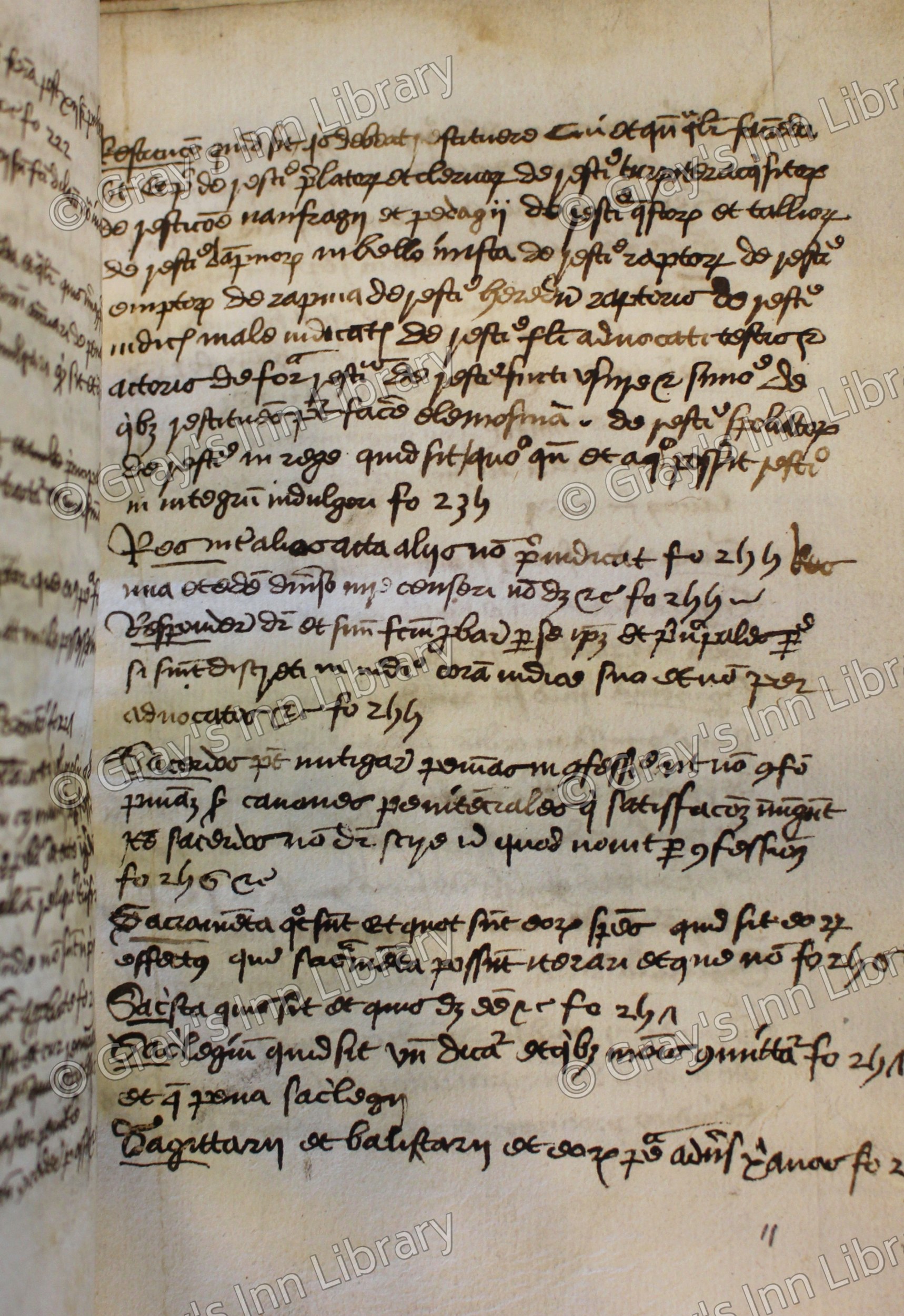
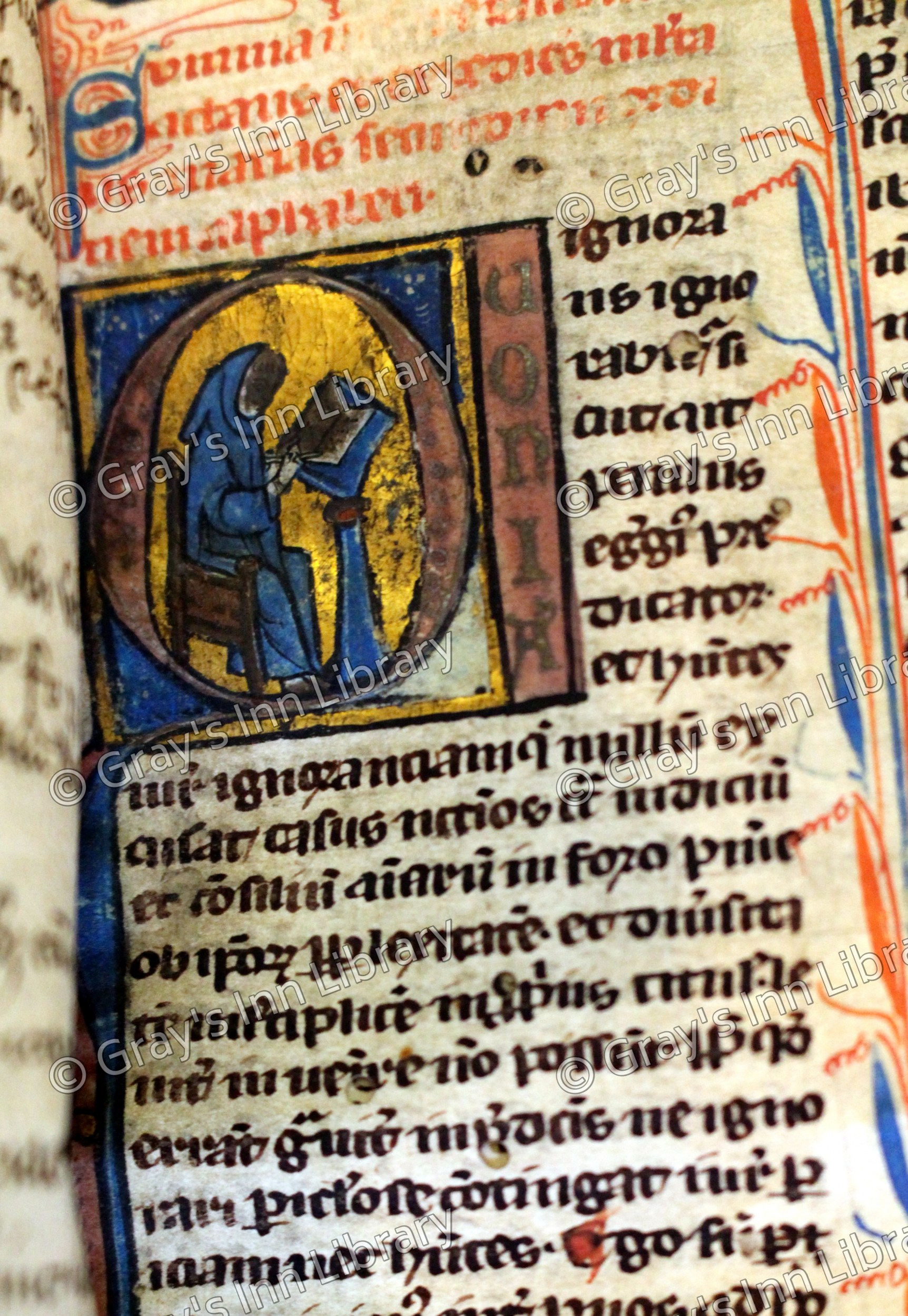
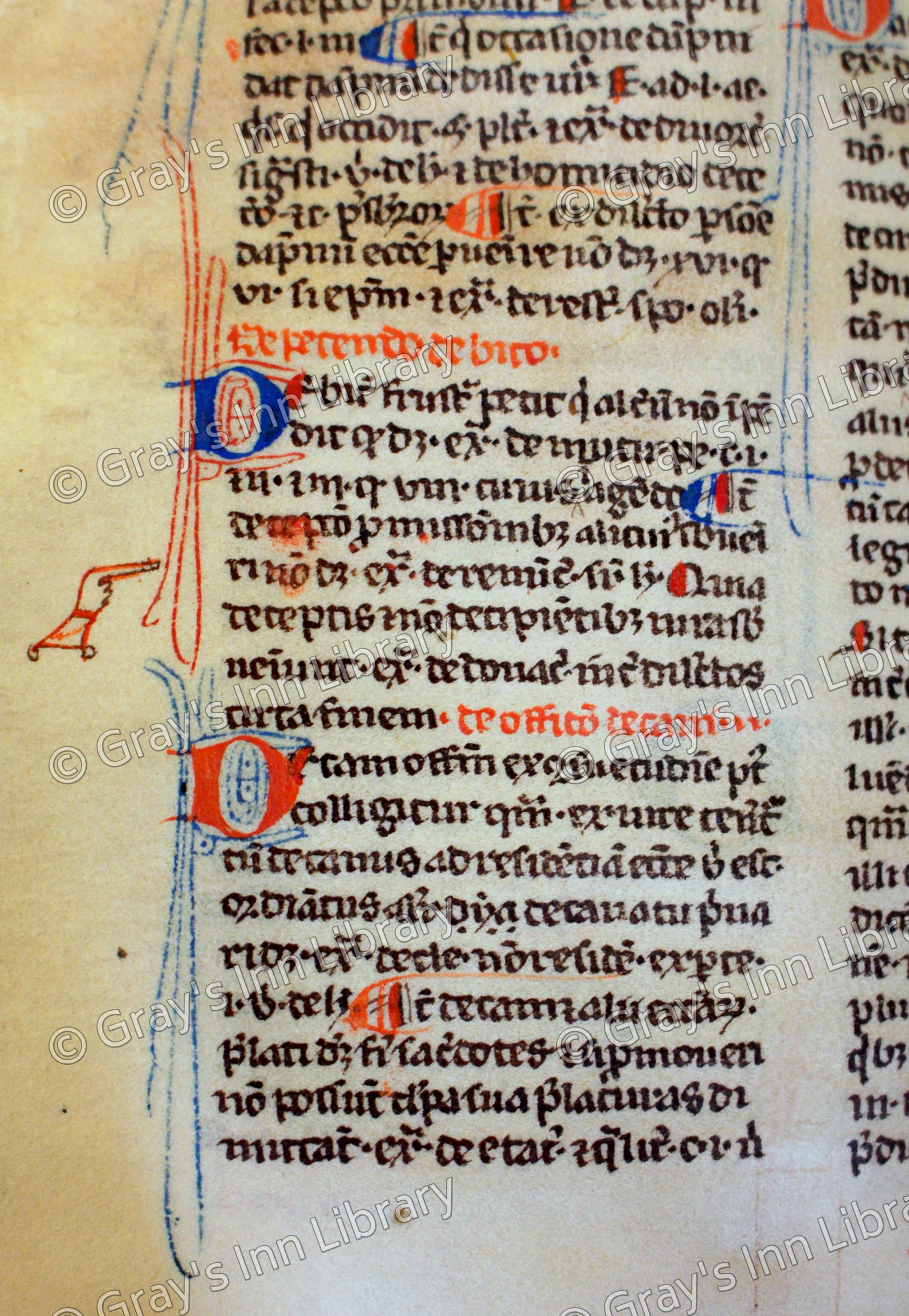 Begins folio 1a - Rubric, Summa... canonicorum tractans et expediens multas materias secundum ordinem alphabeticum.
Prologue begins - Quia ignorans ignorabitur.
The first subject is Quis possit esse Abbas?
Ends fol. 319b - In celesti gloria perhenniter fulgeamus. Amen. Hic opus expletur gloria vero detur. - Explicit Summa Monaldi de ordine patrum minorum.
The last subject is Duo sunt genera Christianorum. At the beginning of the volume is an alphabetical table in eleven leaves of paper, by a later hand.
The author was a Minorite, a Dalmatian by birth, and died about A. D. 1332. This work, according to Oudin, was printed at Lyons in 1526; according to Fabricius in 1516.
Taken from 'A Catalogue of the Ancient Manuscripts Belonging to the Honourable Society of Gray's Inn' by Alfred Horwood, published 1869.
Make a request to view this manuscript.
Begins folio 1a - Rubric, Summa... canonicorum tractans et expediens multas materias secundum ordinem alphabeticum.
Prologue begins - Quia ignorans ignorabitur.
The first subject is Quis possit esse Abbas?
Ends fol. 319b - In celesti gloria perhenniter fulgeamus. Amen. Hic opus expletur gloria vero detur. - Explicit Summa Monaldi de ordine patrum minorum.
The last subject is Duo sunt genera Christianorum. At the beginning of the volume is an alphabetical table in eleven leaves of paper, by a later hand.
The author was a Minorite, a Dalmatian by birth, and died about A. D. 1332. This work, according to Oudin, was printed at Lyons in 1526; according to Fabricius in 1516.
Taken from 'A Catalogue of the Ancient Manuscripts Belonging to the Honourable Society of Gray's Inn' by Alfred Horwood, published 1869.
Make a request to view this manuscript.
Manuscript 17
De Sacre Scripture Profundis Misteriis, authore Rogero Bacone
- 15th Century
- 150 leaves of paper
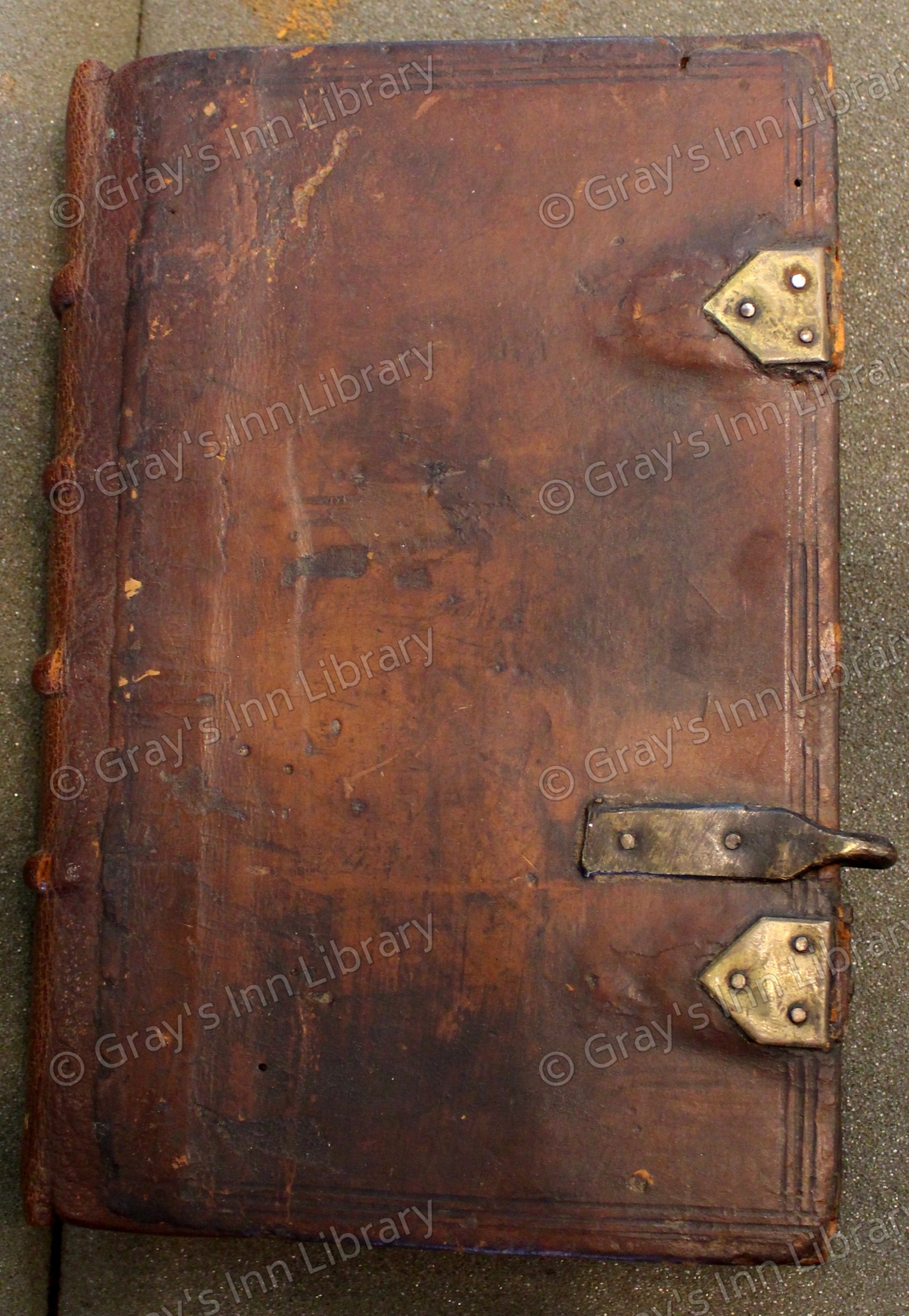
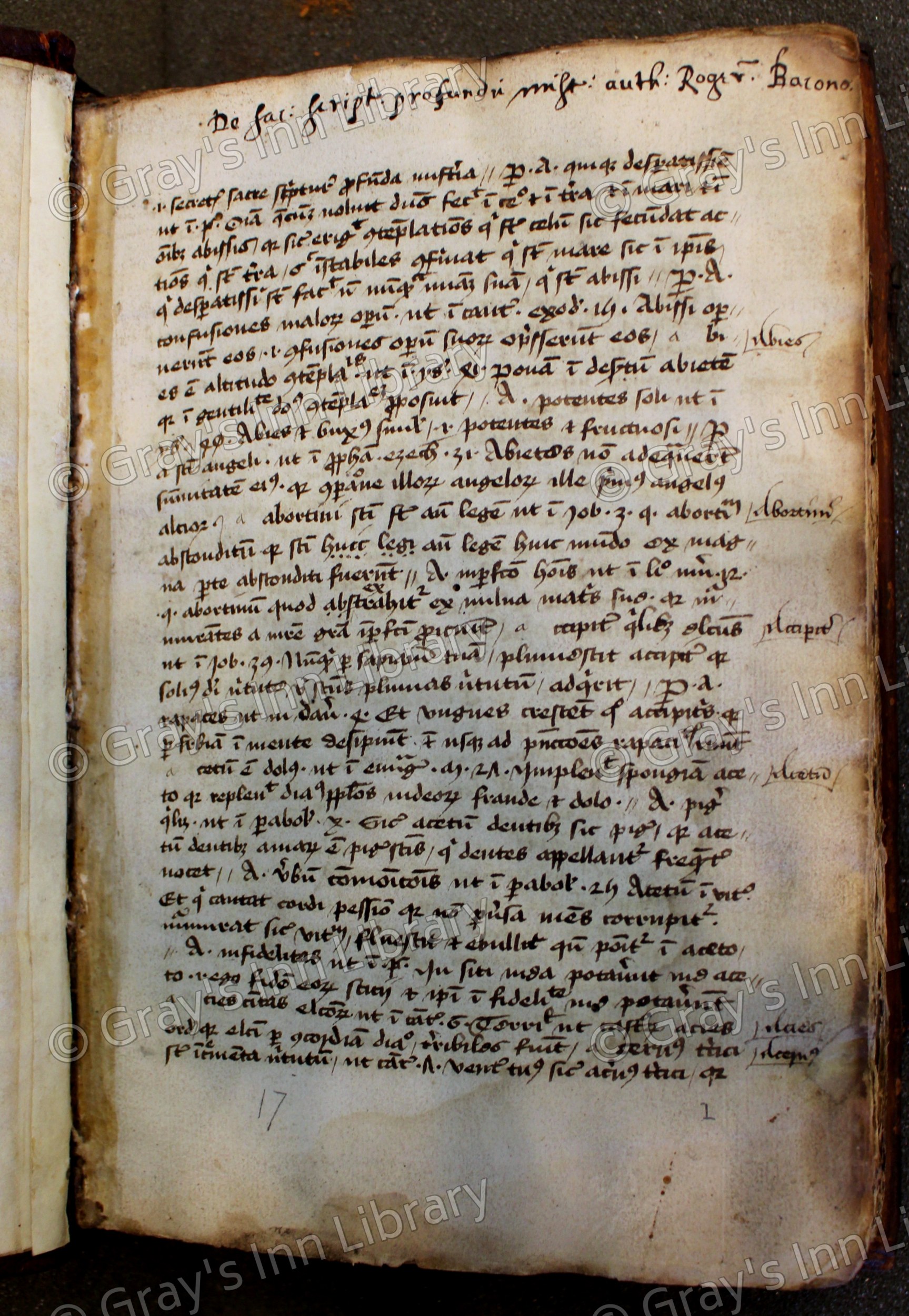
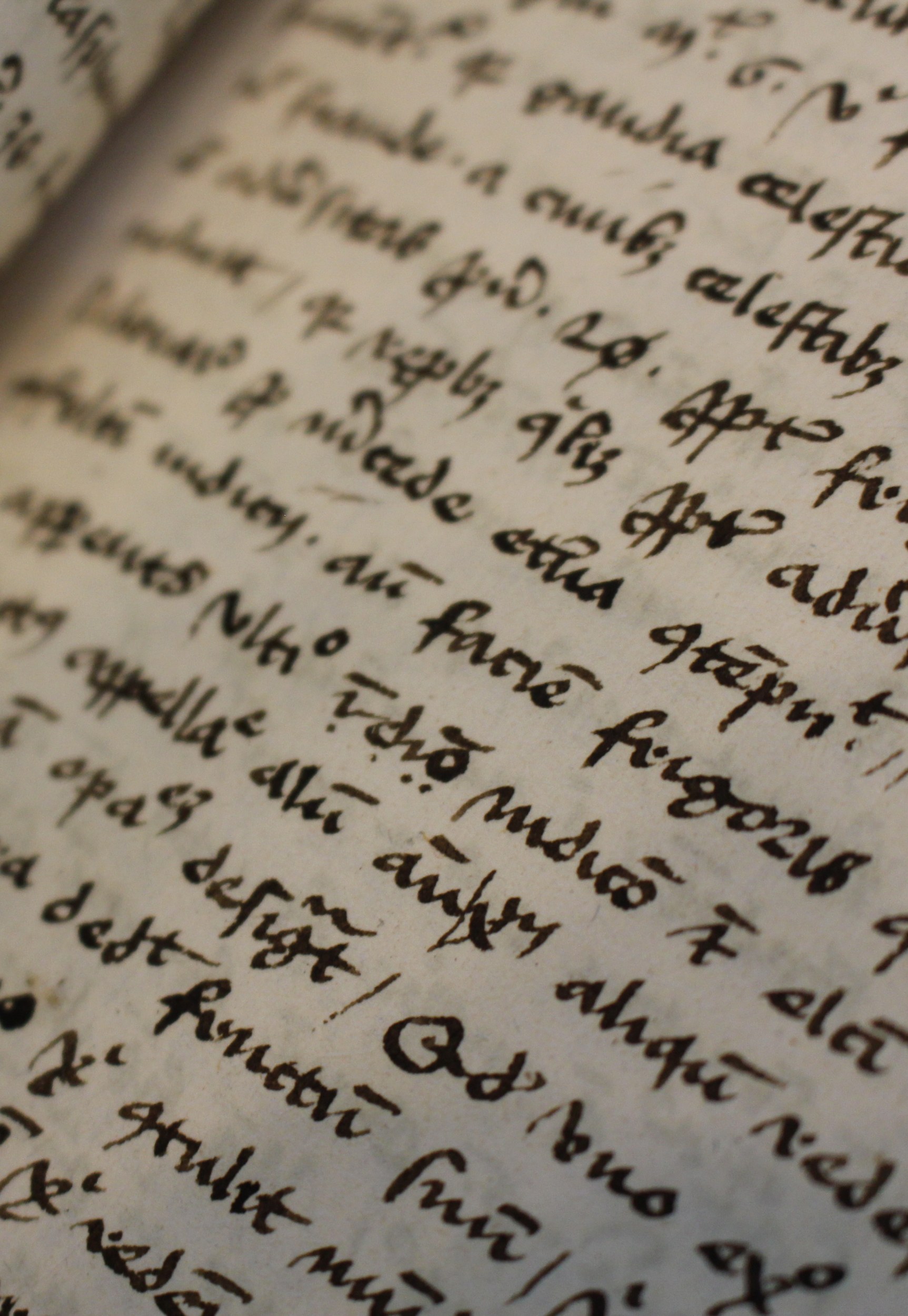 This work is an alphabetical arrangement of certain words occurring in the Scriptures, with their symbolical meanings.
The first two leaves of the first quire are wanting, therefore the text begins imperfectly, id est secretorum sacre scripture profunda misteria. (It appears from what follows that the word commented upon is Abissus.)
Ends folio 150b - Carnis mortificatione in membris reproborum (the subject being Zona). Explicit Tiber. And, in another hand, iij. s. iiij. d. precium taxatum, quod A.
There is nothing but the title to show the work to be by Roger Bacon.
Taken from 'A Catalogue of the Ancient Manuscripts Belonging to the Honourable Society of Gray's Inn' by Alfred Horwood, published 1869.
Make a request to view this manuscript.
This work is an alphabetical arrangement of certain words occurring in the Scriptures, with their symbolical meanings.
The first two leaves of the first quire are wanting, therefore the text begins imperfectly, id est secretorum sacre scripture profunda misteria. (It appears from what follows that the word commented upon is Abissus.)
Ends folio 150b - Carnis mortificatione in membris reproborum (the subject being Zona). Explicit Tiber. And, in another hand, iij. s. iiij. d. precium taxatum, quod A.
There is nothing but the title to show the work to be by Roger Bacon.
Taken from 'A Catalogue of the Ancient Manuscripts Belonging to the Honourable Society of Gray's Inn' by Alfred Horwood, published 1869.
Make a request to view this manuscript.
Manuscript 18
Sermones Dominicales Per Totem Annum; and two other works described below
- 15th Century
- 229 leaves of parchment
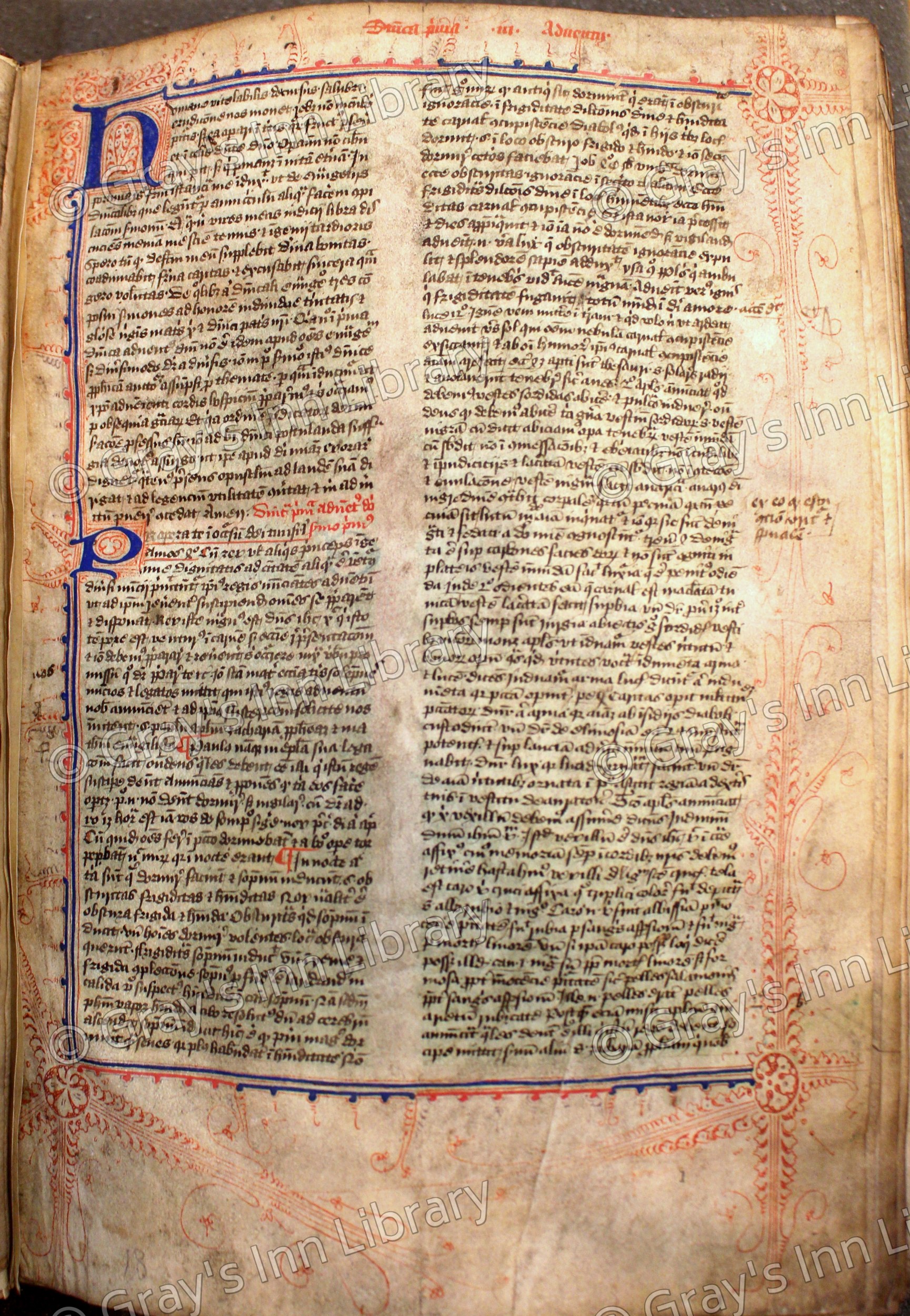
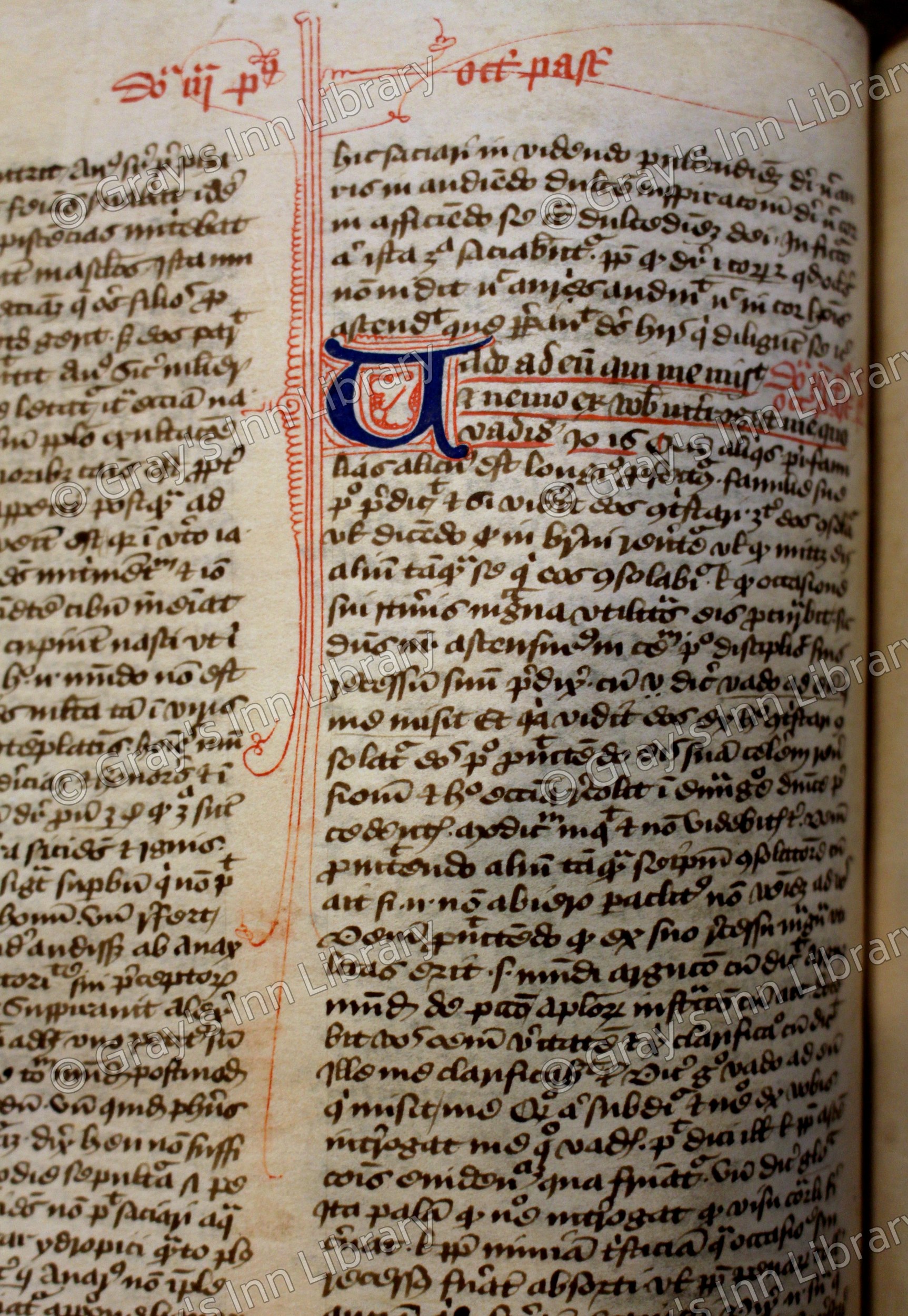
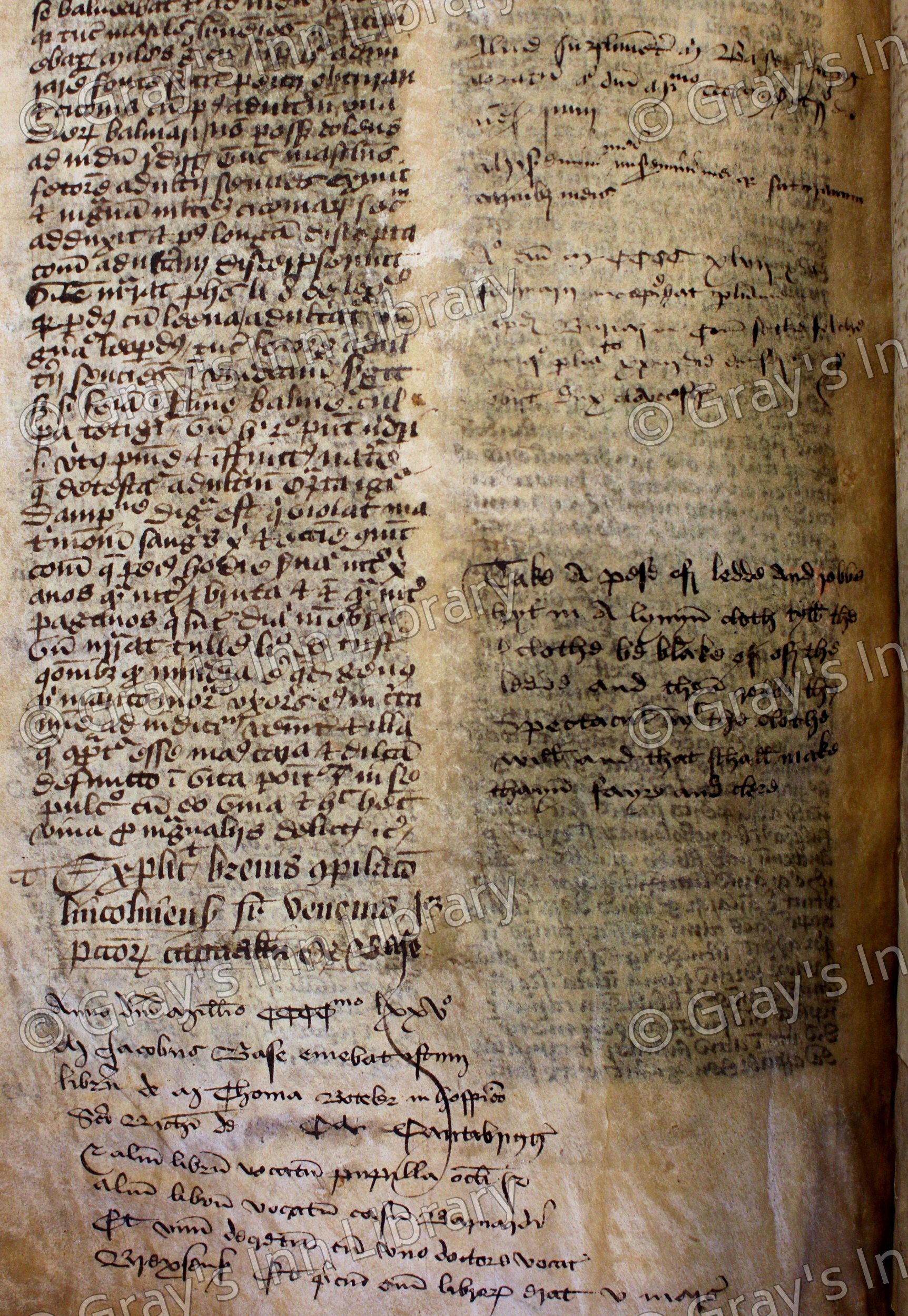 On the vellum fly-leaf before folio 1 is this note, in writing of the 15th century: In hoc volumine, Sermones Januensis, Compendium theologice veritatis, Lincolniensis de venenis. A later hand has added, after the word Januensis, the words et Bradwardini.*
*Thomas Bradwardine, Archbishop of Canterbury, A.D. 1349. Fabricius states that he wrote Sermones Dominicales.
I. Sermones Dominicales.
On the vellum fly-leaf before folio 1 is this note, in writing of the 15th century: In hoc volumine, Sermones Januensis, Compendium theologice veritatis, Lincolniensis de venenis. A later hand has added, after the word Januensis, the words et Bradwardini.*
*Thomas Bradwardine, Archbishop of Canterbury, A.D. 1349. Fabricius states that he wrote Sermones Dominicales.
I. Sermones Dominicales.
The preface begins, Humane vite labilis discursus. In this the author says, that being of the order of Friars Preachers, he entreats the favour of St. Domenic. The first sermon (for the First Sunday in Advent), Propera te in occasu dei tui Israel (Amos iv.). The last sermon ends on 146b - et regnat per infanta seculorum secula. Amen. Quod T. Boteler. Expliciunt sermones dominicales secundum Januensem (i.e. Jacobus de Voragine, bishop of Genoa, author of the Golden Legend). A copious index follows, ending on folio 151b. These sermons have been printed.
II. Folio 152a-219a - Veritas Theologie, divided into seven books.This is the treatise usually called Compendium thologicæ veritatis, and attributed to Albertus Magnus, and printed in the 13th volume of the folio edition of his works; but Fabricius (Bibl. Lat. Med. et Inf. Ætatis) says that it would be more correctly assigned to Hugh of Strasbourg. The Strasbourg edition of 1489 does not mention the name of the author, and Thomas Dorniberg, named in the colophon to that edition, was, according to Fabricius, only the compiler of the index.
III. Folio 220a - Super venenis septem peccatoram capitalium (by Robert Grosteste, bishop of Lincoln from A.D. 1234 to A.D. 1253). See manuscript 23.Begins - Racio veneni potissime convenit peccato.
Ends folio 229b column 1 - Et habuit hec vina pro magnaliis derelictis. Explicit brevis compilatio lincolniensis super venenis septem peccatorum capitalium. Quod Base.
Below is this note Anno domini millesimo ccccᵐᵒ.lxxvᵒ. M. Jacobus Base emebat istum librum de M. Thoma Boteler in hospitio Sancti Nicolai de Civ. Cantabrigge, et alium librum vocatum Pupilla Oculi, et alium libram vocatum Casus Barnardi Ei unum Decretum, cum uno doctore vocato Brexiensis. Et precium omnium librorum et V. marcæ. (The words Civ. Cantabrigge seem to be written on an erasure.) - The book Pupilla Oculi was doubtless the well-known work of that name by John de Burgh, Chancellor of Cambridge in the 14th century, printed in 4to at Strasbourg, 1517 (1516 in title). The Casus Barnardi were doubtless the Casus super Decretales of Bernard of Parma, printed in folio at Bologna, 1487. The Decretum is, of course, the compilation with that name to be found in the Corpus Juris Canonici: and Brexiensis must mean the additions to the glosses on the Decretum by Bartholomew of Brescia, who lived in the 13th century.
The volume is evidently written by one hand, viz., that of Thomas Boteler.
On the last leaf is a Latin note of the meeting of Parliament at Bury St. Edmund's in February 1447, and of the death of the Duke of Gloucester in that month, and a direction in English for cleaning spectacles. Taken from 'A Catalogue of the Ancient Manuscripts Belonging to the Honourable Society of Gray's Inn' by Alfred Horwood, published 1869. Make a request to view this manuscript.Manuscript 19
- 11th Century (by an English Scribe)
- 103 leaves of parchment
- Contains portions of two works
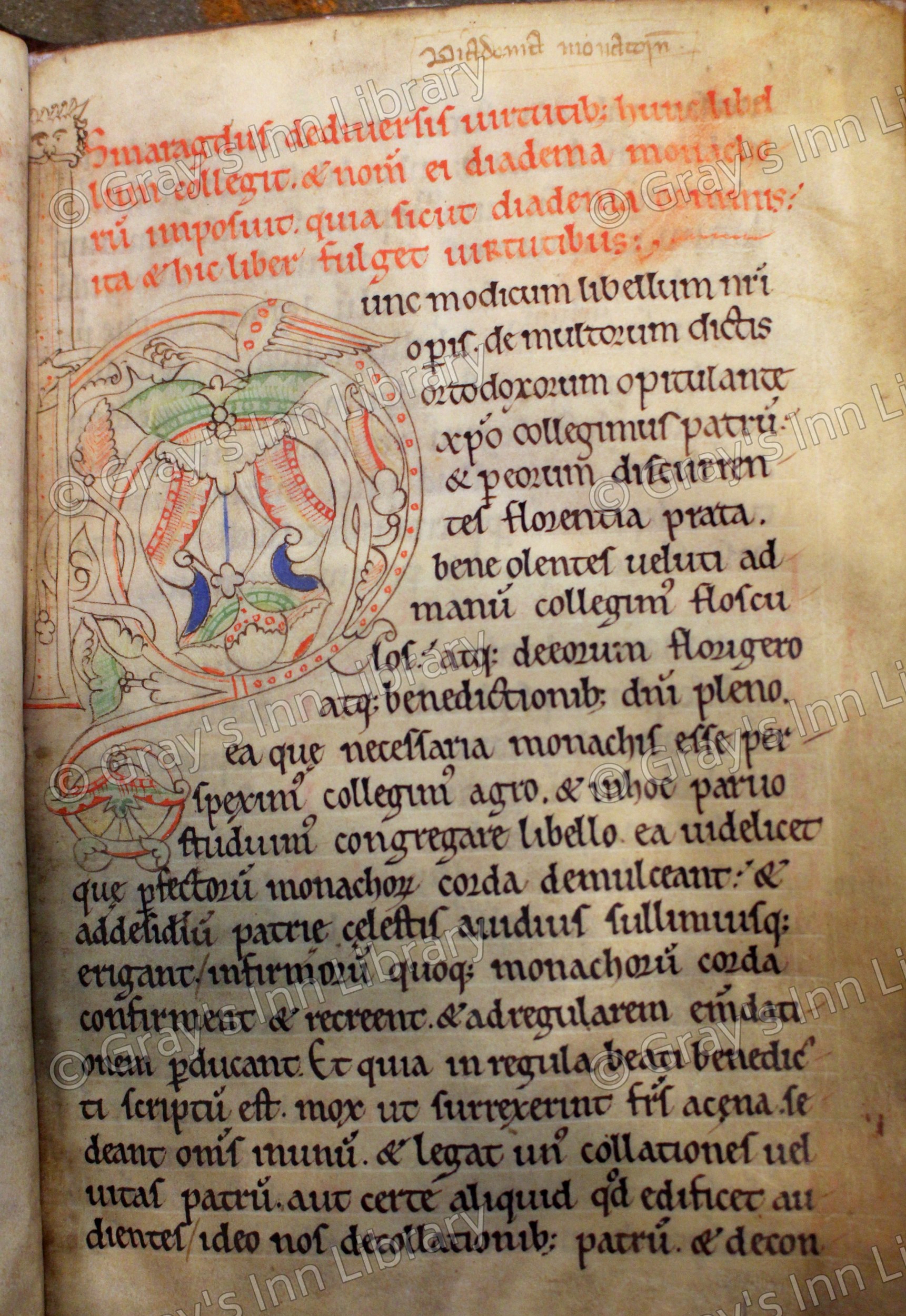
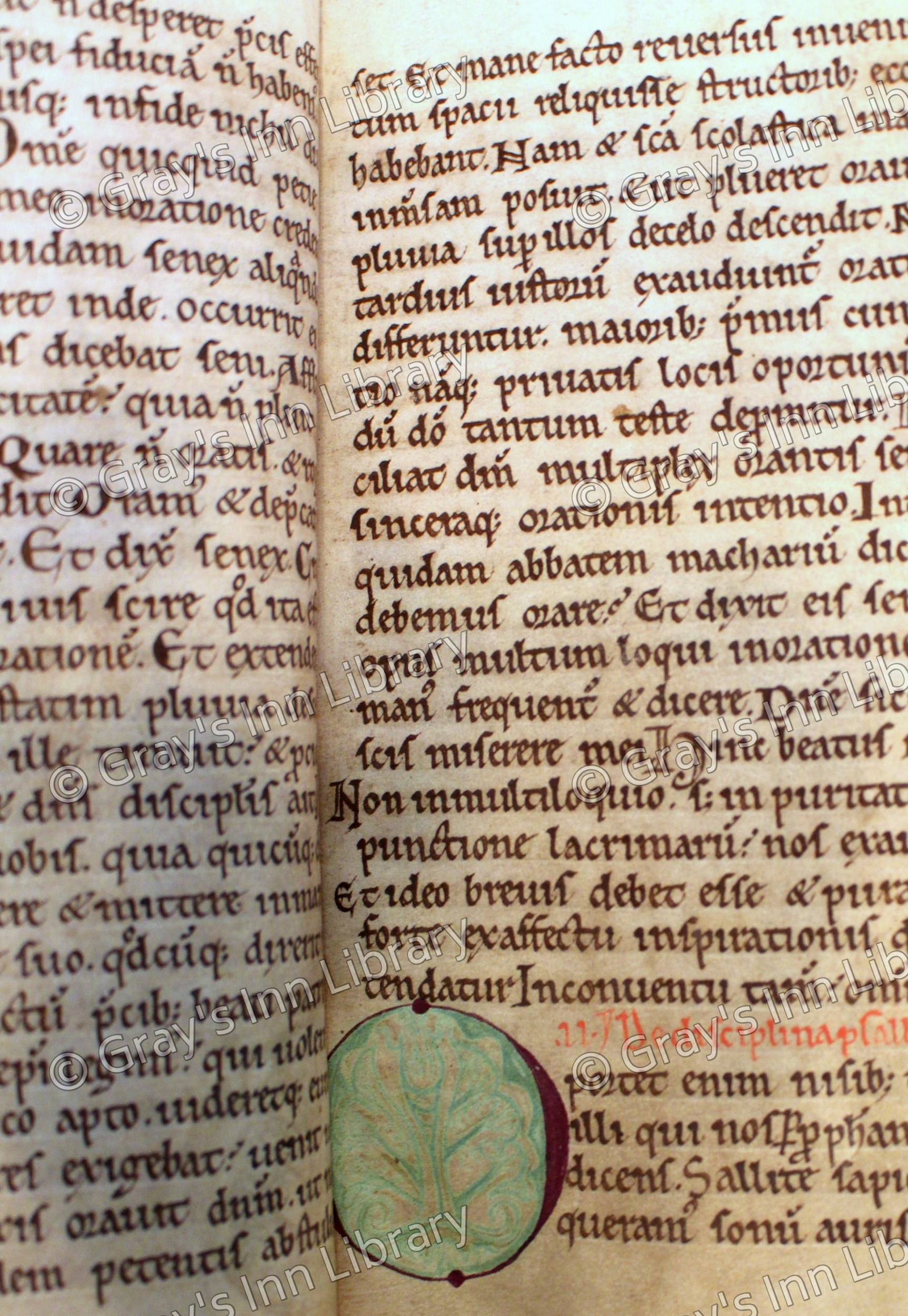
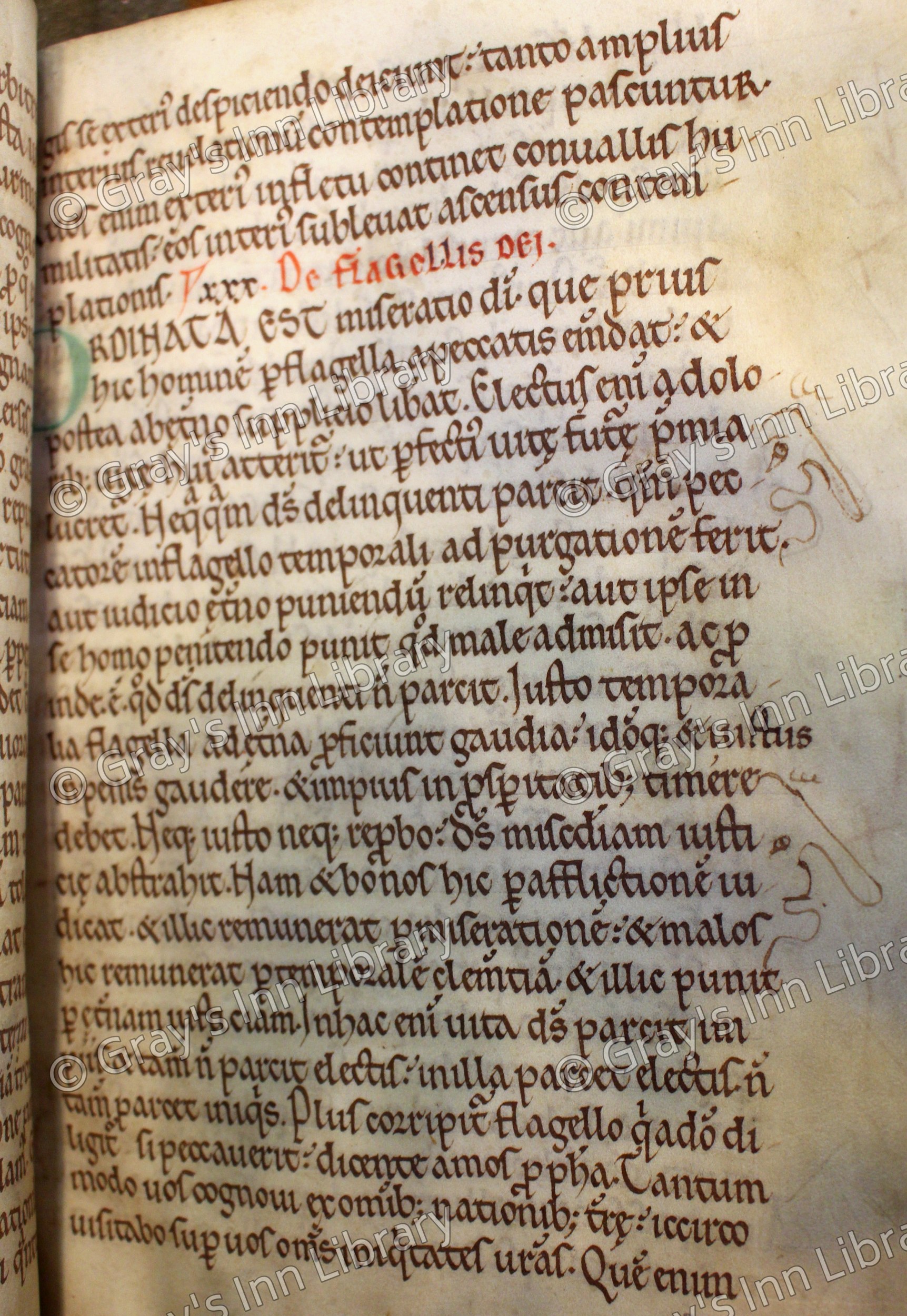 I. Diadema Monachorum by Smaragdus, abbot of St. Michael on the Meuse, in the diocese of Verdun, who lived in the 9th century, according to Cave. This work has been several times printed.
I. Diadema Monachorum by Smaragdus, abbot of St. Michael on the Meuse, in the diocese of Verdun, who lived in the 9th century, according to Cave. This work has been several times printed.
Begins with a rubric, Smaragdus de diversis... then the introduction Hunc modicum libellum...which is followed by a table of the 100 chapters of the work. The text of the first chapter begins, Hoc est remedium.
One folio, which should be between those numbered 22 and 23, is wanting.
About 8 folios, which should be between those numbered 80 and 81, are wanting; folio 80 ends nearly at the close of the 73rd chapter, and folio 81 begins with the latter part of the 80th chapter.
One folio, which should be between those numbered 87 and 88, is wanting.
Folio 88b ends with the end of the 92nd chapter. The remainder of the work is wanting.
II. The folios 89 to 103, both included, form part of the translation into Latin of the Life of John (the Almoner), Archbishop of Alexandria in the 7th century, written by his contemporary, Leontius, bishop of Neapolis in Cyprus, whose Greek text (says Gibbon), either lost or hidden, is reflected in the Latin version of Baronius (A.D. 610, No. 9; A.D. 620, No. 8).Begins folio 89a - Cum hoc audissem, statim adoravi eam.
Ends on folio 103b with these words - Erat itaque ei qui hunc habebat hostiarius mutus et surdus a nativitate qui per nutum tantum aperiebat et claudebat. festinans...
This Latin translation was made by Anastasius Bibliothecarius in the 9th century. The Greek original, although not known to Gibbon, does not seem lost.
The translation at length is found in the "Vitæ Patrum," usually assigned to Jerome; and in Rosweyd's collection, Vitæ Patrum, folio, 1615.
Taken from 'A Catalogue of the Ancient Manuscripts Belonging to the Honourable Society of Gray's Inn' by Alfred Horwood, published 1869. Make a request to view this manuscript.Manuscript 20
Omelie Totius Anni. Homilies for all the Sundays in the Year
- 13th Century
- 228 leaves of vellum
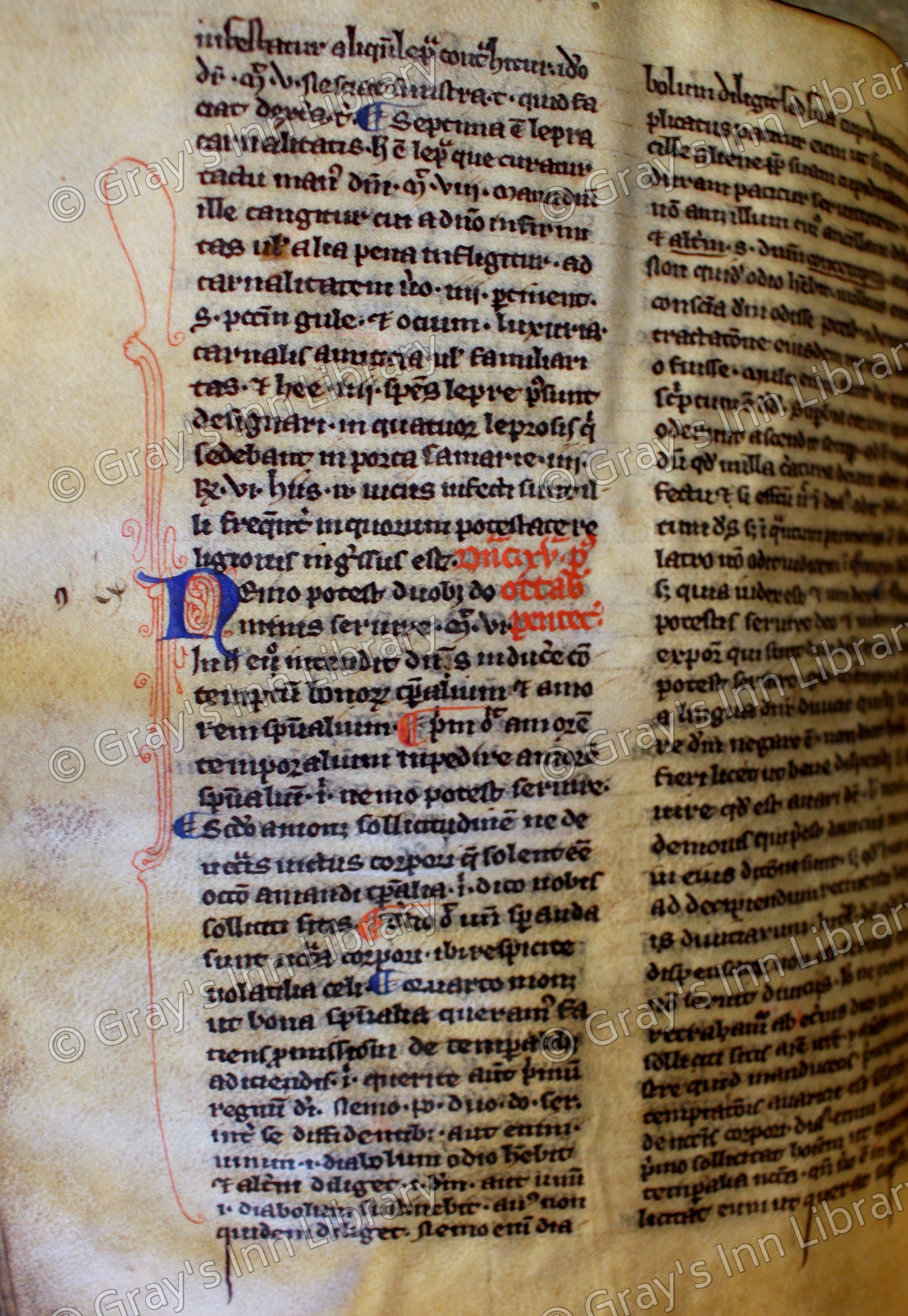
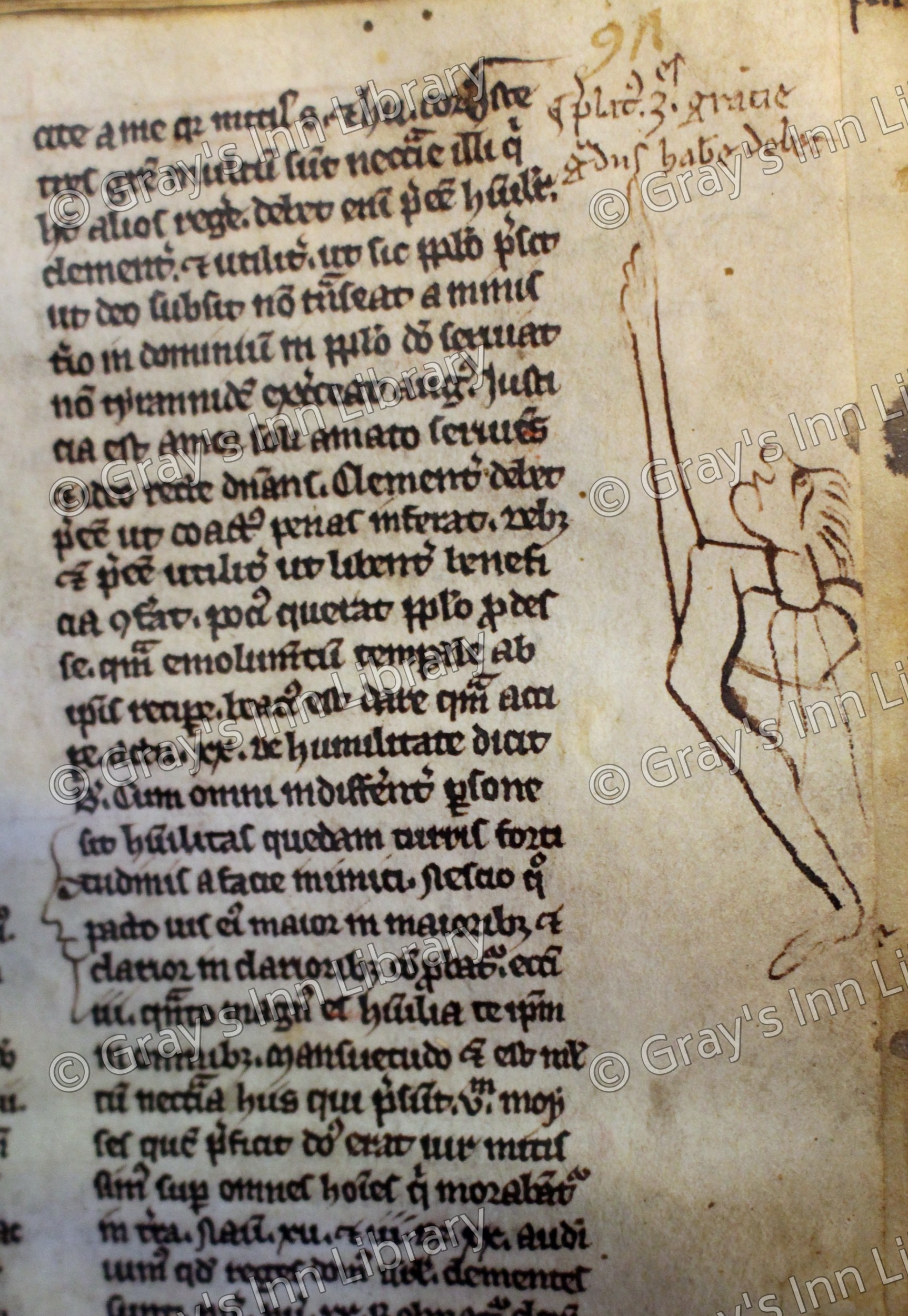
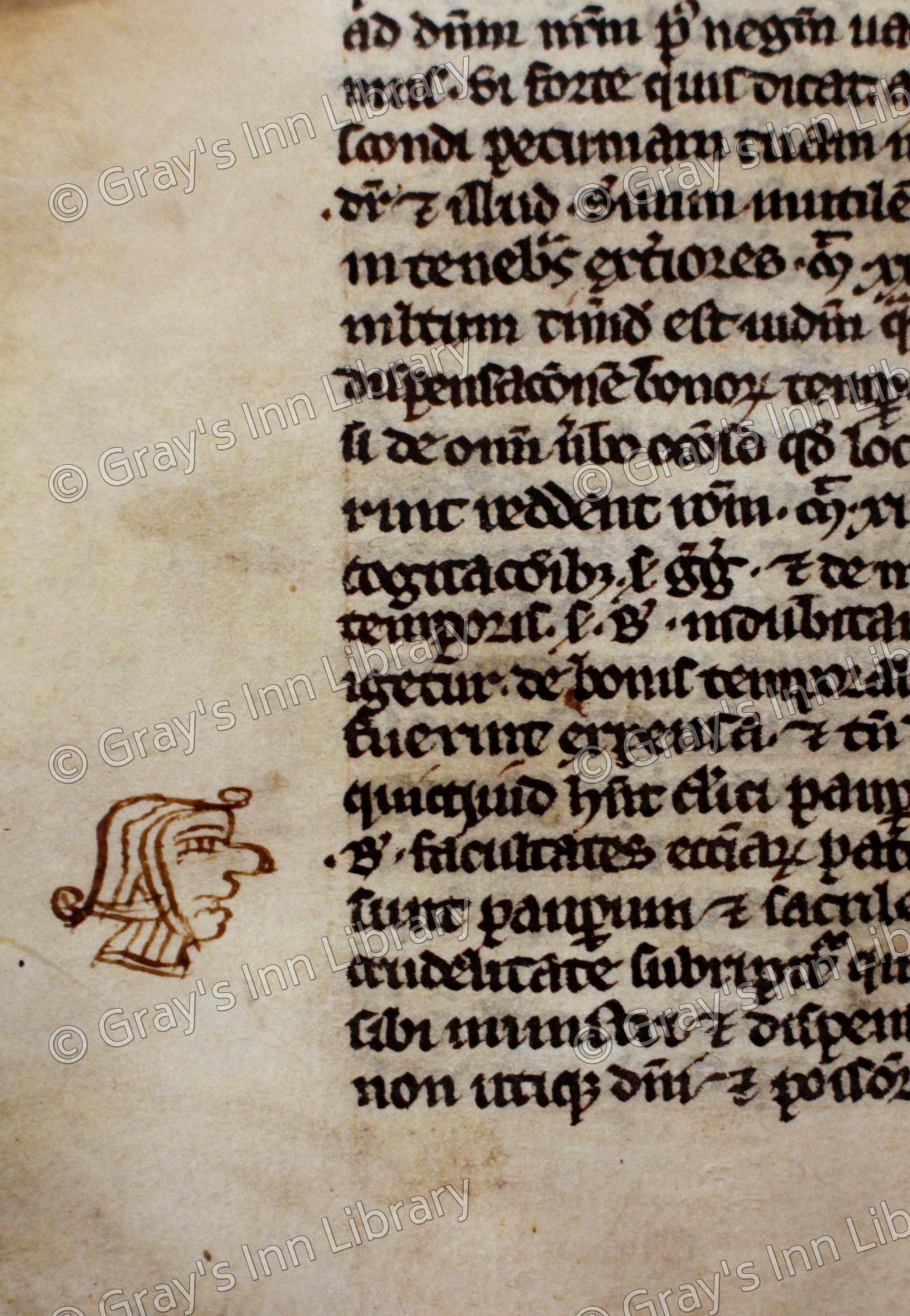 The leaf between the folios numbered 131 and 132 has been missed by the numerator, and folio 164 is wanting.
On the third vellum fly-leaf at the beginning the authorship seems assigned to Nicholas Waterton by the following inscription in writing (apparently foreign) of the 15th century. Expositio omeliarum dominicalium secundum Nicholaum Waterton episcopum lugdunensem.
On the verso of the folio numbered 227 is the following note:-.Hunc librurm contulat (sic) magister Johannes de Stoly presbiter et rector ecclesiarum de Twyford et Himede pro salute anime sue et omnium parochianorurn suorum deo et beate marie et communitati fratrum predicatorum de Sulbirie commorantium: qui fraudulenter quocunque genere alienacionis a dicta communitate alienaverit vel scriptum istum quocunque tempera preter suam conscientim deleverit ipso facto anathema est mairanatha, salvo tamen Johanni de Hundene sacerdoti et... si velit usu dicti libri suo duntaxat perpetuo. Actum anno domini mᵒ. coᵒ. lᵒ. sexto (1256) duodecimo Kal. marcii.
On the recto of the third fly-leaf at the beginning is the following inscription: Iste liber datur Johanni Reed vicario de Melburne et successoribus suis in Ecclesia beate marie imperpetuum per venerabilem presbiterum dominum Johannem Bredone quondam vicarium de Bredone anno domini 1514. Ita quod semper erit in custodia vicarii de Melburne ibidem residentis.
On the second fly-leaf at the beginning is a list of some of the sermons. The two vellum fly-leaves at the end are much damaged, having been formerly pasted to the boards. The first contains a fragment of the English romance of Sir Isumbras in writing of the 15th century. Very little is legible. The orthography is peculiar. The first two lines of one page are
The leaf between the folios numbered 131 and 132 has been missed by the numerator, and folio 164 is wanting.
On the third vellum fly-leaf at the beginning the authorship seems assigned to Nicholas Waterton by the following inscription in writing (apparently foreign) of the 15th century. Expositio omeliarum dominicalium secundum Nicholaum Waterton episcopum lugdunensem.
On the verso of the folio numbered 227 is the following note:-.Hunc librurm contulat (sic) magister Johannes de Stoly presbiter et rector ecclesiarum de Twyford et Himede pro salute anime sue et omnium parochianorurn suorum deo et beate marie et communitati fratrum predicatorum de Sulbirie commorantium: qui fraudulenter quocunque genere alienacionis a dicta communitate alienaverit vel scriptum istum quocunque tempera preter suam conscientim deleverit ipso facto anathema est mairanatha, salvo tamen Johanni de Hundene sacerdoti et... si velit usu dicti libri suo duntaxat perpetuo. Actum anno domini mᵒ. coᵒ. lᵒ. sexto (1256) duodecimo Kal. marcii.
On the recto of the third fly-leaf at the beginning is the following inscription: Iste liber datur Johanni Reed vicario de Melburne et successoribus suis in Ecclesia beate marie imperpetuum per venerabilem presbiterum dominum Johannem Bredone quondam vicarium de Bredone anno domini 1514. Ita quod semper erit in custodia vicarii de Melburne ibidem residentis.
On the second fly-leaf at the beginning is a list of some of the sermons. The two vellum fly-leaves at the end are much damaged, having been formerly pasted to the boards. The first contains a fragment of the English romance of Sir Isumbras in writing of the 15th century. Very little is legible. The orthography is peculiar. The first two lines of one page are
Hue shal bue qwene over all my lond
And alle men bowe to hure honde
No man w ᵗ stond hure steuene.
This leaf begins with line 240, and carries the tale to about the 360th line of the romance as printed for the Camden Society, but in a condensed form. The other fly-leaf contains a fragment in verse of an English legend headed Anastasia, and beginning -[Anast]asie was ybore at rome by olde days. Taken from 'A Catalogue of the Ancient Manuscripts Belonging to the Honourable Society of Gray's Inn' by Alfred Horwood, published 1869. Make a request to view this manuscript.Manuscript 21
Bracton (Henricus De). Liber De Legibus Et Consuetudinibus Angliæ
- Late 13th / early 14th Century
- 241 leaves of parchment
The first eleven folios are occupied with a full table of contents according to the rubrics. The leaves of this table are numbered at the foot in Roman. numerals; the leaves of the text are numbered at the top with Arabic figures.
Begins folio 1a - Incipit liber Domini Henrici de Bratone...
Folio 1a - Incipit liber primus Henrici de Brattone, &c.
Primum capitulum, Que sunt regi necessaria, &c.
Text begins - In rege qui recte regit...
Ends folio 230a - Sive inde preceptum habuerit sive non.
This work has been twice printed : fol., Lond. 1559 ; and 4to, Lond. 1640.
This MS. is divided into 4 books (not 5, as in the printed editions).
The 1st book ends on folio 58b, with the end of the 8th chapter of the 3rd book, folio 107a of the printed text. The 2nd book begins with chapter 9 of the 3rd book, folio 107a of the print, and ends with the 2nd chapter of the 7th treatise of the 4th book, folio 161a of the print.
The 3rd book begins with chapter 3 of the 4th book, folio 161a of the print, and ends with chapter 8 and last of the 7th treatise of the 4th book, folio 327b of the print.
The 4th book begins with the beginning of the 5th book of the print, and ends as does the 5th book of the print.
At the bottom of the second column of folio 206a of the manuscript is the following rubric - Incipit liber secundus Xᵒ libro pertinens de jurisdictionibus et de his que pertinent ad forum seculare et ad forum ecclesiasticum, diversis prohibicionibus, et de brevi quod dicitur Indicavit, de minoribus infra etatem existentibus et de warrantiis diversis, de excepcione bastardie et aliis diversis excepcionibus et de quibusdam rebus communibus inter vicinos, et aliis ut supra in Kalendariis.
(It may be suggested that the scribe wrote the Roman numeral X (at the beginning of this rubric) instead of the (old form of the) Arabic numeral 4.)
The text of this so-called Liber secundus begins - Est autem jurisdictio, which begins chapter 2 of the 5th treatise of the 5th book, folio 400b of the print.
There is a deficiency in this manuscript. The scribe has evidently, by accident, passed over an entire quire of what was given to him for copying. The 17th line of the second column of folio 127b reads thus - vel stricte: si autem plures fructuarium rabbit impetracio. On reference to the printed text (and the table at the beginning of the manuscript), it will be seen that all between the word plures at line 2 of folio 230a of the print, and the word firmarium, at the last line but three of folio 261a of the print, is wanting; and a cursory examination of the manuscript has not led to the discovery of the missing portion in any . other place, This hiatus is to be regretted. It would be desirable to know if the manuscript which the scribe had to copy did or did not include that passage of chapter 2 of treatise 3 of book 4 (folio 253 of the print) which refers to a change in the form of a writ consequent on the succession of Edward I. to the throne.
On the back of folio 230, and also on the parchment fly-leaf which follows, is the autograph of John Godbold, Recorder of Bury St. Edmund's, and Serjeant-at-law, and a member of this Inn, who, according to a printed paper under a horn plate on the cover, gave this volume to the Society in the year 1635. There is no evidence of earlier ownership, although in the 1st page, and in folio 230a of the volume, there are traces of older names which have been defaced.
Taken from A Catalogue of the Ancient Manuscripts Belonging to the Honourable Society of Gray's Inn by Alfred Horwood, published 1869.
Manuscript 22
St. Gregory's Homilies, forty in number
- 15th Century
- 142 leaves of parchment
- 1st leaf, containing the Prologue and part of table, is absent
Folio 1a. A part of the table of contents, beginning with the 12th homily.
Folio 1b. The first homily begins.
Folio 135a. The last homily ends.
Folio 135b-142a contain an index.
These homilies are well known, and have been often printed. But they are not always placed in the same order.
Taken from A Catalogue of the Ancient Manuscripts Belonging to the Honourable Society of Gray's Inn by Alfred Horwood, published 1869.
Manuscript 23
The Distinctiones of Robert Grostête (Bishop of Lincoln from 1234 to 1253); and other works mentioned below
- Early 15th Century
- 191 leaves of parchment
There are 4 old parchment fly-leaves at the beginning, on the last of which a hand of the end of the 16th century has written, " Opera Grostesti olim Lincolniensis Episcopi."
I. Distinctiones
A series of words and short sentences in alphabetical order, with amplifications and illustrations, scriptural and physical.
Begins folio 1a - Abeuntium per hunc mundum alii abeunt male et alii bene abeunt.
Ends folio 143a - Et ideo ante diem obitus preparemus nos ut preparati intremus ad nupcias cum domino Jesu Christo. Amen. Explicit expliciat, ludere scriptor eat.
Folio 143b and part of folio 144a are occupied with a table, in alphabetical order, of the word which is the subject of each section.
II. Dieta Salutis
Rules and advice for the journey through life, divided into eight days.
Begins folio 143a - Hec est via, ambulate in ea, nec ad dextrum nec ad sinistrum, &c. Ysa. xxx.
Ends folio 178b, column 2 - Omnes enim peccaverunt et egent gloria dei quœ est infinita, ad quam gloriam nos perducat et particeps efficiat ductor illius choree Jesus virginis Marie filius, cui cum deo patre et spiritu sancto (&c., the usual formula). Amen. Explicit.
This treatise is usually assigned to St. Bonaventura, who lived in the 14th century: it has been often printed.
III. Folio 178b. Rubric - Incipiunt Themata Dominicalia. Dominica prima adventus.
These are texts for the Sundays in the year, each followed by a few sentences intended apparently for a skeleton of the sermon.
Begins - Abjiciamus opera tenebrarum.
Ends folio 181a - 2ᵒ debemus in corrupcione esse decori; quare in materia de castitate et luxuria per contrarium.
IV. De venenis peccati (by Robert Grostête, Bishop of Lincoln: another copy is in No. 18, ante).
Begins folio 181b - Ratio veneni potissime convenit peccato.
Ends folio 190a (top of column 1) - Et hoc habet ipsa pro maximo aliis derelictis.
he remainder of the column is occupied with what seems part of the tract entitled "De defectibus occurrentibus (or 'de periculis contingentibus') in celebratione Missæ," gathered from St. Thomas Aquinas.
Some of the bottom text of the last twelve leaves has been damaged by water, and some wholly destroyed.
Taken from A Catalogue of the Ancient Manuscripts Belonging to the Honourable Society of Gray's Inn by Alfred Horwood, published 1869.
Manuscript 24
Biblia Latina. (Old and New Testaments and Apocrypha.)
- Late 13th / early 14th Century
- 403 leaves of velum
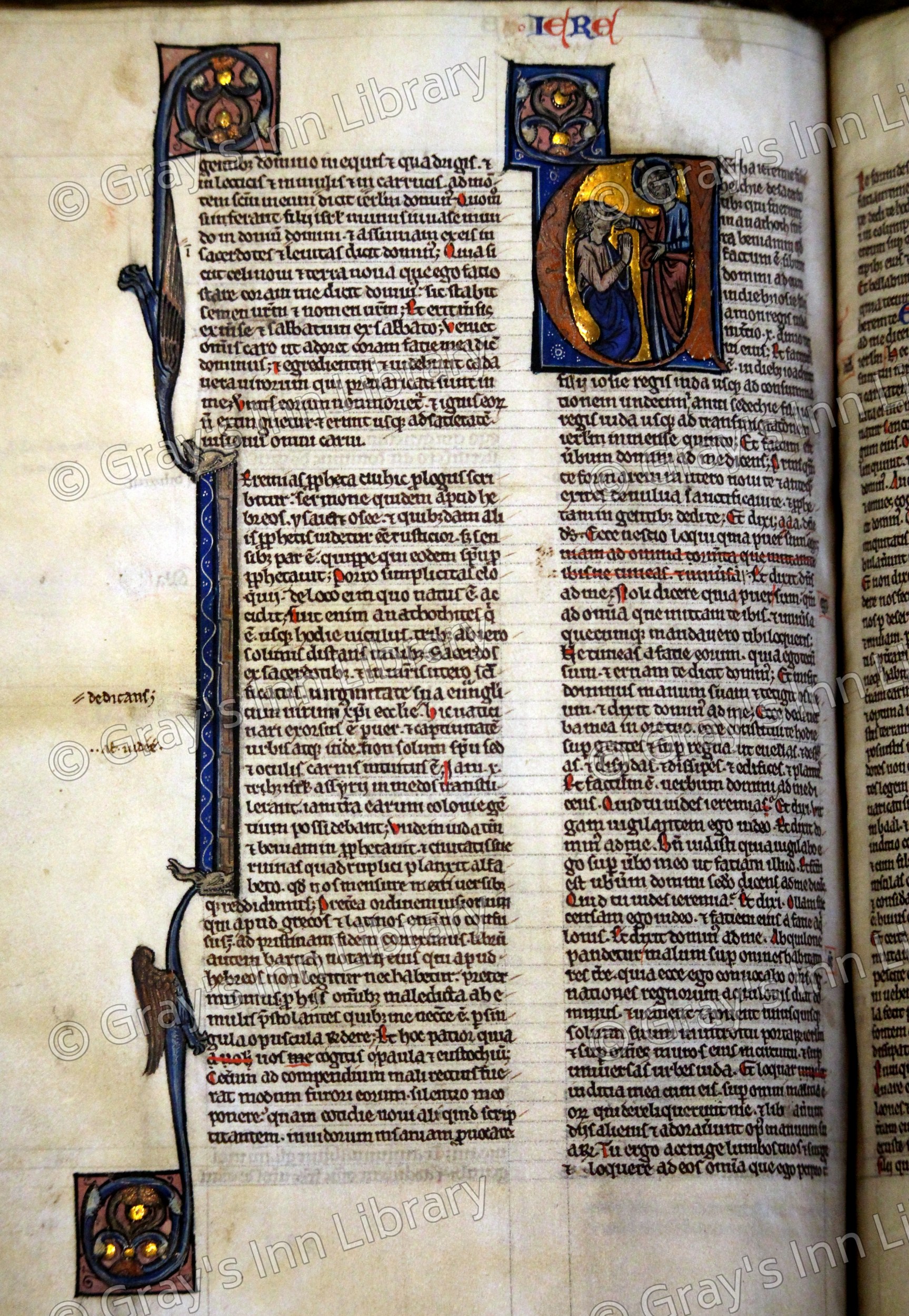
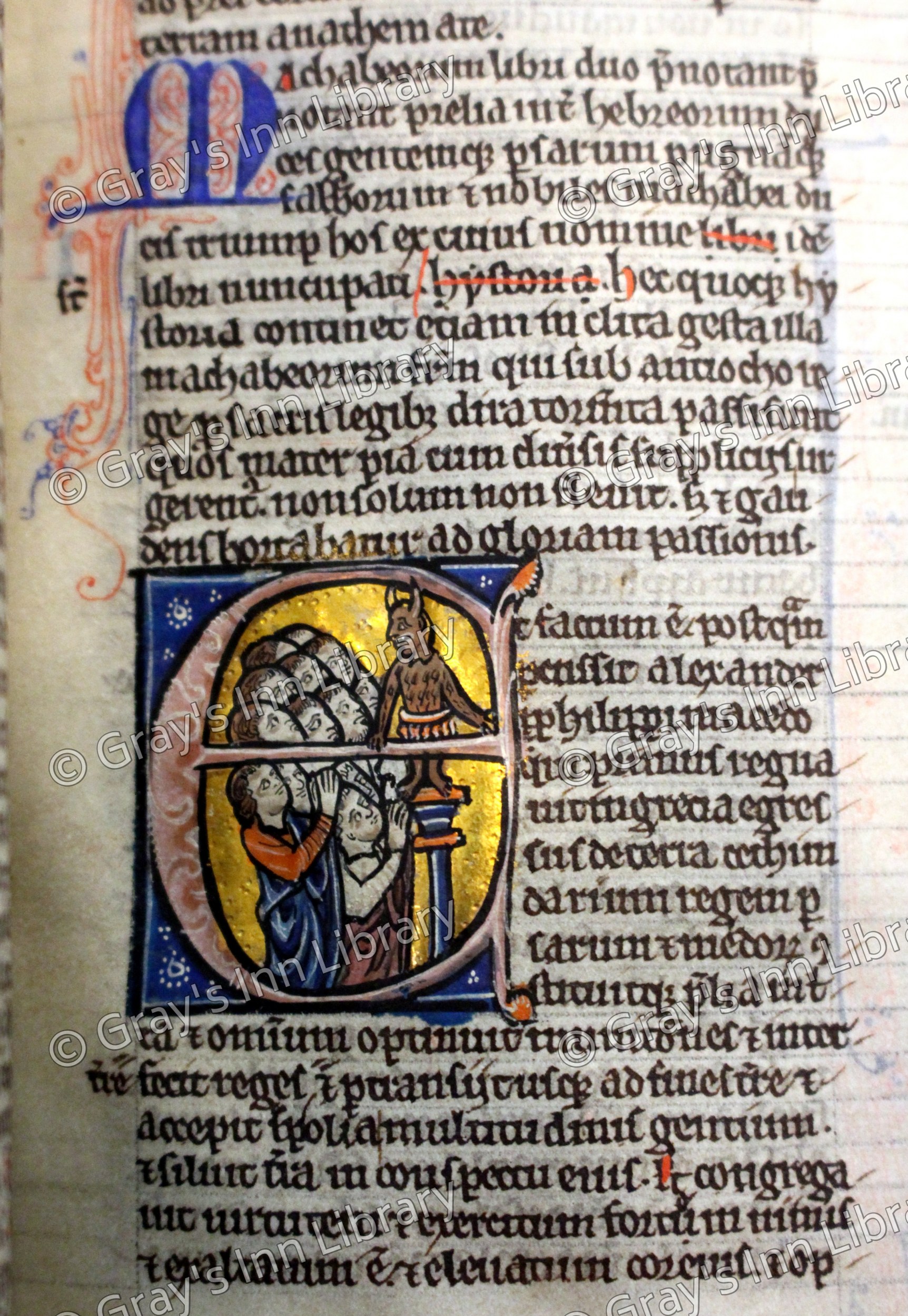
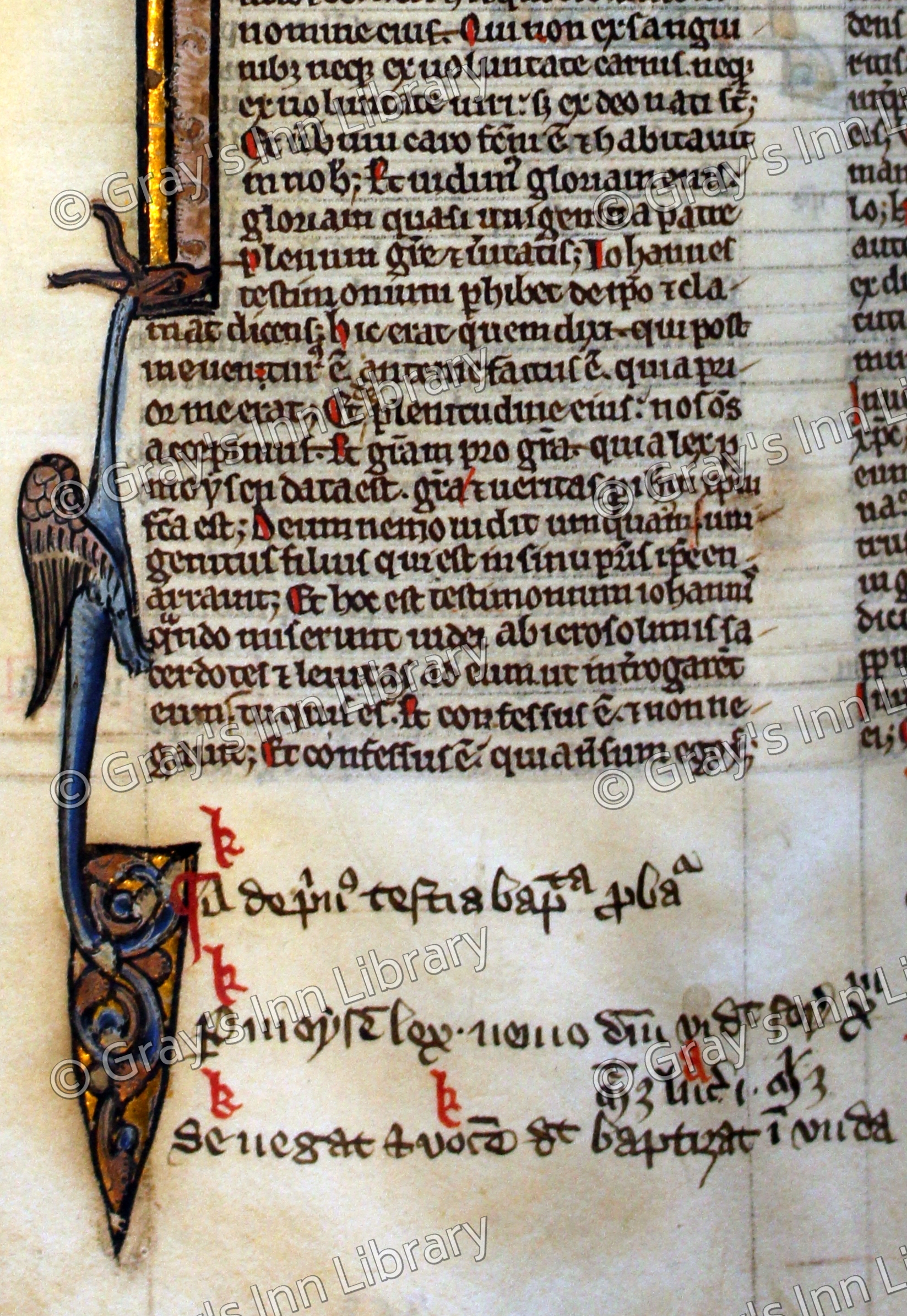 Begins in the middle of the 27th chapter of Genesis.
There are various imperfections in the volume. The last two leaves are occupied with the commencement of interpretations of the Hebrew names. There are a few illuminated initial letters.
Taken from 'A Catalogue of the Ancient Manuscripts Belonging to the Honourable Society of Gray's Inn' by Alfred Horwood, published 1869.
Make a request to view this manuscript.
Begins in the middle of the 27th chapter of Genesis.
There are various imperfections in the volume. The last two leaves are occupied with the commencement of interpretations of the Hebrew names. There are a few illuminated initial letters.
Taken from 'A Catalogue of the Ancient Manuscripts Belonging to the Honourable Society of Gray's Inn' by Alfred Horwood, published 1869.
Make a request to view this manuscript.
Manuscript 4
Florarium Bartholomei
- 14th Century
- 333 leaves of parchment
- Due to a mistake by the scribe, the numeration goes to 347
- The last four leaves have been placed by the binder in the wrong order
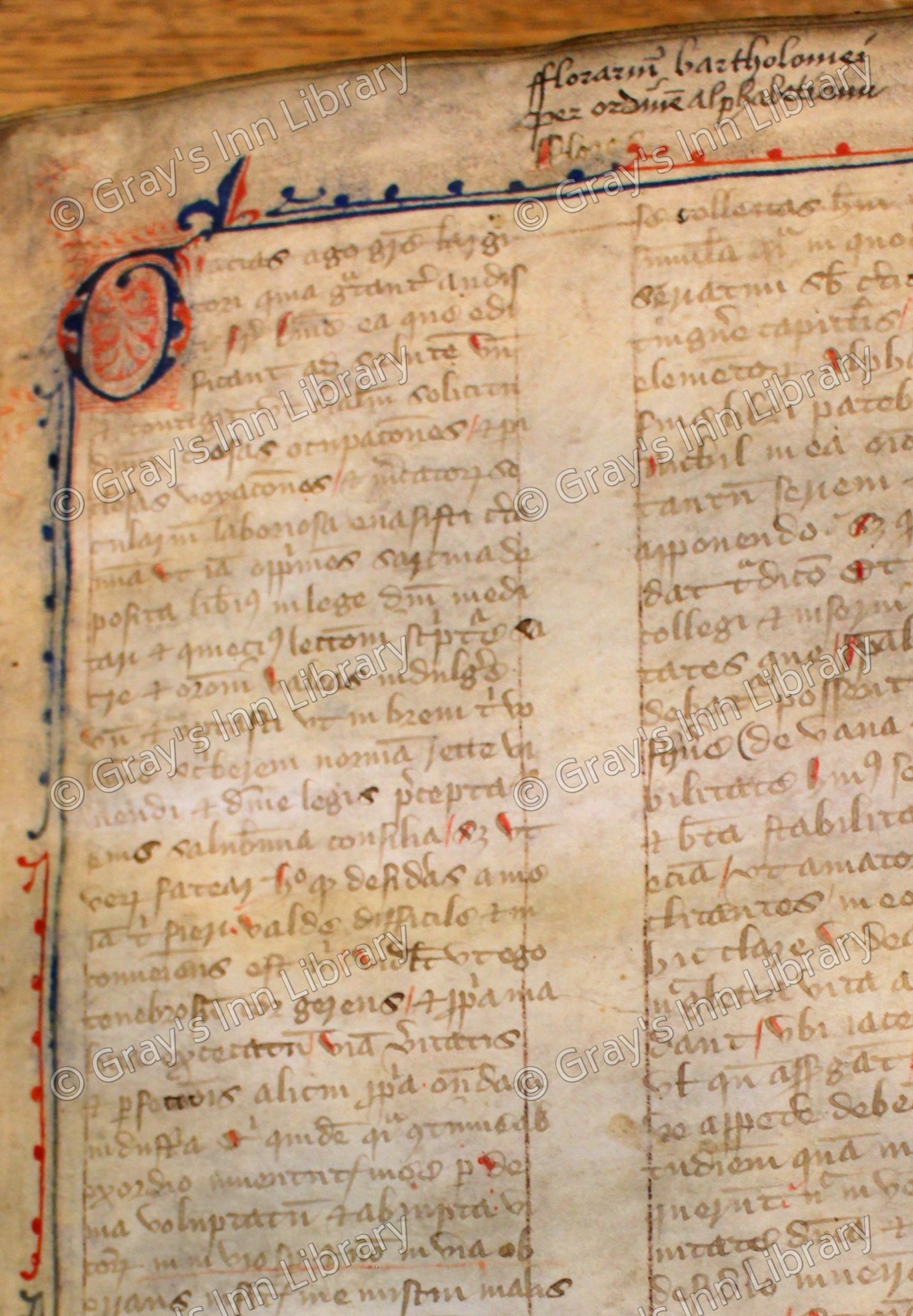
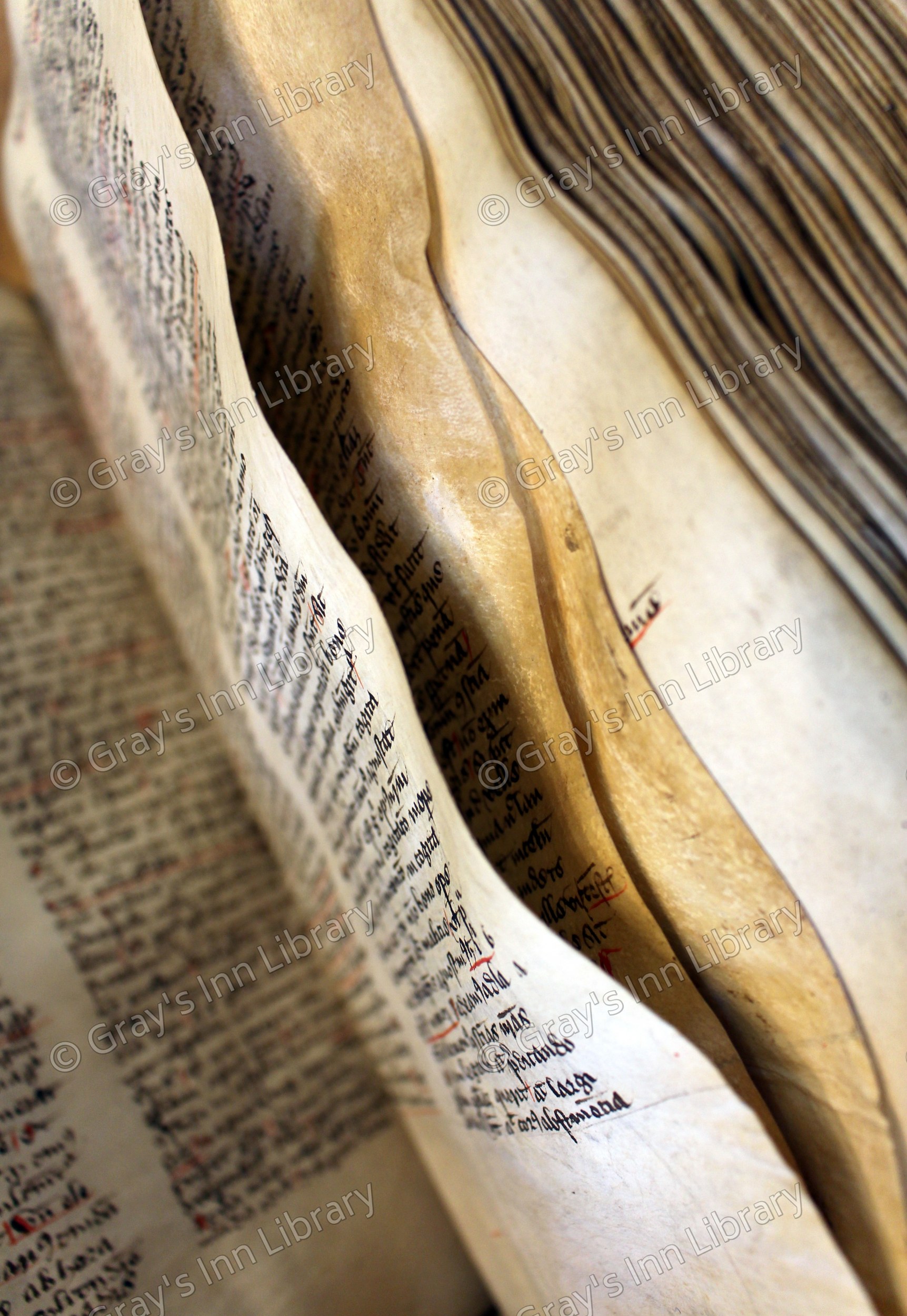
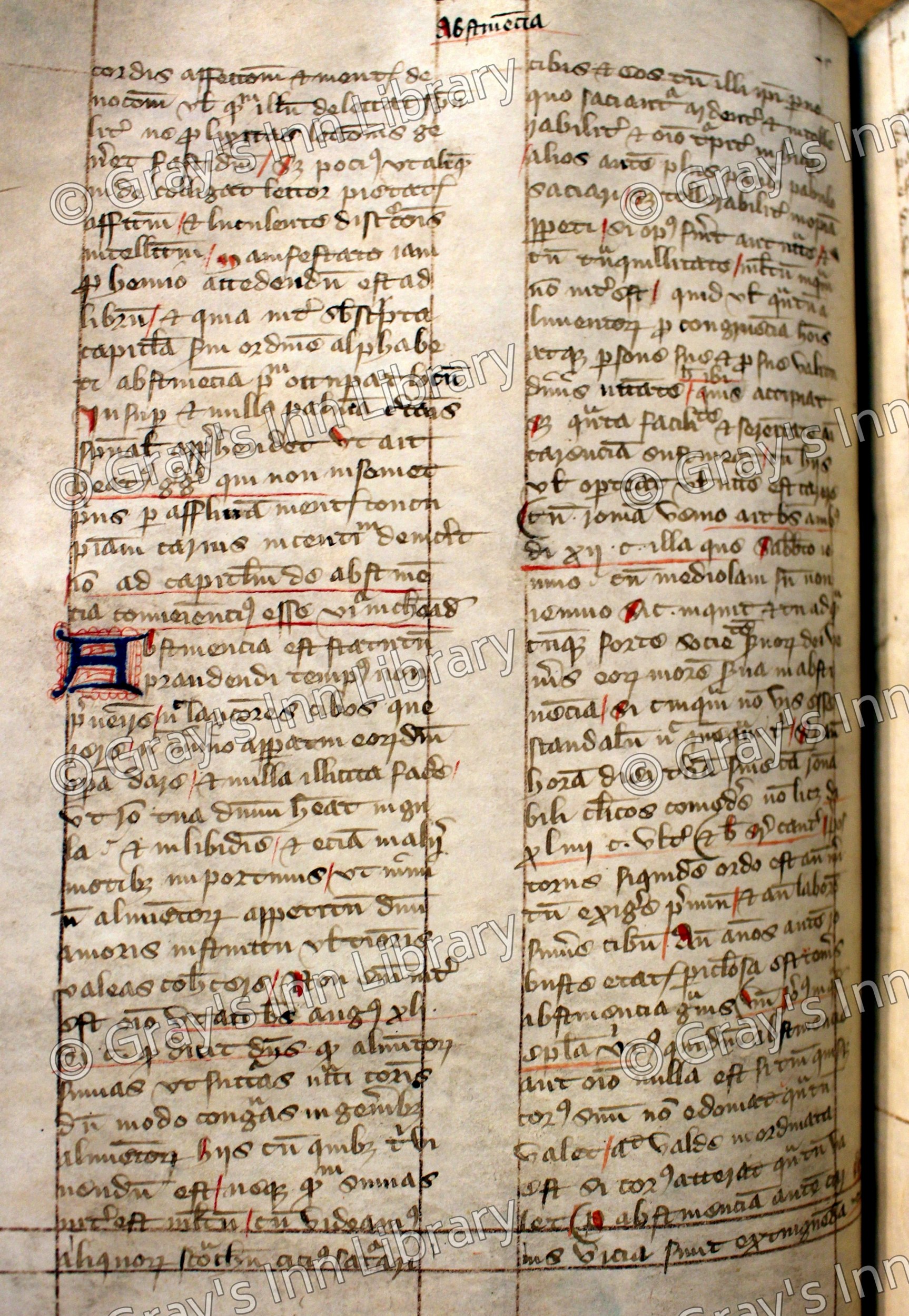 Begins - Gratias ago gratie largitori, quia gratanter audisti, frater karissime, ea que...
Ends - Imperium per infinita seculorum secula, Amen. Explicit liber qui intitulatur Florarium Bartholomei; deo gracias. Opere completo sit laus et gloria Christo.
Begins - Gratias ago gratie largitori, quia gratanter audisti, frater karissime, ea que...
Ends - Imperium per infinita seculorum secula, Amen. Explicit liber qui intitulatur Florarium Bartholomei; deo gracias. Opere completo sit laus et gloria Christo.
Ad I.H.S. incipias capitula, non aliunde;
Tunc quo vado scias venio tibi lector et unde.
(And in a smaller and different hand)Ad I.H.S. accipies capitales, et inde notabis
Tunc quo vado scies venio simul unde probabis.
These two verses point to the name of the author; and the initial capital letters, commencing at folio 164a, with the article Jesus, and ending on the last folio, give the sentence, Johanni de Suthuuelleo per ighannem de merfeld; ora pro nobis, beate Bartholomee, ut digni efficiamur pro missionibus Crmisti. Amen. Expliced. If the round first capital G be read as an O, this sentence will be read as Johanni de Suthuuelleo per Johannem de Merfeld, &c. The letter m in the Crmisti must be rejected, and the last word should be read explicit. The name of John de Suthwelle does not occur in Tanner, Cave, or Oudin, nor does the name of John de Merfield. The author says in the exordium, at folio 1, that, at the request of the person whom he addresses, he had compiled the work from the best and most remarkable passages in the Scriptures and the treatises of Catholics which he could find. He tells why he calls the work Florarium, but declines at present to say why he adds Bartholomei. He adjures the person addressed to mention to no one the name of the author, but begs him to examine the work, correct errors, make necessary additions, and reduce it to better order, before publication to the many. The subjects are in alphabetical order, beginning with Abstinentia, and ending with Votum. Theological and moral comments are attached to each. Before folio 1 is a paper leaf containing a list of the subjects. At the beginning of the volume are three old vellum fly-leaves. The first is part of a Colchester Court Roll, of the latter end of the 14th century. The writing on the recto is damaged; on the verso are the records of three pleas of debt, and one of trespass. The verso of the second and recto of the third fly-leaf contain a list of subjects in the volume. Taken from 'A Catalogue of the Ancient Manuscripts Belonging to the Honourable Society of Gray's Inn' by Alfred Horwood, published 1869. Make a request to view this manuscript.
